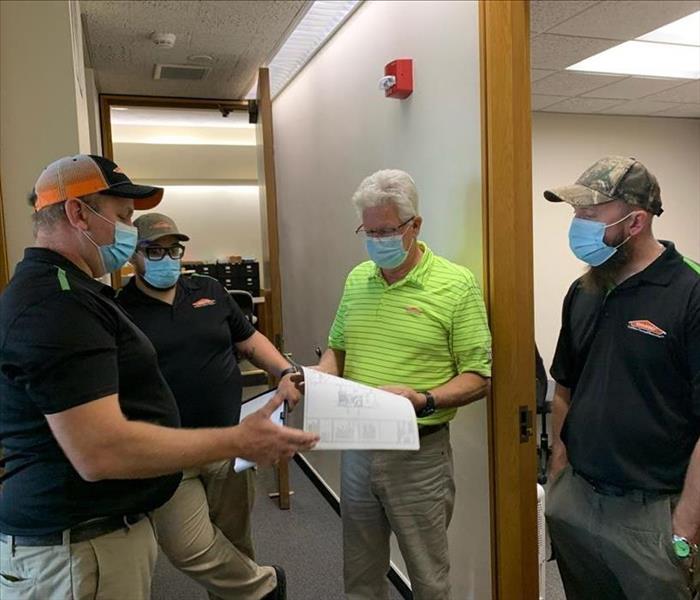Archived Blog Posts
There was a fire next door. Should you worry?
8/5/2022 (Permalink)
A house fire, especially a serious one, can be a really terrifying thing.
Within a very short timeline, your home can go from a safe, comfortable place to a dangerous, uninhabitable environment.
What many people don't realize is that house fires affect more than just the houses where they start.
Smoke, soot and other forms of damage can easily affect neighboring homes as well.
As smoke pours out of the source unit, it doesn't necessarily just go straight up into the sky. It can migrate to nearby structures, get blown around, and cause serious secondary damage throughout the neighborhood.
Often, this damage is most pronounced in the form of odor. Even when the restoration is totally complete on the source unit, neighboring people may notice that they still detect a smoke odor in their own homes.
Sometimes, this is psychological - they're so used to smelling smoke that they can't shake it. But often, it's a sign that the neighboring home may need some level of cleaning and restoration as well.
How common are cooking fires?
8/5/2022 (Permalink)
Every single day, fire departments respond to a wide variety of emergencies in the communities that they serve.
Out of all of the fires that they respond to, the bulk will be cooking fires.
Kitchen fires are by far the most common types of fires that occur in the United States and throughout the world. It's no surprise as to why - we use our kitchens every single day, and we're usually using some form of heat or open flame to cook food.
If something goes wrong, the consequences can be deadly.
According to the National Fire Protection Association, there were over 172,000 fires caused by cooking in the US from 2014 - 2018. These led to over $1 billion in property damage and around 550 deaths.
Why do things go wrong in the kitchen? Usually, the culprit is not paying attention. Unattended cooking fires are the bulk of the problem.
Why is it important to pick up debris after a storm?
8/5/2022 (Permalink)
Storms of all types can wreak havoc on your property in all kinds of way.
Flooding and water damage are urgent problems that must be dealt with immediately. Lightning strikes can lead to trees falling and fires starting.
These are massive, flashy problems that most people are aware of. Not as many people are aware of the risks that something as simple as storm debris can pose, though.
After all, picking up debris is a chore, and it's your yard anyway, right?
Maybe so, but that debris can be deadly in the wrong conditions.
Storms typically bring high winds along with them. These high winds, on their own, generally don't pose too much of a threat to a person or their property.
But when these winds pick up debris, like rotting or fallen trees or even displaced gravel, things can get serious quickly. These forms of debris become projectiles.
So after a storm, and especially before a storm, make sure you clear your property!
What can a storm do to your roof?
8/5/2022 (Permalink)
Storms can be incredibly damaging events for homes throughout the Western New York region, and one of the major flash points for damage is the roof.
Your roof is built to withstand the elements on a routine basis. But a storm is anything but routine. High winds, huge volumes of precipitation and falling debris can all cause serious damage to your roof.
After a storm, you should keep a look out for common forms of damage.
Water stains, for instance, can begin to form on your ceiling and are sometimes the first indication that your roof has been damaged and begun to leak. If they show up quickly, that means that the leak is probably pretty serious and you need to deal with it right away.
Shingles are also a telltale indicator of roof damage. If you notice missing or loose shingles, you've obviously got a problem. But even discoloration can be a sign of an issue, as it often indicates damage from hail or debris.
Why do you "flood cut" a wall?
8/5/2022 (Permalink)
After a major water intrusion in a home, it's incredibly important to react quickly and comprehensively to remove the water and dry the structure out.
If you react immediately and are able to extract or remove the water after turning off the source, then the level of mitigation and restoration that you need might be minimal. A little bit of air movement and dehumidification may do the trick.
However, if that water is allowed to sit and wick up your walls, then you might have a bigger problem on your hands.
After all, how do you dry out water that's already inside the wall cavity?
This situation happens all the time, and it's why we perform "flood cuts" relatively often on bigger water damage projects. If we're not called in until after the water has gotten behind the wall, then we're forced to open up the wall to dry it.
How do I extract water on my own?
8/5/2022 (Permalink)
If you have a water damage event in your home, then you have a very limited timeline to stop it, mitigate it and stabilize the environment before it spirals out of control.
While SERVPRO is always quick to respond, it still takes some time for us to dispatch to your home after a water intrusion. Anything that you can do to mitigate the damage on your own before we get there is extremely helpful and will save you time and money on the restoration.
Extracting water should be one of your top priorities. There are many ways that you can extract with items that you already have in your household.
Obviously, if you have a vacuum that is capable of vacuuming up liquids or wet materials (like many Shop-Vacs are), this can be a great tool.
But even throwing down some towels to soak up water and prevent it from reaching vulnerable or high value areas is super effective.
We're your 3D building scan partner!
8/5/2022 (Permalink)
At our location, we've recently invested in a state-of-the-art panoramic, 360-degree 3D camera, and the software to go along with it.
This camera is high-powered yet extremely easy to use, producing scans of entire rooms in just a few presses of a button.
Why did we buy this camera? We use it to document projects and create estimates that are more comprehensive than anything that's ever come before.
How can you use this camera in your commercial building? Any way you want!
As your partner in all things emergency preparedness, we're happy to come to your building and produce a scan of the entire property at no cost.
By pairing this scan with one of our sought-after Emergency Ready Plans, you'll be prepared for any emergency.
You can also use the scans to help you to market and promote your building - it's a win-win if you ask us!
What is wind and hail insurance?
8/4/2022 (Permalink)
In the United States, the most common and frequent homeowners claim is not simple water damage: it's wind and hail coverage.
Here in Western New York, you might find that surprising. While we definitely have strong winds, we don't see much hail, and you don't often see people putting in claims for wind and hail.
So what is wind and hail insurance? And why are these claims so frequent?
Wind and hail insurance can go by many names: windstorm insurance, hurricane insurance and even tornado insurance.
Much like flood insurance, it is usually a separate type of coverage distinct from your run-of-the-mill homeowners policy.
But if you live on or near a coast, wind and hail coverage is a necessity. It may even be required as a stipulation to getting a mortgage.
After all, imagine if you didn't have wind and hail coverage and a major hurricane blew through. Your entire home could be destroyed, and you could be left paying the bill out of pocket.
What if a storm makes your roof leak?
8/4/2022 (Permalink)
Roof leaks can range from minor annoyances to major hazards.
When they aren't that serious in the moment, though, many people are tempted to ignore them. Why worry about about a roof that only leaks once or twice per year?
The truth is that roof leaks can lead to all kinds of problems that can affect you long after the initial rainfall ends.
Mold is a prime example. If water infiltrates your home after a minor roof leak, it doesn't just go away. It can become the X factor that leads to serious mold and microbial growth which might be hidden behind walls.
Wood rot can also set in. The wood inside your home, like your framing, is not treated the same way that outdoor wood is and is not meant to get wet. Over time, if it gets wet, it can begin to rot and lose integrity.
So if you have a roof leak, don't write it off - dry out your home and get the leak fixed ASAP.
What is Firematic racing?
7/14/2022 (Permalink)
If you’ve lived in Western New York for a little bit, then you’ve probably seen signs or heard advertisements for something called “Firematic” racing.
Many people from out of town, and even many people right here in the Buffalo area, have never heard of this type of competition.
Apparently, it’s vastly more popular in New York state than anywhere else in the world – who knew?
But what actually is Firematic racing? And who can get involved?
Firematic racing (sometimes also referred to as drill team racing) is a competition between firefighters, usually from different fire companies.
The competitions are designed to test the participants’ firefighting acumen by putting them through a series of firefighting drills, usually for time.
Usually, there’s a distinction between two types of competitors: old-fashioned and motorized.
Old-fashioned competitors will complete the drills on foot, and to the extent that they use any specialized equipment at all, it’s all under manual power.
Motorized competitors, on the other hand, take full advantage of modern technology and often use specialized Class-B or Class-C “racer” trucks.
Despite the difference in technologies, both divisions usually compete in similar events that involve running and operating fire hoses, placing ladders, and the “Bucket Brigade,” a race to use buckets to fill a large drum.
Why is odor so persistent after a fire?
7/14/2022 (Permalink)
When most people think of the consequences of a serious fire, they probably think of total destruction: charred, burnt-out structures that have caved in on themselves with very little left to save.
In reality, most fires are not total destructive losses, and restoration is possible. While the restoration process is not simple and can sometimes take years to complete, the end result is a home restored to preloss condition in an efficient and cost-effective way.
Despite the fact that the home might look basically like new, however, there’s one problem that has a tendency to linger in many people’s minds: the odor.
Smoke odor is a difficult thing to eliminate. On one hand, soot can be invisible to the naked eye and can potentially settle anywhere and everywhere inside a structure.
Often, though, people will complain of an odor even after soot has been eliminated.
The issue is in our brains. Smell is the sense that’s most closely associated with memory, and if we walk into a structure with that memory on our minds, or if we expect to encounter the smell of smoke, then we’re very likely to think that we detect an odor, even when nobody else does.
Our goal when we clean smoke and soot, then, is not only to eliminate the source of odor, but to provide an environment that feels clean, inviting, and odor-free.
Why are there categories of water damage?
7/14/2022 (Permalink)
Most industries share a common lingo and lexicon that allows them to communicate with accuracy and nuance about the specialized things that they deal with every day.
The water restoration and mitigation industry is no different. Restorers have all sorts of different ways to quickly communicate the pertinent details of a water damage situation and figure out what to do next with only a handful of words.
This is why you may hear water damage restoration providers refer to different “categories” of water. Water damage has been broken down into separate categories so that restorers have shorthand for referring to different levels of contamination, and a rubric for dealing with them.
That said, water category is not exactly a scientific term and it is not set in stone. In fact, the category of water can change drastically as environmental conditions change or certain things happen. Clean water that runs through an asbestos-containing wall, for instance, can easily become contaminated and change category.
What is category 1 water damage?
7/14/2022 (Permalink)
If you were able to listen in on a private conversation between two water damage professionals, chances are you might not be able to even follow what they’re talking about.
Our industry has so much insider knowledge and shared, specialized lingo that it can sometimes be difficult for the average person to follow.
Take, for example, the concept of “category 1” water damage.
Water damage categories refer to the level of contamination in the water itself. They go from 1 to 3, ascending as more contamination is added.
By that logic, category 1 damage is the least contaminated. In fact, by definition, category 1 water is “clean water” and should actually be drinkable.
That doesn’t mean you’d actually want to drink it. The most common sources of category 1 water include water from toilet supply lines and burst pipes.
That said, if you have category 1 water damage, it could be much worse. With clean water, you have the best possible chance of drying and salvaging your structure and contents in a safe and sanitary way.
What is category 2 water damage?
7/14/2022 (Permalink)
Every industry has its own language. Computer programmers talk about “syntax” and programming languages with ease, even if their conversations are totally inscrutable to others. Healthcare is full of scientific terms and enough acronyms to make your head spin.
Water damage restoration is no different. Among other things, restorers have developed a common language to describe the level of contamination in water using a system of “categories” numbered 1 to 3.
Today, we’ll cover category 2 water damage. What is it and how bad can it be?
Category 2 water is sometimes referred to as “gray water.” In terms of contamination, it’s right in the middle and can sometimes be the most difficult category to define. Technically, the amount of contamination is said to be “significant” but not enough to qualify as category 3.
Examples include water leaking from a dishwasher and water from a toilet that has been flushed.
Because of the level of contamination, category 2 water damage will likely involve a significant amount of porous material removal.
What is category 3 water damage?
7/14/2022 (Permalink)
Today, we’ll be talking about the third and final category of water: category 3 water damage.
Water “categories” are used by restoration professionals to quickly identify and communicate the level of contamination in water. These categories are not usually determined by any kind of scientific test (though such tests do exist) but instead are highly-educated guesses based on the source of the water and the materials that it has passed through.
Category 3 water is sometimes referred to as “black water” and is the most contaminated category that exists. It is considered to be “grossly” contaminated with harmful bacteria, viruses and pathogens that could cause serious health problems, even death, if they were to be ingested.
The most common source of category 3 water in the home is sewage. A sewage backup can contain not only the sewage itself, but also whatever pollutants, chemicals and harmful materials that were picked up as the sewage traveled through the sewer.
Category 3 water damage leads to the highest ratio of demolition and material removal, as many things can simply not be effectively cleaned and sanitized after exposure.
Duct cleaning after a fire
6/21/2022 (Permalink)
One of the last steps that we often take after a fire is cleaning the air ducts. It’s often the finishing touch after a lengthy, in-depth fire and smoke restoration project that makes the home or business safe to inhabit again.
Why do we always clean the ducts?
Your HVAC system is the most efficient transporter of smoke, soot and residue in your home. It takes in air and circulates it all throughout the building, and it just isn’t up to the task of filtering out the harmful environmental pollutants that are created by your average house fire.
This goes double if you inadvertently operated the HVAC system after the fire. Without realizing it, you spread those pollutants all over your home, and all throughout your duct system.
Because of these reasons, and many more, we have specialized duct cleaning equipment in-house that we use to keep you safe. We’re always here to help!
Why do lithium-ion batteries start fires?
6/21/2022 (Permalink)
You’ve probably seen in the news plenty of reports of lithium ion batteries exploding or catching fire without warning.
To a degree, these reports are misleading. The vast majority of lithium ion batteries are safe and will never cause you any problems.
But that doesn’t mean that there’s absolutely no risk, either. Here’s why.
Inside every lithium ion battery, there are two electrodes. One is positively charged and one is negatively charged, and they are separated by a very thin piece of plastic. The reaction between these two electrodes, the other components and the electricity flowing through the battery is what gives lithium-ion batteries such incredible storage and recharging capacity.
But it’s that same technology that also gives them the capacity to explode. If the plastic separator fails, then all of the energy stored in the battery gets released in a single jolt when the electrodes touch. That leads to a huge discharge and potential disaster.
Again, these batteries are getting safer and more effective every day. But it’s interesting to note that what makes them so effective is also what causes fires.
When disaster strikes a school
6/15/2022 (Permalink)
A few months ago, National Public Radio published an article that should concern any school facilities manager.
The article, entitled “This school wasn’t built for the new climate reality. Yours may not be either,” is available here: https://www.npr.org/2022/03/21/1084912552/climate-change-schools
In the article, NPR journalist Anya Kamenetz tells the story of New Jersey’s Cresskill Middle/High School.
Her reporting starts on September 1, 2021, just a few days before the school was set to re-open for in-person learning after COVID-19 lockdowns.
Unexpectedly, a massive rainstorm – the remnants of Hurricane Ida – unleased seven inches of precipitation on the school in the matter of hours.
Due to a flaw in the school’s ventilation system, that rain poured into the building itself. The entire school was totally flooded, with one teacher describing the auditorium as “an aquarium” and some staff members becoming trapped within the structure overnight.
Inspectors valued the loss at $21.6 million dollars, far above the school’s flood insurance payout cap of $2 million. FEMA would reimburse the school for some of the costs of the repairs, but the school would need to front the money first.
By the time of writing, the school building had still not re-opened and repair funds were only just starting to come through.
What’s the lesson here for schools? Disaster can strike when you least expect it, and can be much more severe than you ever thought possible. Accepting that fact and preparing for the worst is your best defense against the unknown.
The ERP: a supplement to your emergency plan
6/15/2022 (Permalink)
When we first show most property managers or facility managers one of our Emergency Ready Profiles, their response is usually “we’ve already got one of those.”
To an extent, they’re right – most facilities have some kind of emergency plan in place already. They have their evacuation routes posted in case of fire, extinguishers placed at regular intervals in hallways, and drills set for every six months.
But if you think that a SERVPRO ERP is the same thing as your pre-existing emergency plan, then you’re missing the point.
SERVPRO ERPs can be an excellent supplement to the planning that you already have in place. Unlike your standard plan, which is probably stored in a 5-inch thick binder and locked in someone’s drawer, the ERP is a quick reference that’s accessible to anyone.
Trouble with water, fire or even mold? Anyone in your office can grab your ERP and figure out the proper way to respond in about 20 seconds, even if they’ve only worked at your office for 20 seconds.
Past that, the ERP is available via a mobile app and web portal, so it’s accessible anywhere at any time.
How many people can say the same about their current plan?
We're scholars as well as restorers!
5/26/2022 (Permalink)
Here at SERVPRO of West Seneca/Lancaster, we’re not just masters of mitigation, restoration, cleaning and construction – we’re scholars, too!
Our sales and marketing manager, Dan Bauer, has recently received the BOMA/Yardi Sustainability Scholarship to attend the BOMA International Conference in June.
BOMA is the Building Owners and Managers Association, the premier trade association for commercial real estate professionals, including property managers, real estate developers and many other folks.
The scholarship was exclusively offered to a select group of individuals work in or near the field of sustainability who have never attended the BOMA International Conference before.
Due to his work in educating commercial property professionals here in Buffalo about the risks of severe property damage related to changes in climate, Dan was awarded the scholarship and asked to attend.
Recipients are paired with an industry sustainability mentor, attend a special breakfast session in their honor and receive tickets to the annual TOBY awards banquet.
Congratulations, Dan!
Why is senior living a "high loss" industry?
5/26/2022 (Permalink)
Why is the senior living industry considered to be a “high loss propensity” industry in relation to disasters?
By “high loss,” we mean more prone to property damage and other sorts of disasters than other types of real estate and other types of businesses.
There are many different factors that play into this designation. Let’s consider moisture and humidity. These levels can vary wildly in a single building in a senior living environment due to residents’ specific needs.
Take a residential senior living complex with 100 units. These units are designed to be more or less maintenance-free for the residents, yet the environments within them are highly customizable.
In one unit, you might have someone set the temperature at 60 degrees with all of her windows tightly closed. In the next, you might have the resident set the temperature at 85 degrees with her bedroom window cracked halfway in the middle of winter for a breeze.
While these types of variations happen in all types of residential environments, they are much more common in senior living, and can lead to all kinds of environmental issues.
Restoration pressures in senior living
5/26/2022 (Permalink)
When it comes to commercial restoration work, there are all kinds of factors that come into play that you simply do not have to consider as much in residential environments.
For instance, take senior living, an industry that we work in very often.
Senior living communities have been in the news often in the past few years, and not always for the best of reasons.
One of the major trends in the world of senior living, fueled by changes sparked by COVID-19, is a renewed focus on health, health care and wellness.
Previously, senior living communities were making investments in luxury amenities like spas and saunas to attract new residents.
Now, according to the website “Senior Living Today,” “the matter has been settled. Senior living is above all a health care product.”
In most ways, that’s great! Who wouldn’t want to live in a more hygienic, safer, healthier environment?
But when damage events occur, the pressure to contain them, contain environmental pollutants and not displace residents has been multiplied tenfold.
Better-educated caregivers are putting new emphasis on dealing with these issues comprehensively. Residents and their families are quick to apply pressure themselves if they feel like issues with water, biohazards or microbial growth are not addressed immediately and completely.
This shift is why so many communities have started to work with SERVPRO of West Seneca/Lancaster. When the pressure is on, they can’t afford to go with a company that lacks the training, experience or resources to comprehensively deal with their issues.
The ERP Video
5/24/2022 (Permalink)
Here at SERVPRO of West Seneca/Lancaster, we’re well-known for our Emergency Ready Plans.
These plans, offered as a complementary, relationship-building service to local businesses, are one of the most important ways that we help our community prepare for disasters of all shapes and sizes.
Since they’re so important, we’re constantly innovating on what constitutes an ERP. We’re proud to announced the latest addition to our emergency ready planning process: the walkthrough video.
As part of the building walkthrough, we include a professional videographer armed with a GoPro camera.
As we walk through the building with the facilities manager, the videographer captures the space in great detail, including utility shutoff, entry and exit points, and so much more.
Once we return to the office, that video is cut down to a few minutes and edited to serve as a virtual walkthrough of the building.
It’s not only helpful for us and the facilities manager. These videos are a great training tool for new staff as well.
Interested in booking an ERP? Give us a call today!
We pull out all the stops for our commercial customers
10/9/2021 (Permalink)
Recently, we were on a large commercial remediation job, and we couldn't help but snap the picture that's attached to this post.
The job itself is worth mentioning. We were called in at 4pm on a Friday to kick off an urgent cleaning project for a ten-floor commercial building. For most companies, tackling a single floor of a building this size would be a huge undertaking. But since we've invested in the resources and the personnel to tackle anything that's thrown our way, we were able to jump into action immediately.
This picture shows just how much we care. It was only an hour later that our owner, Thom, was on-site with our management team, diagrams in hand, coming up with a game plan to solve our customer's problem and make it "Like it never even happened." There is so much talent and dedication in this picture, and we're so proud that we wanted to share it with it.
When our commercial customers call us, we pull out the stops and they get the very best!
The BNBEA
10/1/2021 (Permalink)
We’ve been keeping this under wraps for a while, but we figured why be secretive? We’re proud to announce that we’ve been nominated for the Buffalo Niagara Business Ethics Award for 2021!
This prestigious award goes to companies who “consistently demonstrate exemplary ethical behavior to employees, customers, vendors and our community” and is judged by a jury of business and community leaders from around Western New York.
We won’t lie… the application was a doozy! Weighing in at over 50 pages, it asked us to reflect deeply on our commitment to ethics over anything else. But we were extremely proud of what we found and we can’t wait until the finalists are announced in the next few weeks.
Thank you to the Buffalo Niagara Business Ethics Association for your consideration!
Growing and Hiring
10/1/2021 (Permalink)
We have some good news and some great news.
The good news is that we’re growing, which gives us even more opportunities to serve our community.
The great news is that we’re adding a ton of people to our team!
Right now, we’re hiring for nearly every position available at a SERVPRO franchise. We’re very selective about who we welcome to our SERVPRO family, but we’re super excited to be adding more members in every department.
In our production department, we’d love to hire production technicians who are detail-oriented, driven and inspired to help those in their community who are in need.
On our reconstruction team, we’re always on the lookout for people who combine their construction skills with a knack for customer service.
And on the marketing side, we’re expanding and adding representatives as we speak!
If you know of anyone looking for a rewarding, exciting and lucrative career, send them our way!
Employee of the Month - Mike H.
9/7/2021 (Permalink)
Every single month, we have a reason to celebrate. That’s because we take the time to honor and celebrate a member of our team who has exemplified the care, empathy and thoroughness that we strive to embody here at SERVPRO of West Seneca/Lancaster.
In September of 2021, that team member was none other than Mike Hofner, one of our longtime reconstruction specialists.
Truth be told, Mike Hofner gets nominated nearly every single month for the incredible work that he does with our reconstruction team. He is well-known not only for his attention to detail, but for how seriously he takes his responsibility for helping home and business owners get their lives back together after a disaster.
This month was no different. Mike Hofner was nominated after receiving a series of glowing praises from a customer who had suffered a garage fire. After finishing the scoped work that we’d agreed upon with the customer, Mike stayed after hours, at no extra charge, to help her to tidy up, including changing out some fluorescent light bulbs and tidying up.
We weren’t surprised to hear that Mike had done this, but we couldn’t be more proud. Thanks, Mike!
The Parking Pass
9/7/2021 (Permalink)
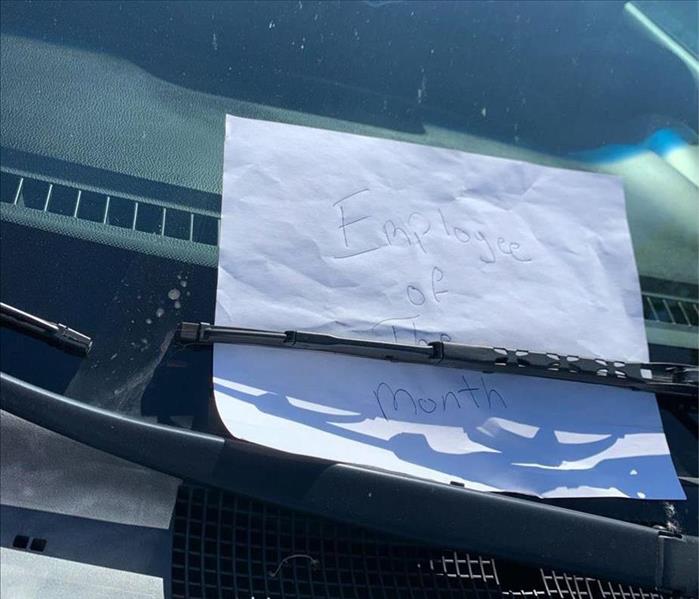 The original parking pass.
The original parking pass.
We’re not sure if this is a little bit too “inside baseball” for the blog, but we found it so amusing and telling about the culture here at SERVPRO of West Seneca/Lancaster that we wanted to share.
A few months back, we awarded one of our favorite team members, Chuck, with the coveted “Employee of The Month” designation. It’s something we take very seriously here, and something that Chuck absolutely deserved due to his incredible customer service.
Chuck has an incredible sense of humor, and he immediately took the opportunity to show it. One of the first things he did was grab his car, back it into the owner’s parking spot, and make a handmade sign that said “Employee of The Month” which he stuck under his windshield wiper.
We weren’t sure if this were a lesson in ambition or a total mistake until the owner showed up and immediately starting laughing. She loved his gumption and the first thing she did was make him a proper, laminated “Employee of The Month” parking pass to use all month long.
Disaster restoration is a tough business, and we’re proud to say that we not only do it well, but we have fun together, too.
Is Bathing During a Thunderstorm Safe?
7/16/2021 (Permalink)
Did your mother used to tell you that you should avoid bathing or showering during a lightning storm because there was a chance that you could get electrocuted?
As a child, this kind of warning was terrifying. As an adult, it has the ring of an old wives’ tale. But is there any truth to it?
As it turns out, yes: there’s a real possibility that you could be electrocuted if you take a shower during an electrical storm. Our source? The New York Times: https://www.nytimes.com/2006/08/15/health/15real.html
As the NYT writes, and as every graduate of fourth-grade science class knows, both metal pipes and water are extremely conductive of electricity. While your house was likely built with some kind of mechanism for channeling the electricity from a lightning strike into the ground, it’s not always perfect. According to Ron Holle of NOAA, between 10 and 20 people every year get electrocuted while bathing, using faucets or handling appliances during storms.
So if you take a shower, is it likely that you’ll be electrocuted? Probably not. But there is a chance.
Why is Flood Water Considered to be Category 3?
7/16/2021 (Permalink)
In water damage restoration, we use different categories as a shorthand to assess the level of contamination in the water that we encounter. Category 1 water is relatively clean (e.g. a water supply line); Category 2 water is significantly contaminated (e.g. a dishwasher leak); and Category 3 water is grossly contaminated (e.g. sewage).
Many people are surprised to find out that flood water is considered to be Category 3. In their minds, flood water either came from heavy rains or from a nearby body of water. While you might not want to drink the water from your local creek, it hardly seems like it should be considered to be “grossly contaminated.”
With flood water, this categorization usually stems less from the source of the water and more from what the water picked up on the way. You have no idea what kind of sediment, pathogens or contamination that the water encountered before it made its way into your structure. Since the water is likely full of hitchhiking contaminants, we consider it to be Category 3 and treat it accordingly.
What Makes Something a Flash Flood?
7/16/2021 (Permalink)
The weather report often gets a bad rap for being unreliable and imprecise. The meteorologists on TV might call for rain and get sunshine, or vice versa, and all of a sudden people start to discount everything that they say.
While the science of predicting the weather can sometimes be a probabilistic guessing game, the language that we use to describe particular weather events is usually very, very precise.
Take the difference between a “flood” and a “flash flood.” You probably have a vague grasp of what separates the two, but could you put it into writing?
A flood is defined by the National Weather Service as “an overflow of water onto normally dry land.” Water levels rise in existing waterways because of precipitation, and floods spill out and cause trouble.
Flash floods, meanwhile, are tied to a timeline: six hours. If the rainfall that caused the flooding occurred in a six-hour timespan, and the flooding was nearly immediate, then it’s a flash flood. Actually, flash floods can be declared even if no rain has fallen so long as there’s an influx of water, as in a dam or a levee breaking.
What to Do During a Flood Watch or Warning
7/16/2021 (Permalink)
Floods can be extremely dangerous events. Not only are the waters themselves capable of causing enormous amounts of damage and loss of life, but the water itself is often contaminated with infectious disease and chemical hazards.
If there’s a flood watch or warning happening in your area, it’s important for you to spring into action immediately to prepare for the worst. The CDC recommends doing the following during a flood watch:
- Gather up your emergency kit (and if you don’t already have one, make one!);
- Stay tuned to local updates on TV. If the power’s out, use a self-powered radio to monitor.
- Build up a supply of clean water. You may want to consider filling your bathtub, sink and any clean plastic/glass bottles that you have as well. Sinks should be well-sanitized before being filled.
- If you keep anything outside (like patio furniture or your grill), bring it in or tie it down.
- If you have to evacuate, turn off your utilities and close your gas valve.
- Follow evacuation instructions exactly. Even if there is no evacuation order in place, consider leaving if you are in a particularly vulnerable location (e.g. somewhere at a low elevation).
By following these tips, you’ll be prepared in case the worst happens.
Returning Home After a Flood
7/16/2021 (Permalink)
If your home or business has suffered flood damage, then it is incredibly important to react intelligently and safely. Even if the standing water itself has dissipated, there still may be serious threats to your and your family’s health lurking where you’d least expect. Even returning from the evacuation point can be dangerous.
To the greatest extent possible, you should avoid coming into contact with flood water. Definitely do not use it as an alternative to regular water, even if you’re just using it to quickly rinse your hands off. Flood water can contain contaminants and pathogens that can cause health effects.
Do not return to your home until you’ve been cleared to do so. It can be tempting to come home as soon as possible, but you should follow the instructions of your local authorities to the letter.
If you’re traveling, avoid driving through standing water. Even levels as low as six inches can cause you to lose control of your vehicle.
If you follow these tips, you should be able to return to your home safely.
Cleaning Your Home After a Flood
7/16/2021 (Permalink)
Imagine that you and your family have been forced to evacuate because of a flash flood in your area. You rush to the evacuation shelter, wait it out, and get the all clear to return home. Your worries are over, right?
Wrong. If your home has been affected by flood waters, there are still serious health effects that you need to be aware of as things get back to normal.
A good mantra is “when in doubt, throw it out.” If any of your food or water has come into contact with flood water, even if it’s in a container (like bottled water), you should toss it out.
Similarly, any drywall, carpets or insulation that have been contaminated with flood water should be thrown away as well. This practice is consistent with the IICRC’s Standard of Care.
Any porous belongings should also be tossed. Things like mattresses, pillows and even stuffed animals cannot be properly sanitized after coming into contact with flood water and should be thrown away.
Non-porous materials, on the other hand, may be able to be cleaned with household bleach. Make sure you dilute the bleach to the proper concentration before using it.
Remember: flood water is generally considered to be “grossly contaminated” with pathogens, on the same level as sewage. Treat it with extreme caution.
What's So Bad About Soot?
7/11/2021 (Permalink)
Where there’s smoke, there’s fire. And there’s also soot, which can actually be one of the most tedious and difficult to deal with aspects of fire damage cleanup and restoration. Despite its appearance as black dust or dirt, soot is chemically different than any regular soil that you’d encounter in your home, and it takes a professional to deal with it effectively.
How can you recognize soot? Usually, it’s brown or black and powdery. It’s what makes something that’s been exposed to fire look charred, but it can also fly around your home and settle on things that were not seriously damaged by the flames.
In fact, soot is made up of the things that were burned by the flames. It’s the leftover particles that were not totally combusted. To that end, not all soot is the same - its qualities are dependent on what was actually burned.
Because of that, the cleaning process for soot is also very dependent on what was actually burned. The chemical composition of burnt plastic, for instance, varies greatly from that of burnt proteins, and must be handled accordingly.
No matter the type of soot, though, you don’t want it in your home. The presence of soot, even if it isn’t obviously visible, can lead to drastically reduced air quality, which in turn can lead to serious health effects. If you have soot in your home, don’t take any chances - leave the cleaning to the professionals.
Why Hire IICRC-Certified Fire Restoration Technicians?
7/11/2021 (Permalink)
We heard an interesting story the other day about a fire damage cleanup that we’d like to share with you (without naming any names, of course).
A fire recently swept through a lovely apartment building. While the fire itself was contained to a single unit, the smoke from the fire infiltrated hallways, common areas and apartments throughout the building.
The property manager hired what she thought was a professional fire damage restoration company. As it turned out, this company relied mostly on temporary labor, overseen by managers who spent most of their day herding cats instead of strategically approaching their restoration projects.
After the cleaning was done, the property manager was disappointed to find that the apartment still reeked of smoke. While she did not visually see any remnants of the fire, she had a bad feeling that she’d been given a raw deal. So she called SERVPRO.
During the initial walkthrough, it didn’t take our manager very long to shake his head and ask whether the cleaners had been IICRC-certified technicians or temporary workers. The property manager confirmed that they were temps, and asked how our manager knew.
“Simple,” he said. He lifted a framed photo off of the wall - behind it was a rectangle of heavy soot. No one had bothered to tell the temps to clean behind the photos, so they hadn’t. The property was still infested with soot particles - just none that you could see without a proper investigation.
It’s so important to trust your fire damage restoration to a reputable company that employs certified technicians. With restoration, it is very easy to cut corners in ways that aren’t always immediately obvious. The consequences of that kind of poor workmanship, however, can be deadly serious.
Furnace Puffbacks: Sometimes Silent, Always Dangerous
7/11/2021 (Permalink)
We’d like to share a story about a very dangerous situation that we ran into recently.
A wonderful woman (let’s call her Jean) lived alone in her home, with her adult children living nearby.
Every time her children came over, they would express surprise that their mother (who had always kept a spotless home) was allowing her house to become so overrun with dust.
“I can’t keep up,” she told them. “I dust every day - it just comes back.”
Nobody thought much of it until one day, her son walked in to find his mother passed out on the floor. He rushed her to the hospital, where she was diagnosed with severe respiratory issues and barely made it out of the ICU.
After some investigation, the son found out that the dust they’d been commenting on was not dust at all - it was soot. His mother’s newly installed furnace had been improperly set up, and for over a year, it had been venting noxious fumes and toxic soot into her house every time she turned it on.
The problem was soon rectified, and appropriate actions were sought against the installer. The next step was to call SERVPRO of West Seneca/Lancaster to clean up the mess - a cleanup that turned out to be fully covered by his mother’s homeowners insurance.
Today, Jean is in excellent health and back in her home. But let her story be a lesson to you - if you have any reason to suspect that soot is building up in your home, or that your furnace is puffing back, do not wait to seek professional guidance. Your health may depend on it.
Is Arson Covered by Insurance?
7/11/2021 (Permalink)
Here’s a question that we hope that you never have to ask yourself: is arson covered by my homeowners insurance?
The sad fact of that matter is no - in most cases, your insurance will not cover a fire that was set maliciously by another party. We’ve run into plenty of cases where fires have been caused by spurned romantic partners, disgruntled employees and bored kids, and insurance coverage has always been notoriously hard to come by for the victims.
Insurance carriers have a good reason for denying claims related to arson: it eliminates the incentive for people to set fire to their own homes, or to pay someone to do it.
That said, there have been cases in the past where insurance carriers will deny a claim simply on the suspicion of arson, without solid evidence that arson actually took place. In situations like this, the homeowner’s best bet is to work hand-in-hand with the fire department’s investigator to gather evidence and build a case of their own. They may even want to hire an independent investigator to help them. By presenting this evidence to the insurance carrier and insisting on fair treatment, they stand the best possible chance of getting their loss covered.
Emergency Board Ups After Fires
7/11/2021 (Permalink)
When a fire strikes your home or business, the first order of business is of course to put the fire out and guarantee the safety of the occupants.
Often, the second order of business is to secure the premises. Fires can be enormously destructive, blowing out windows and creating access points where none existed previously. Fire departments may also need to force entry into the structure to put the blaze out, which can leave windows and doors wide open after the job is done.
In a situation like this, it’s important to get an emergency board up immediately. A board up is exactly what it sounds like - all of these breached access points are quickly covered in wooden boards to prohibit unwanted entry.
Even if a structure is totally gutted and you think that nothing of value remains, it’s important to secure it with a board up. The last thing you need is a lawsuit because someone was able to access your building and then got hurt.
If you need a board up, 24/7/365, call SERVPRO of West Seneca/Lancaster. We’re here to help.
How Does Ozone Help With Fire Damage Restoration?
7/11/2021 (Permalink)
One of the most difficult things to accomplish in fire damage restoration is not cleaning up the water, nor the debris, nor the smoke and soot damage.
Often, the biggest hurdle is getting rid of the odors that the fire left behind. These odors have a tendency to linger because the particles that cause them can be microscopic. They’re invisible to the naked eye and can hide just about anywhere in your home without you ever noticing.
That’s where technology like ozone generators comes in. With a lingering smoke smell, an ozone generator can be just what the doctor ordered.
Ozone generators work by generating molecules with three oxygen atoms (as opposed to the two oxygen atoms that we’re accustomed to in the air that we breathe). These atoms are highly reactive. When they encounter odor-causing molecules (as in those in smoke residue), they oxidize them and eliminate the scents.
That said, ozone is not a magic wand. The most effective way to deal with an odor is to eliminate the source, and the bulk of that work is done through thorough, effective and scientifically-sound cleaning.
Ozone can also be dangerous. Exposure to ozone can cause nausea, headaches and worse, so all living things must be evacuated before we use it, and proper containment must be set up to prevent it from proliferating throughout a home. While regular levels of oxygen are quick to return once the ozone generator is turned off, we often combine high-velocity air movement with ventilation to ensure that the area is safe to return to before clearing it for occupancy.
Why Get Lead and Asbestos Testing on Water Jobs?
7/9/2021 (Permalink)
On many of the water damage jobs that we complete, we call in an independent, third-party company to test for lead and asbestos. For many people, that comes as a surprise.
Unless you’ve experienced catastrophic water damage yourself, you probably don’t know much about the restoration process.
Most people, when they call us, assume that the bulk of the water damage restoration process entails extracting standing water and maybe setting up a few fans.
If only that were true. In many cases, if the water sits for any extended period of time, it will wick up into the structure and become trapped. Even if a wall feels dry to the touch, it could hold tremendous amounts of moisture that will cause structural damage and mold growth if not properly dealt with.
Sometimes, it’s possible to dry a wet wall simply through air movement and dehumidification. But often, we run into situations where it is faster and more cost-effective to cut out a portion of the wall so that we’re able to access trapped moisture directly.
That’s where lead and asbestos testing often come in. In the seventies, the United States outlawed the use of lead-based paint and many asbestos-containing building materials. Most structures built before that point have some level of lead and asbestos.
So, before we have to do demolition on a water job, we’ll often bring in a third-party company to test for lead and asbestos. This can slightly extend the timeline, but it’s worth it to keep homeowners and our team safe.
Water Damage Restoration in Confined Spaces
7/9/2021 (Permalink)
In the typical residential water damage restoration job, we find ourselves in a basement or a bathroom. These jobs are not always easy, but we’re at least working within rooms that were meant for human habitation.
Sometimes, though, we have to work in what’s called a “confined space.” A confined space is defined as any space that:
- Is configured so that someone can enter it;
- Has limited means of entry and exit;
- Has the potential for containing atmospheric hazards;
- Is not designed or intended for continuous occupancy.
The last point is the real kicker – these are spaces where human beings were never supposed to go, and certainly were never supposed to spend extended lengths of time. Crawlspaces under houses, for example, would be confined spaces.
While not every restoration company is capable of working within a confined space, we have the training and the safety procedures to perform restoration wherever and whenever you need us. Those safety measures might include hiring an attendant to monitor the space’s entrance, installing a retrieval line, and conducting extensive testing for atmospheric and other hazards.
Of course, you’re never quite prepared for what you’ll find in a confined space. All we’ll say is that, if you crawl into three foot tall crawlspace and you see another set of eyes staring back at you, get out of there as quickly as you can.
The First Step of Water Damage Restoration
7/9/2021 (Permalink)
Every single water damage restoration job is different. That’s one of the things that makes our job so interesting – you never work the same job twice.
That said, almost every single job starts with the same step: identifying and stopping the source of the water.
That might seem obvious (after all, if you have water gushing into your house, you’d want it to stop, right?). But for many people, it comes as a surprise. All they see is water standing in their basement that they want to get rid of, and they don’t always understand why we’re so adamant that the source be shut off before we begin.
The major reason is that, if you can’t stop further damage from occurring, then performing mitigation is useless. Sure, we can extract some of the water and even set up equipment, but if the water comes pouring back in (or even if it trickles back in and accumulates), that work was just a costly waste of time.
In addition, identifying the source of the water helps us figure out what kinds of work and safety protocols that we have to follow. To the naked eye, water from a toilet supply line and water from an exterior flood might look very similar on your basement floor. On a microbial level, however, there’s a world of difference.
So if you’re dealing water damage, remember: step one is to stop the water.
The Second Step of Water Damage Restoration
7/9/2021 (Permalink)
After identifying any safety hazards and stopping the source of the water intrusion, the second step of water damage restoration is to answer the question “what’s wet?”.
This question can be trickier than you’d think. Water has a tendency to migrate far and wide throughout a structure in ways that can be extremely difficult to predict. Our job is to find the “edges” of this migration so that we can properly scope out the restoration project.
It is INCREDIBLY important for any restoration professional to be comprehensive when figuring out what’s wet. It’s on us to inspect all potentially affected areas so that we can scope the project properly for the homeowner and their insurance carrier. That means that if you have a toilet leak on the third floor of your house, we may have to inspect the ducting all the way in your basement crawlspace to know for sure whether it has been affected or not.
As we go, we’ll also protect any belongings that are in wet areas. This might include blocking and padding furniture, removing or lifting clothing and draperies, removing metal objects and ensuring that the water does not migrate onto any dry surfaces.
Once we know “what’s wet,” we can then go on to scope and complete the water damage restoration work.
Categories of Water Damage
7/9/2021 (Permalink)
In water damage restoration, we share a common lingo with our peers in the industry, as well as the insurance adjusters that we work with.
For example, we define different types of water in three different categories. The water’s category is determined by four factors: source, time, temperature, and pre-existing condition.
Category 1 water, also sometimes called “clean” water, is water that has no substantial risk of causing sickness or discomfort. If the water has come from a broken water supply line, for example, it’s considered to be Category 1.
Category 2 water, meanwhile, carries a significant degree of chemical, biological or physical contamination. Category 2 water is sometimes referred to as “grey” water. It might include water from a dishwasher leak, or an aquarium, or even a waterbed. It could even be Category 1 water which has been allowed to sit for an extended period of time. It might not be the most contaminated, but you certainly wouldn’t want to drink it or handle it without proper protection.
Category 3 water, also known as “black” water, is considered to be “grossly” contaminated. Sewage from beyond the toilet trap, water from a septic system, or floodwater that has swept up contaminants from outside are all considered to be Category 3 and must be handled with extreme caution.
If all of this lingo is over your head, don’t sweat it – the important thing to remember is that if water is contaminated, or even if it has been standing, it carries a risk of causing health effects.
Primary vs. Secondary Water Damage
7/9/2021 (Permalink)
Over the course of a water damage restoration project, you may hear the terms “primary” and “secondary” water damage. As a homeowner, you might not care much about the distinction – after all, all you want is for the damage to be gone – but as a professional restoration company, it’s vital for us to know the difference.
Primary damage is the damage that occurs when your structure and contents first come into direct contact with water. If your ceiling bursts because of the weight of the water pouring into it, that would be an example of primary damage.
Secondary damage, meanwhile, is the damage that occurs when excessive moisture is allowed to sit inside a structure for an extended period of time. When moisture remains and humidity is high, it can cause irreversible damage to building materials as well as promote the growth of all sorts of nasty microbes, including mold.
Often, by the time we’re called to the scene, primary damage has already occurred. Our first order of business is to prevent secondary damage from occurring through restorative drying. Once we stop any further damage from occurring and properly dry the structure, then we can call in our reconstruction team and handle the primary damage as well. It’s all part of making your loss “Like it never even happened.”
How Long Does It Take for Mold to Grow After Water Damage?
7/1/2021 (Permalink)
Water is the stuff of life. It covers most of the planet, makes up the majority of our bodies, and sustains every life form on Earth.
That’s great, but it also means that when you have a water intrusion in your home, you’ve created an environment where life can thrive. Microscopic organisms can multiply rapidly in areas of unusually high moisture and humidity, especially when a food source is available (like, say, the paper on your drywall).
The key to preventing mold growth is a fast response. But how fast? How long does it take mold to develop after water damage?
The Timeline for Mold
The basic rule of thumb that most mold remediation technicians will tell you is that mold colonies can start to grow within 24 to 48 hours in the right conditions. If they have moisture, and they have something to eat, you’re at risk of an infestation.
Like anything else, this is not a black-and-white rule. We’ve seen situations where contaminated water has sat for nearly a week and no mold has developed. We’ve also seen situations where a seemingly uncontaminated home can become a dank, mold-infested biohazard over the course of a weekend.
Our advice is to assume the worst – if you let water and moisture sit for more than a day without taking any measures to reduce humidity, promote drying and inhibit the growth of mold, you stand a very good risk of starting an infestation.
That’s why we’re available 24/7/365. If you’re dealing with a water loss, call 716-674-1103 – we’re here to help.
Vacuum Freeze-Drying for Document Restoration
7/1/2021 (Permalink)
Here’s a vocabulary word for you: “sublimation.”
You may have run into “sublimation” in science class, way back when. It’s the word for when a solid (as in ice) turns directly into a gas (as in water vapor) without ever becoming a liquid (as in water).
You might be thinking “impossible!”, and we wouldn’t blame you. If you’re thinking about ice melting, then sublimation might seem like an impossibility.
But with vacuum freeze-drying, sublimation is a predictable, manageable process. And it’s exactly what we use to dry documents that have suffered water damage.
How does vacuum freeze-drying work?
Say you run a medical office, and your sprinklers went off in your records room. The records that you are required to keep, by law, for your patients have been soaked. You need to restore them in order to maintain compliance, so you call the SERVPRO of West Seneca/Lancaster document restoration team in to help.
Our team will bring the documents to a special drying chamber designed for vacuum freeze-drying. The wet documents are frozen solid in order to maintain their structure and integrity. Then, a high-pressure vacuum is used to remove any air from the chamber.
Within this vacuum chamber, the pressure and temperature can be strictly regulated to convert the moisture in the documents into water vapor without allowing it to revert back to its liquid form.
This vapor is then collected via a condenser that can achieve temperatures of -40ºF, which turns it back to ice for disposal. Over time, the temperature is gradually increased within the chamber to remove more moisture from the documents safely, until they meet our dry standard and are restored to their preloss condition.
It’s a high-tech process, so if it seems a little bit crazy, don’t sweat it. All you really need to know is that if your documents get soaked, call SERVPRO of West Seneca/Lancaster immediately. We’re here to help.
Employee of the Month - Scott
7/1/2021 (Permalink)
Every month, we take the time to honor a member of our team who has gone above and beyond to take care of our customers.
In May of 2021, that was Scott. Scott is a relatively recent addition to the team, yet from Day 1, he’s brought a positive, can-do attitude to every single challenge that we’ve thrown at him.
More than that, he’s proven to be a leader who takes the initiative, with excellent attention to detail. In fact, one of the major reasons that Scott was nominated was a fairly simple action.
As one of our managers was closing up for the day, he noticed Scott in the back of our warehouse, screwdriver in hand. Scott had noticed that one of the license plates on our vans was hanging a bit crooked and he’d found that one of the screws had fallen off. No one had to tell him to fix it – he noticed, he found a screw, and he made the repair.
What we’ve learned is that the kind of person who will go to the trouble to make things right when no one is looking is the kind of person that you can count on. We’re proud to have Scott on our team. Thank you, Scott!
Employee of the Month - Chuck
7/1/2021 (Permalink)
Every single month, we hold a meeting for all of our technicians where we honor an Employee of the Month who has set a fantastic example for the team with their attention to customer service.
In June, that was Chuck. If you’ve ever been to our warehouse in the morning or the afternoon, then you’ve probably heard Chuck’s laugh. It’s cheerful, it’s contagious, and it puts just about everyone in a good mood.
That’s why everyone on our team loves working on a job with Chuck. Working for SERVPRO of West Seneca/Lancaster can be very difficult sometimes. Our team makes some of the worst, most catastrophic disasters “like they never even happened.” Chuck has the rare ability to make even the most challenging jobs enjoyable, simply by being himself.
Our customers love him for the exact same reason. Even if they’ve suffered a loss that’s truly devastating, Chuck always finds a way to make them smile and feel reassured that everything’s going to be okay.
Thanks for everything, Chuck! We’re proud to have you aboard!
The 5 Principles of Drying
7/1/2021 (Permalink)
At SERVPRO of West Seneca/Lancaster, we follow the IICRC’s S500 Water Damage Restoration Standard. Our IICRC-certified technicians follow this standard of care because it provides a roadmap for comprehensive, effective and timely restoration that makes our customers’ disasters “Like it never even happened.”
The S500 designates five principles of drying that we adhere to. Here’s what they are.
Principle 1: Provide for the Safety and Health of Workers and Occupants
Our first responsibility is to identify and eliminate safety hazards when we arrive on site. This goes for hazards that affect our team as well as any occupants.
Principle 2: Document and Inspect the Project
Next, we must evaluate how much the water has migrated through the structure and figure out how much moisture has been absorbed. This principle necessitates that we complete a thorough inspection that includes all areas where the moisture might have migrated, as well as ongoing and final inspections.
Principle 3: Mitigate Further Damage
After initial documentation and inspection, our priority is to mitigate any further damage. Without mitigation, water will continue to migrate, humidity and moisture levels may continue to rise, and there’s a distinct possibility that further secondary damage will occur.
This principle also covers the control of contaminants, like microbial growth. A quick response is vital for limiting this kind of secondary damage, since mold outbreaks can occur within as little as 24 hours after abnormal levels of moisture arise.
Principle 4: Clean and Dry Affected Areas
While some materials may need to be replaced after water damage, we make an effort to both clean and dry whatever we can, so long as it makes financial sense for all materially interested parties.
While we won’t get into the full potential scope of cleaning and drying here, suffice to say that there are many different techniques to employ, and many different variables to control, in order to make water damage “Like it never even happened.”
Principle 5: Complete the Restoration and Repairs
Our job does not end when everything is dry. Our job ends when we return your home to preloss condition. Whether this means re-installing baseboard or building you an entirely new house, we’re ready and prepared to do it all.
These five principles guide us on every single water job. If you’ve had water intrusion in your home, call 716-674-1103 – we’re here to help.
Common Hazards in Water Damage Restoration
7/1/2021 (Permalink)
Water damage restoration is an exciting, interesting line of work. No two days are the same, and you’re constantly being called upon to solve problems, think critically and make a difference in the lives of people in your community.
That said, restoration work can also be dangerous. On every single job that we do, our first priority is the health and safety of both our team and any occupants of the structure that we’re working in.
The most common hazard that we deal with is actually somewhat mundane: slips and falls. Even in a major disaster, sometimes the biggest risk is a wet floor.
Past that, there are many hazards that we check for on each and every job. Here’s a list of the most common hazards that we run into:
- Electrical shock
- Gas leaks
- Lead-based paint
- Asbestos-containing materials
- Entering “confined” spaces (i.e. spaces not designed for human habitation)
- Coming into contact with contaminated water (e.g. sewage)
- Leaks of chemicals or hazardous materials
- Damaged construction components or materials (e.g. falling ceilings)
- Exposure to household chemicals without proper packaging or PPE
- Excessive heat
Some of these hazards seem like no-brainers, while others may not seem like such big deals. Take it from us – each and every one of the items on this list can represent a significant health risk in the wrong circumstances.
That’s why the first thing our technicians do is eliminate, contain and communicate hazards to all parties. It’s just one more way that SERVPRO of West Seneca/Lancaster strives to keep you safe.
Saving Water Damaged Ceilings
6/30/2021 (Permalink)
Can you restore water damaged ceilings?
The answer is “sometimes.”
Most ceilings in residential homes are constructed with drywall. Drywall, if you’ve never really looked at it, is mostly made up of layers of paper or cardboard. It’s durable enough to serve as a building material, and quite affordable, but it doesn’t stand up to water very well. When there’s a water intrusion, it can very easily absorb or track large volumes of moisture.
Since paper is an organic material, wet drywall can also be a huge target for mold growth if not dealt with quickly and properly.
That said, it’s not like wet ceilings are a totally lost cause.
When can wet ceilings be saved?
If the water damage is relatively minor, then there’s a good chance we’ll be able to save your ceiling. Much like any other drywall, we’ll likely have to find a way to ventilate it and blow warm, dry air into it to promote evaporation, and then capture the evaporated moisture with dehumidifiers.
Once the ceiling is dried, then it’s just a matter of performing some minor repairs and painting to cover up any imperfections. The process, no pun intended, is pretty cut and dry.
This scenario assumes that the water that your ceiling was exposed to was clean “Category 1” water, and that the structural integrity was not affected. When the water category changes, or the structural integrity goes down, then we have a problem.
When can’t wet ceilings be saved?
If we walk into a home and see a ceiling that is sagging, bubbling or bulging, then we are very likely going to recommend that it be removed, disposed of and replaced. In a state like that, the ceiling has lost its structural integrity and poses a very real threat to both you and us.
Even if the structural integrity has not been affected, we still may recommend removal is the ceiling has become contaminated. Usually, this comes in two forms.
The first is “Category 2” or “Category 3” water. This is water that is either significantly or grossly contaminated by things that could make you very sick, like sewage or pathogens. If that water hits your drywall, there’s really no way to effectively clean it, and it needs to be replaced.
The second is mold growth. Mold growth is preventable but still very common when there’s been water damage. If there’s mold growing on your water damaged ceiling, removal and replacement may be more cost-effective than trying to save it.
For more information on our standard of care, Google the IICRC’s S500 standard – it lays all of this out in more detail.
Cleaning Furniture After a Fire
6/25/2021 (Permalink)
If you’ve suffered a serious fire at your home or business, then you know that one of the most difficult things to deal with after the fact is the soot and the smoke. Soot can stain your structure and your contents, and the odor can be pervasive even if you can’t see any visible staining.
For this reason, most people assume that their furniture will be a loss after a fire. After all, if they can’t even get the smell out of the walls, how could they expect to get it out of an armchair?
It’s true that, much of the time, furniture must be replaced if it has been exposed to significant levels of fire, smoke and soot. Often, though, our trained team of furniture cleaners can make that damage “Like it never even happened.” Here’s how we do that.
Upholstered Furniture
Upholstered furniture is extremely difficult to clean if it’s been exposed to smoke. Even if it looks clean, it still might contain particles of smoke and soot that it will continuously release into the air over time, causing a lingering odor that can be difficult to pin down.
The key with upholstery is care and precision. Soot must be carefully vacuumed so as not to spread or smear the particles. All removable covers should be washed separately. What remains can often be cleaned using our proprietary upholstery cleaning machine. If we make an attempt and the furniture still is not cleaned to our standard or your satisfaction, then we will likely recommend that it is written up as a loss and replaced by your insurance carrier.
Leather Furniture
Unlike upholstery, leather cannot be wet cleaned, and you must be extremely careful not to scratch it. When we vacuum up soot, we likely won’t even make direct contact with the leather out of caution.
Once soot has been vacuumed, then we will employ one of our in-house leather cleaning products, which have been specially formulated to clean leather after disasters.
Wooden Furniture
Technically, wooden furniture is the simplest to clean, but that doesn’t mean it’s easy. Soot should be vacuumed and a wet cleaning process will usually follow. After that, we’ll use one of our proprietary wood polishing and conditioning products to return your wooden furniture to preloss condition.
Our best advice is this - if you’ve suffered a fire, don’t handle the cleaning on your own. Getting it wrong can make the damage worse, if not permanent. Give us a call - we’re here to help.
Cleaning Electronics After a Fire
6/25/2021 (Permalink)
Did you know that smoke, soot and fire can cause invisible damage to your high-end electronics?
If you’ve suffered a fire in your home, you’re likely preoccupied with the most obvious, visible damage to your structure and your possessions. Often, unless they’ve been seriously charred or melted, electronics can look like they made it through the fire unscathed.
Unfortunately, that is not always the case. Here’s how electronics get damaged in a fire, and here’s how to clean them.
How are electronics damaged in a fire?
Obviously, if your television set melted, it’s been damaged by the fire. We won’t bother going into that.
Sometimes, though, the damage is not so obvious. Heat, smoke and soot can lead to a variety of issues, including:
- Corrosion: soot can be acidic, and if it finds its way inside your electronic devices, it can corrode key components without you realizing.
- Insulation: a coating of soot is actually a very effective insulator for heat. This is bad news for electronic devices, which can very easily overheat if they’re not able to cool themselves properly.
- Magnetization: smoke can sometimes carry a magnetic charge, which can short-circuit certain types of electronics. While many devices have protections against magnetization these days, it can still happen (remember when you could wipe out a hard drive or a credit card with a magnet?).
How do you clean and restore fire-damaged electronics?
First, you try to determine if it’s even worth trying. If your electronics were exposed to extreme heat and damaged, then it’s probably wise to just call them a loss and see if your insurance carrier will replace them.
If they haven’t been damaged in this way, though, you stand a chance of restoring them.
First things first - disconnect the device from the power source if you think it has sustained smoke damage. That will prevent it from short-circuiting or causing further damage.
Wipe down the exterior with a soft rag and see if that deals with the soot damage. If you have compressed air, use that to clean out the openings, ports and crevices.
Past that, you’ll need to involve an expert. If there was serious smoke damage, there may be significant levels of soot inside the device itself. Unless you’re a professional electronics restorer, you probably lack the skills to dissemble, clean and reassemble your device effectively.
If that’s the case, give us a ring. We’re here to help.
What to Do With Elevators During a Flood
6/24/2021 (Permalink)
One of the most common problems that we run into when performing water damage restoration for commercial property managers is damage to the elevators.
Your elevators (and your escalators) are complex machines that can become very dangerous if they suffer any kind of flooding or damage. Knowing how to react when there’s been a water intrusion is vital for keeping your building safe and functional.
Before the Water Comes
The best favor that you can do for yourself is to prepare.
In part, that means proper maintenance. Make sure that your elevators have a functional surge protector, and that their standby generator works properly if you have one in place. You should also regularly test the emergency lighting and phone system.
You should also replace or repair any run-down components. If the doors have become corroded, the vents or doors are leaking, or the weather stripping has come up, it should be addressed.
Past that, you should consider installing a sump pump and a float switch. The float will prevent the elevator from running to the bottom if the pit floods, and the sump pump will enable you to pump out the water and restore your elevator to proper operation.
When the Water Comes
When a water intrusion does occur (perhaps due to a firefighting effort, or a storm), it’s important to act fast.
Run your elevators to the top landings and cycle the doors shut. If it’s safe, you may one to keep one elevator operational for emergency personnel and the disabled, but it’s wise to disconnect the rest in the machine room.
If you have tenants who rely on the elevators, you should consider evacuating them, especially if the crisis is ongoing. Often, the fire department may legally have to be the organization that coordinates this evacuation.
After the Water Comes
Ensure that no one is trapped in the elevators – if they are, call for emergency assistance.
Do not turn your elevators back on until they’ve undergone a thorough inspection. Check the machine room and the elevator pits for water, as well as the control panels and the elevators themselves.
If there has been damage, call your elevator company for assistance. If SERVPRO is on-site, we may be able to help you with drying your elevators so that they can be brought into operation faster.
Document damage in the greatest possible detail. Take photographs, save damaged components and call your insurance company immediately if you intend to put in a claim.
By following these steps, you’ll be able to stay as safe as possible, and get your life back to normal faster, if your elevators get wet during a flood.
How Much Water Does a Commercial Sprinkler System Put Out?
6/24/2021 (Permalink)
Ever wonder how much water your commercial sprinkler system can put out?
We can tell you from experience that it is a massive amount of water. When we arrive on-site to provide fire and water damage restoration after the sprinkler system has gone off, we usually have several days of mitigation and drying ahead of us.
In general, this is a good thing. Fire prevention systems are designed to only put out as much water as they have to in order to put out the fire. Contrary to what you see in the movies, your entire sprinkler system does not go off in case of a fire. In most systems, the response is localized to areas where the fire is active, since it is the heat from the fire that bursts the sprinkler bulbs and prompts the water to flow in the first place.
But how do you calculate how much water flows through your sprinkler system per minute? There are two ways to figure it out.
The Easy Way
The simplest way to get this question answered is to just ask your fire prevention company. They’ll be more than happy to explain to you exactly how the system works, how much water it is capable of putting out, and how best to maintain it so that it operates as designed.
Trust us – they’ll be happy that you called. 99% of the time, when someone calls their fire prevention company, it’s because something has gone wrong. You could be in the 1% of people who took an active interest in their system before they needed it.
The Hard Way
If you really want to figure out how much water your system can put out by yourself, then you should be prepared to do a little math.
Your overall flow rate depends on the flow rate of each individual sprinkler, which in turn is affected by things like the dimensions of the sprinkler’s opening, friction within the line and other factors. Each individual sprinkler should have a “discharge coefficient” provided by your fire prevention company that takes all of these factors into account.
Each sprinkler should also have a pressure rating expressed in “pounds per square inch.” Again, this should be simple to find via your fire prevention company.
To come up with a figure for gallons per minute, you multiply the discharge coefficient by the square root of the pressure rating.
Here’s an example. You have 24 sprinkler with a pressure rating of 20 pounds per square inch and a discharge coefficient of 6.1. The square root of 20 is 4.47.
6.1 * 4.47 = 27.26 gallons per minute.
If you multiply 27.26 by 24, you get the flow rate for that entire set of sprinklers: about 654 gallons of water per minute.
Like we said – it’s a lot of water! But if you’re dealing with a fire, you’ll be glad to have every last drop.
Commercial Fire Restoration: How Does It Work?
5/24/2021 (Permalink)
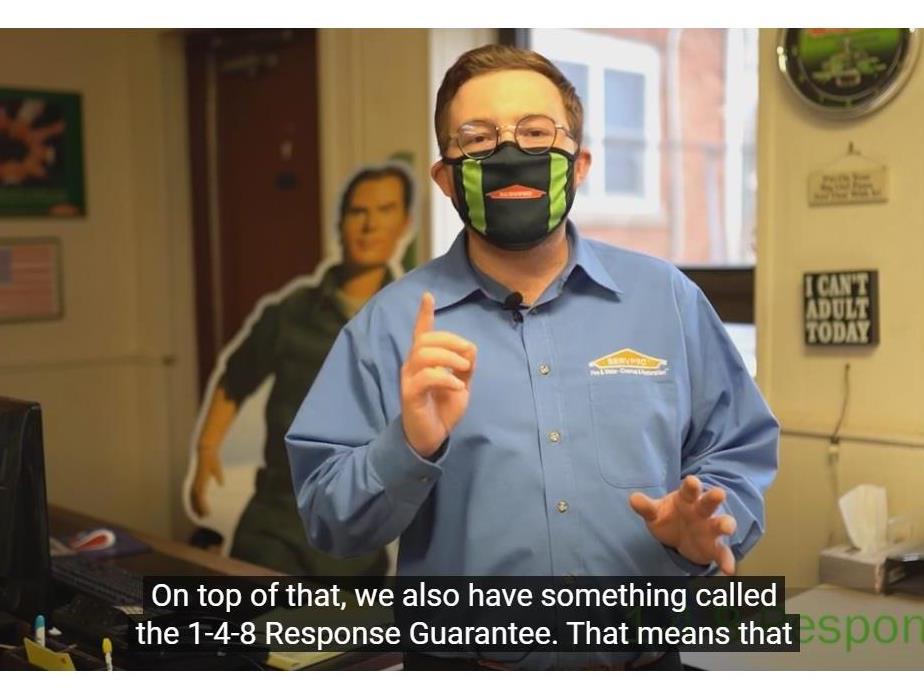 We're here to help!
We're here to help!
We're here to help commercial property managers in the West Seneca / Lancaster area deal with all sorts of disasters, including fires.
How do we do that? We created this video to show you (and have a little fun in the process).
The transcript is below. Enjoy!
The Fire Damage Restoration Process
Here at SERVPRO, we help people on what's basically the worst day of their lives. Maybe they had a fire, maybe a water main broke, whatever. It's not good. So I like to say we're not really in the restoration business, we're in the hero business. And I want to show you exactly what I mean by that.
We’re Available 24/7/365
Disasters happen when you least expect them. That's why we have dedicated dispatch personnel here to answer your phone calls 24/7/365, just like my friend Blaze here.
On top of that, we also have something called the 1-4-8 Response Guarantee. That means that within 1 hour of your call, even if it's 3 A.M. on Christmas, you're going to get a call back from our on-call staff scheduling a time to get out to you.
If it's an emergency, within 4 hours, they will be on-site to provide emergency mitigation services and stop the damage in its tracks.
Within 8 hours, you're going to have a scope of work that both you and, if necessary, your insurance provider will be able to go over so that you know exactly what you're dealing with. It's just one way that we make any disaster "Like it never even happened."
Emergency Mitigation After a Fire
The first step of any SERVPRO job is mitigation. How can you stop any further damage from occurring?
That's why it really pays off to have an IICRC-certified experienced technician like our friend Stormy here on-site during your loss. They can really assess what can be restored, what needs to be replaced and everything in between. How you doing, Stormy? Great job.
Drying After a Fire Has Been Extinguished
After the mitigation process has taken place, the next step is usually drying everything out and eliminating any more moisture in the structure. This is really important - any lingering moisture can cause structural damage as well as biohazards, including mold.
Our buddy Blaze here is getting ready to load 100 of these air movers onto our vehicles for a large commercial fire - hope you ate your Wheaties this morning, bud!
Structure Cleaning After a Fire
After the drying process starts, then it's time to start cleaning the structure itself. SERVPRO uses over 100 proprietary products along with specialized techniques to make your structure like your fire loss never even happened. Don't forget your Fire Star, Stormy!
Textile and Soft Contents Cleaning After a Fire
Even textiles that have been exposed to some really nasty fires can be cleaned nowadays thanks to our very new, very cool Esporta industrial-grade washing system. This system, independent studies have shown, can clean up to 90% of the soft contents that previously used to have to be disposed of, even if they've been exposed to fire, smoke, soot, water, even bio-contaminants. Not only can it clean them, but it can get them up to food-grade safe. How about that? Think you can throw in my mask there, buddy?
Deodorization – How Do You Eliminate the Smell of Smoke?
One of the most vital things that SERVPRO does to make your loss "Like it never even happened." - we get rid of the smoke smell. Deodorization is one of the most important services that we provide. We have all sorts of specialized techniques and tools, like this o-zone generator, to make it happen. Hey Stormy, let's make the world smell good again, right?
Reconstruction After a Fire
After the restoration process ends, then it's time to rebuild. That's why we here at SERVPRO of The Southtowns have our very own, full-time reconstruction team. Get out there and start building a better tomorrow, Blaze!
Your Restoration Heroes
I hope walking through the warehouse here with you gives you a little bit of a better understanding of what we do here at SERVPRO of The Southtowns every single day. The restoration process - it's got a lot of moving parts, but what you really need to remember is: we're not in the restoration business, we're in the hero business, and we're here for you, to make it "Like it never even happened."
ERPs - Now with Video Walkthroughs!
5/14/2021 (Permalink)
 Get your ERP today!
Get your ERP today!
At SERVPRO of West Seneca / Lancaster, one of the most vital services that we provide for commercial property owners here in Western New York is emergency planning. Our proprietary Emergency Ready Plan is custom-built for each property that we visit and designed to be simple to use, simple to access and a lifesaver in case of disaster.
Just because our ERPs work well, however, doesn’t mean that they can’t always be improved. We’re constantly searching for ways to add more value for our commercial property partners, and we’re proud to unveil our latest development: the video walkthrough.
Video Walkthroughs for ERPs
ERPs are highly structured and highly visual. Each ERP features the following sections:
- Property Location, which lists vital details about the property as well as directions;
- Property Details, which dives into construction details and dates, per-floor details and more;
- Building Access, which lists various points of entry and egress, as well as locations of elevators and stairwells;
- Utilities, which shows the location of a variety of utilities and building systems, as well as how to operate them;
- Contacts, which details the chain of command in the building, as well as listing the contact information for vendors who might be necessary in a variety of emergencies;
- Notes, which stores all of the information that doesn’t fit into the aforementioned sections.
Each of these sections contains a ton of photos to make finding various parts of the building easier. One day, as we were shooting some of these photos for a client, we realized that we could shoot a video version of the entire ERP at the exact same time.
Thus, the video walkthrough was born. These video walkthroughs provide a 3-to-5-minute introduction to the building and its systems. If the core ERP is great for an emergency, the walkthroughs are fantastic for training new property managers, or refreshing current property managers’ memories about how the building operates.
Interested in having us put a walkthrough together for your building? Call 716-674-1103 – we’re here to help.
Understanding Your Commercial Sprinkler System
5/14/2021 (Permalink)
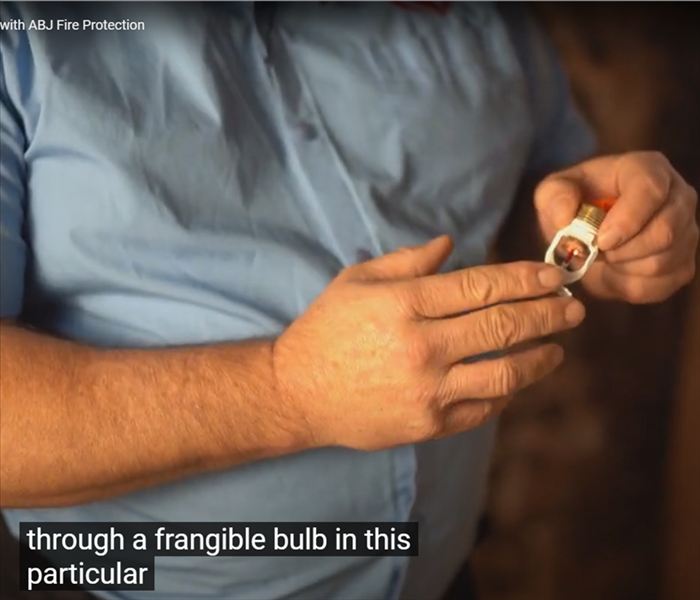 Thanks, John!
Thanks, John!
Recently, we were lucky enough to film a video with John Sprandel of ABJ Fire Protection walking commercial property managers through the operation of their sprinkler systems.
You can view the video here. Below is a transcript - we hope it helps!
Your Commercial Sprinkler System
So we're in the basement of the facility where the water service enters.
Now the water service provides water to the domestic facilities - your toilets, your showers, your sinks, your water fountains.
It also separates to provide water for your fire protection system.
How Sprinkler Systems Discharge
Now, your fire protection system is piped throughout the building to individual sprinkler heads located in all areas of the building. These sprinklers are individually activated, through a frangible bulb in this particular case. That's designed to discharge when the temperature reaches 155 degrees so not all the sprinklers go off at the same time, only the ones that are exposed to that particular temperature. So, contrary to popular belief or the movies, only one sprinkler head is usually what it takes to put out a fire.
Backflow Prevention
Now, where we have the water service entering, we have a device that's called a backflow preventer. The back flow preventer prevents any contaminants from entering into the public water supply. The fire department or the fire sprinkler system also has a double check backflow preventer.
Why is it important to know those features in your facilities? You have to distinguish “where is the water coming from?” Is it from the domestic service or is it from the fire sprinklers?
Fire Alarms and Sprinkler Systems
The fire sprinkler system has a device installed on it called a flow switch. This is a water flow switch that activates within 60 seconds when water is discharging from one of these sprinkler heads. So not only does the fire department know within 60 seconds that a fire has occurred, but there's also water discharging and then the tenants throughout the facility will also know when the alarms go off that it's time to leave.
The difference between the fire system and a domestic water system is if there is to be a failure of the piping (say it would freeze and break), there's really no way to indicate that that water is flowing. So it's important to know what one of these valves you have to close in order to mitigate that water damage.
One of the things that we can work with you on is identifying, what particular case, what particular valve. We could do that with each individual facility.
Testing and Maintaining Sprinkler Systems
So how do we test this fire sprinkler system? We don't discharge water inside the building. What we do is we install a valve that simulates the water flow through one sprinkler head to ensure that that will activate the alarm system. We install a valve, we test it and then it flows for 40 to 60 seconds. Then it activates an alarm on the fire alarm panel and it will send a signal to the fire department, who will be notified and respond.
The audio visual devices throughout the building will also be going off so you know that it's time to evacuate.
The water service also provides water to the domestic services - your sinks, your showers, your water fountains, your toilet fixtures. What we have is a control valve. We have a bypass. That bypass will allow us to work on the meter. Then we have a meter that monitors how much water is used or consumed and then we have a backflow preventer with separate control valves.
The control valves on each side allow us to do any maintenance or repairs on that particular backflow preventer. On a domestic service, this backflow preventer is a little bit different than the one on the fire service. This one is a little bit more protective of the water supply. It's actually called a reduced pressure zone, or an RPZ backflow preventer.
The Difference Between Fire and Domestic Water Supplies
One of the differences between a fire service water supply and a domestic service water supply is that the device that's installed on the fire system, or a flow switch, will indicate that there's water flow within 60 seconds. If something were to occur on a domestic water service, there's no activation of any alarm or any device that would indicate that there's water flowing.
If for some reason the heaters failed and the pipe froze and it broke you may not see that particular situation until someone sees water flowing out of a door or they look down in the basement and see two or three inches of water on the floor.
It's important that these systems and these devices are properly maintained on a regular basis. Backflows need to be inspected and checked once a year.
So those are the type of services that my company provides and we'd be happy to help if there's ever any need for repairs.
Emergency Pre-Planning
In summary, one of the things that I want you to make sure you take away from this is that when an event occurs it may become confusing to remember which valve you need to close. So it's important to establish that pre-plan and that's what Dan (from SERVPRO) and myself are here for. It's by taking those steps that we can help mitigate damage control and loss when an event occurs
Certified for Water Damage Restoration
5/13/2021 (Permalink)
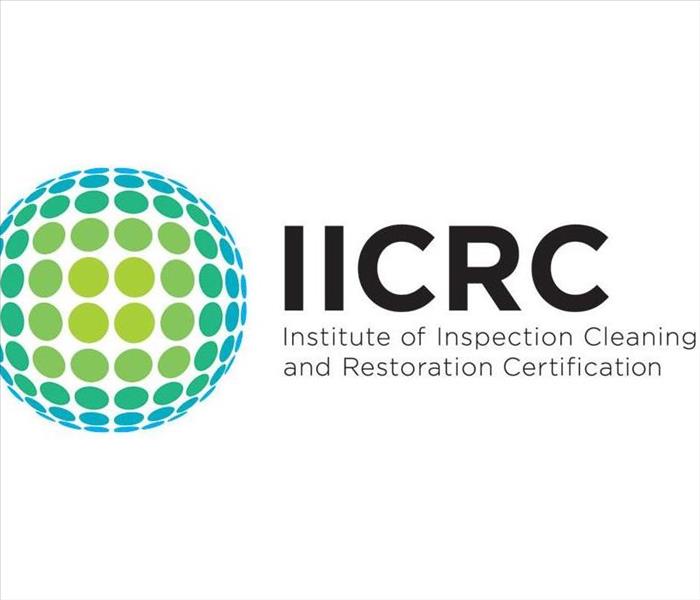 The IICRC sets the standard for the restoration industry.
The IICRC sets the standard for the restoration industry.
At SERVPRO of West Seneca / Lancaster, it's important to us that we provide you with the highest standard of water damage restoration.
We do a lot to make that happen. One of the most important things is certifying our technicians with the Institute of Inspection, Cleaning and Restoration Certification, or IICRC.
The IICRC sets industry standards for the entire field of restoration, and certifying with them is the best way to make sure that our technicians are trained on the latest science in water damage restoration.
Let's take a look at one of the most important certifications that our technicians get: the WRT.
Water Damage Restoration Technician (WRT)
The Water Damage Restoration Technician (WRT) certification that the IICRC offers is one of their foundational certifications, but that doesn't mean that it's easy to get.
To achieve the WRT, our technicians must attend three days of classes totaling 19 full hours of instruction. After that, they must pass a rigorous exam to become fully certified.
The point of this instruction is to deepen the technicians understanding of the science and theory behind the work of water damage restoration. By learning the science, technicians are able to make intelligent choices about the best way to dry customers' structures and contents, which leads to better outcomes for everyone.
The WRT is only one of the certifications that our technicians achieve. The IICRC offers a variety of further certifications in water, fire, mold, structural drying and more. By continuing their education, our technicians ensure that they remain the best in the business.
Thank you, Mayor Moses!
5/12/2021 (Permalink)
 Thank you, Mayor Moses!
Thank you, Mayor Moses!
It seems like only yesterday that New York State first went into lockdown to minimize the spread of the COVID-19 pandemic.
Somehow, over a year has passed since those orders first went into place and our entire world changed.
Overnight, people shifted from their daily routines into a "new normal." For many of us, that meant working from home five days a week.
Our first responders, however, never had that option. While most of us were locked down at home, they answered the call of duty and continued to go out into the community to keep us safe.
At SERVPRO of West Seneca/Lancaster, we're proud to support our first responders any way that we can. That's why, when lockdowns first hit, we volunteered our time to disinfect and protect every single police, fire and EMS agency that we could get into contact with.
We did a lot of work with the Village of Hamburg in those early days of lockdown. Months later, while we were interviewing the village's mayor for a Facebook Live event, he was kind enough to recollect the work that we did:
“I want to thank SERVPRO for stepping up to the plate in the beginning stages. It was two or three days after we got underway [with implementing COVID-19 regulations] and you called us and said ‘can we do anything for you in regards to disinfecting?’
We said ‘yes, we would appreciate that.’ You stepped up to our plate, took care of the Village of Hamburg Fire Department. We have 10 or 11 pieces of equipment, you came in, you sanitized all of that, and all the trucks. Our police department, you did all the cars. To this day, now, we disinfect after every call.”
Thank you for the kind words, Mayor Moses! We're proud to have done our part.
VIDEO: Emergency Water Mitigation + Insurance Concerns After a Water Loss
10/7/2020 (Permalink)
 Tina, Jim and Dan on the scene.
Tina, Jim and Dan on the scene.
March of 2019 was not a fun time for Tina Coppins, Property Manager at Appletree Business Park in Cheektowaga. Someone left a sink running over the weekend at one of her tenants’ offices. That sink overflowed, causing 2,000 square feet of damage before anyone found it.
Luckily, Tina had an Emergency Ready Profile with SERVPRO. Using her ERP, Tina was able to respond quickly, professionally and comprehensively, saving her a huge amount of time, money and headaches down the road.
Our Marketing Manager Dan recently sat down with Tina to talk about the loss and how her ERP helped her to respond. Jim Wright of Wright Insurance was kind enough to join us to provide the insurance perspective on what happened. We’ll provide the transcript below, but you should definitely check out the video on YouTube as well.
--
DAN: Alright! My name is Dan Bauer, I'm with SERVPRO of The Southtowns, SERVPRO of West Seneca/Lancaster. Here with me today is Tina Coppins, property manager here at Appletree Business Park, and Jim Wright of Wright Insurance. How you guys doing today?
BOTH: Great. Great.
DAN: We are here. We're talking about a loss that happened here, a water loss last March, 2019. That was over at Empire State College, one of the tenants here. Somebody left a sink on overnight and it flooded a 2,000 square foot space. Tina can you kind of tell me a little bit more about what happened?
TINA: Sure. So it was a Sunday afternoon. The cleaner came in and walked in to water on the floor, immediately called my guard, my guard turned around and called me, I called my maintenance guy. Within 20 minutes of that phone call, I had my maintenance guy here, got the water shut off.
From there, what it ended up being, on the sink, a pipe blew apart. We're not sure how it came apart, it came apart, somebody left the sink on and it just flooded the space. From there, meanwhile, my maintenance guy was on his way here. I called the cleaning company, asked them if they could get their truck mounts out there. Meanwhile, they said, yeah, we'll be there within half an hour.
My second step was I called SERVPRO, because I have an ERP with you guys and I know you guys do great on water cleanups. So what I did was I called the office and they said, within an hour they had a full team here, and once the team got here, what we did was, the team got here, we backed off our cleaning company. We told them "once SERVPRO gets here, you guys are done."
And that's exactly what happened. They left. My maintenance guy stayed. And we got the place cleaned up.
DAN: What was going through your head? You're the property manager, they're the tenant. How do those responsibilities differ? When did you decide to get involved?
TINA: What happened was, meanwhile, as I was talking to the cleaning company, my contact Jane showed up. She doesn't live that far from the building. I'm about 50 minutes away from the building.
So when she got in, I talked to her, I said "Jane, do you want me to call in the next step and get this going?" and she said "Absolutely. You call who you think, Tina, can do the job." I said "SERVPRO." She was totally on board with it.
And then that's when you guys came in. My maintenance guys, meanwhile, my one maintenance guy I should say, was ripping off all the base cove while everybody was setting up and we got to get the air dryers going.
So we actually mitigated the loss, I think, by us reacting quick. Getting another truck mount here, getting the truck mounts here first and then getting SERVPRO.
DAN: Yeah, and I think you guys did a good job with that rapid response, which can save you a ton of money, ton of headaches, and stop the damage as it's happening.
Now Jim, as an insurance agent, how would you say, if Tina were your client and she called and said this is happening, how would you respond, what advice would you give her?
JIM: The biggest thing is us to get on the same page in terms of communication. Really trying to get a handle on how much damage was actually done. And for me to actually go back, refer to the policy and find out what players need to be brought in.
SERVPRO, an excellent choice of helping out to mitigate the loss like you guys did. But you guys took a lot of proactive steps yourself, which is necessary.
So with that being said, probably just the initial part of that claim, trying to get the players into place. And with a lot of the insurance companies I work with, this would be kind of an emergency response just because of the amount and the large area with a number of tenants involved coming into play.
We would be able to get a hold of them immediately and they would be able to bring out somebody immediately as well.
DAN: Say you had a crystal ball and you know this sort of loss is going to happen to somebody, a commercial property, property manager. What sort of coverages should they have in place, what sort of preparations should they make, just in case something catastrophic does happen.
JIM: Yeah. Well one thing we kind of do to kind of get ahead of this situation is to try to periodically meet with our clients at least once a year and review the main points of the policy.
And the big main points of the policy, there are certain levels of an insurance policy, there's sort of a broad, basic and special coverage and that will determine what kind of coverage you do have. And now that we're actually paying out monies, there is actual cash value, and then there is replacement cost.
Replacement cost says this: it just says, we're going to pay today's material cost as well as labor cost to get something going. The actual cash value, if you're subject to that, you might be getting hit up with depreciation, and the long run you're only going to be paying for a part of the claim, and that's not going to make anyone happy with this type of loss.
DAN: Tina, I imagine you have certain insurance requirements for the tenants here. Can you walk me through, what are those and why are those important to you?
TINA: So, our tenants, when they sign a lease, they have to have a certain level of insurance for liability, workman's comp, they have to have theft and damages. So we have thresholds for them and they all have to meet them. So every tenant has on file their insurance policy or their certificate I should say that names us as the additional insured.
DAN: And Jim, similar question for you. What are those important coverages or important considerations that a commercial property manager has to have, they're thinking about insurance requirements, what do you ask them to think about?
JIM: Well, I think Tina is doing all the right things here. Basically, they want to see the amount of coverages, if there are limits of liability that you want them to meet, as well as, I touched on replacement cost, some of those features.
Some of those features can actually be dictated in the certificate of insurance. But one step that I'm asking my clients to do is, of late, is this: it's not only having the certificate of insurance, but actually make the tenant, in your case, go back to their insurance company and have them formally listed so you get a copy of the policy
Not only will you get a copy of the policy showing the important coverages, but you'll also be notified if there's any accidental or intentional cancellation of the policy. Because you don't want to find that you're going to be responsible all of the damages because there's only one policy in place.
You want your tenants to be responsible for what they signed up for and then you can take care of the rest.
DAN: Anything else you two want to cover? Tina?
TINA: I just think that, the importance is, is having your ERP in place so you know a list of where everything's at, who you need to call, who's your electrician, who's your sprinkler, who's your plumber, who's your general contractor so when something happens, you're ready to go. You have an ERP in place. You guys have helped me get my ERP together which is huge.
It's in my office and that's where it sits. So if it's a weekend or it's midnight or if it's afternoons after I leave at 5 o'clock, somebody can grab it. My security guard, we have a security guy here 24/7, he can grab it. Or the maintenance guy, I can call him, I can say "hey, we have this going on," he comes into the office, there's a printout up there, and then I have my folder with the ERP in there. He can pull it and say "okay, this is who I need to call."
In a time of panic, what do you forget? You forget, who should I call, who do I need to call? You totally forget. So it's always good to have that at your fingertips.
DAN: Thank you for that. And I'm glad we could help.
Jim, any closing remarks?
JIM: Tina does a great job here with her emergency response plan because usually, we're asking her who she'd like to use, I think SERVPRO is a great example of, they've got all the players in place, they've seen it all, they've done it all, so they know what to do.
But having that plan in place, I as the insurance representative have to go back and ask her who she wants to work with. If those decisions are already made in that quick of a time instance, I should say, or an emergency, it just makes the whole claim a lot smoother.
DAN: Awesome, thank you both!
I'm Dan Bauer with SERVPRO of The Southtowns, SERVPRO of West Seneca/Lancaster. Tina Coppins, property manager here at the beautiful Appletree Business Park in Cheektowaga. Jim Wright of Wright Insurance. Thank you both for being here.
BOTH: Thank you. Thank you.
The Life of a SERVPRO Production Technician
9/24/2020 (Permalink)
 Is there anything better than the holidays?
Is there anything better than the holidays?
Indulge us for a second. Let’s try a brief thought experiment.
Close your eyes and imagine that it’s midnight on Christmas Eve. Snow falls softly on your front lawn, illuminated red and green by gently glowing strands of lights.
Your children, if you’ve got any, are trying to force themselves to fall asleep so they can wake up on Christmas morning, storm down the stairs and open the gifts that have been tempting them from under the tree for weeks.
Your partner, if you have one, is fast asleep, dreaming of not just this Christmas, but the many Christmases that the two of you will share over the coming decades.
And you? You’re miles away, ankle deep in a sewage backup, doing your best to extract what you can. You’re a SERVPRO production technician, and it doesn’t matter that it’s Christmas Eve – you’re on call, and somebody needed your help.
Our production technicians have an enormously difficult job. They deal with the kinds of disasters and catastrophes that other companies wouldn’t touch with a ten-foot pole. They do it with a smile and with an enormous amount of skill, training and knowledge. And they do it on Christmas Eve, if they have to.
It’s not just that they do the work. They do the work well, and they respond fast. How fast? They follow our 1-4-8 Response Guarantee, which dictates the following:
- Within 1 hour of your call, someone will reach back out to you to schedule emergency service (even on Christmas Eve);
- Within 4 hours of your call, someone will be on site to perform emergency mitigation;
- Within 8 hours of your call, you’ll receive a verbal briefing on the scope of needed work.
In other words, if you’re the lucky homeowner who called us at midnight on Christmas Eve with a sewage backup, you should hopefully have enough of a handle on the situation by 8am to still open your gifts.
So next time you see one of SERVPRO of West Seneca/Lancaster’s elite production technicians out there, offer them a handshake. We ask a lot of them, and they deliver, every single time.
On Call, Even During the Bills Game
9/24/2020 (Permalink)
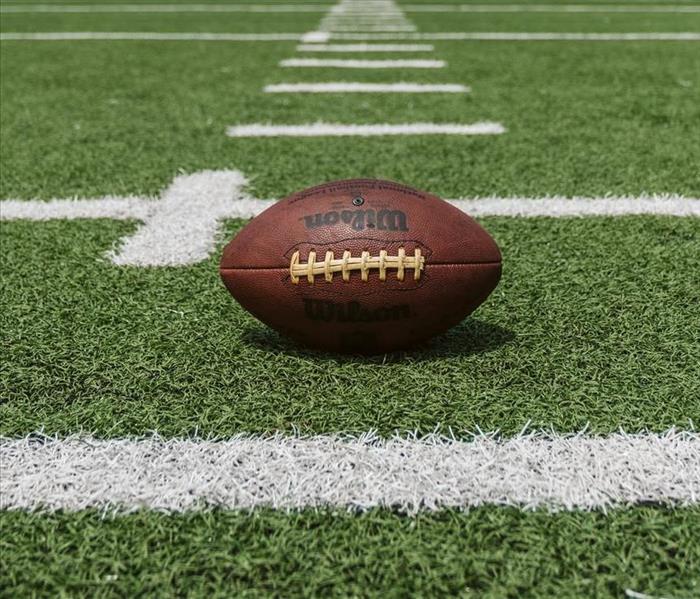 Football is a BIG deal here in Western New York.
Football is a BIG deal here in Western New York.
If you’re from Western New York, or you’ve ever been anywhere near the city of Buffalo on a Sunday, then you know that people here take the NFL very seriously. When the Bills are playing, the whole region is watching. It doesn’t matter how much yardwork you have to do, or if you promised to call your parents on Sunday, or if the dog is begging for a walk – everything’s on pause until the game is over.
That is, unless you’re in the emergency services business. Pipes burst no matter if it’s football season or not. Fires happen even when the Bills make the playoffs. And SERVPRO is here to respond, 24/7/365, faster to any size disaster.
In fact, we were in this exact situation not too long ago. A new loss came in on a Sunday afternoon. As we took the call and spoke to the property owner, he couldn’t help but laugh as he heard “The Bills make me want to shout” echoing from the next building over.
And while the entire city held their breath as the Bills somehow blew a huge lead and let the game come within three points near the end of the fourth quarter, we arrived on the scene of the loss and got to work, because that’s what we do, no matter what.
It doesn’t matter whether it’s Thanksgiving, Christmas or the Bills are in the Super Bowl – when you call us, we answer and we act fast. That’s the SERVPRO of West Seneca/Lancaster promise.
4 Steps to Creating Your Family Emergency Plan
9/1/2020 (Permalink)
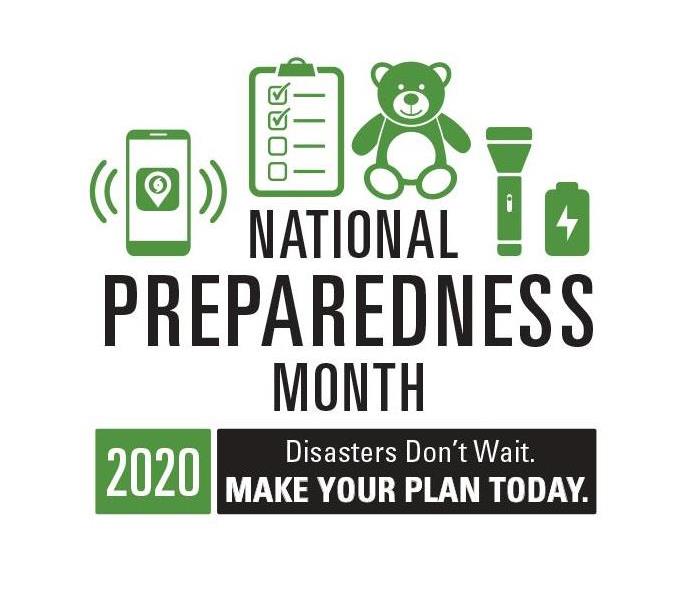 September is National Preparedness Month... are you prepared?
September is National Preparedness Month... are you prepared?
At SERVPRO of West Seneca/Lancaster, we help families deal with disasters every single day.
What’s the key to mitigating damage and distress stemming from a disaster? Being prepared. We’re here to help you do just that.
September is National Preparedness Month, and the heart of being prepared is making a plan. You never know when disaster will strike, so it’s vital that you and your family know what to do when something unimaginable takes place. Do you know where to go? How you’ll contact each other if you’re separated? How you’ll reconnect if you can’t get into contact with each other?
If the answers to these questions aren’t an emphatic “yes,” then you need to make a plan. We’ll go over the basics and link you to the best resources from Ready.gov to get started. While making an emergency plan may sound daunting, it really boils down to four steps.
Ask questions and gather information.
First things first, let’s take stock of where you’re at. Ask yourself the following questions:
- How will I receive emergency alerts and warnings? Often, these come directly to your mobile device as WEAs (Wireless Emergency Alerts).
- What is my shelter plan? Are you prepared to shelter at home for an extended period of time?
- What is my evacuation route? Do you know where to go if you need to evacuate? If you have pets, do you know if they can come with you?
- What is my family/household communication plan? Do you know where to meet if you’re separated when disaster strikes?
- Do I need to update my emergency preparedness kit? Is it easily accessible and well maintained?
- Have I updated my plans to account for the latest guidelines put out by the Centers for Disease Control (CDC) related to coronavirus?
The answers to these questions should guide your next move. Often, we think we’re more prepared than we actually are – make sure you ask yourself a few “what if” questions to really check your preparedness. What if cell phone service is disrupted? What if your family isn’t together when disaster strikes? Knowing what to do in these types of contingencies is important.
Consider your household’s specific needs.
Your plan must be more than thorough – it has to be workable with your family. Everyone has different needs and different strengths that will affect how your plan should be executed. You’ll have to make arrangements for the very old, very young, those with medical needs or disabilities, and your pets. Think about the following as you make your plan:
- Different ages of members within your household
- Responsibilities for assisting others
- Locations frequented
- Dietary needs
- Medical needs including prescriptions and equipment
- Disabilities or access and functional needs including devices and equipment
- Languages spoken
- Cultural and religious considerations
- Pets or service animals
- Households with school-aged children
Sit down and fill out your plan.
Ready.gov has made it simple to actually fill your plan out once you have all of the relevant information gathered – just download their template. Feel free to add any information you think is necessary for your family to be prepared.
Communicate and practice.
Having a plan is great, but your family needs to be ready to put it into action. Call a family meeting to go over the plan with everyone involved in detail. Print out copies that everyone can carry with them when they’re out of the home. Finally, practice what you can! An emergency drill might seem like a weird way to spend your next family evening, but practice makes perfect.
Updating Your Emergency Kit for COVID-19
9/1/2020 (Permalink)
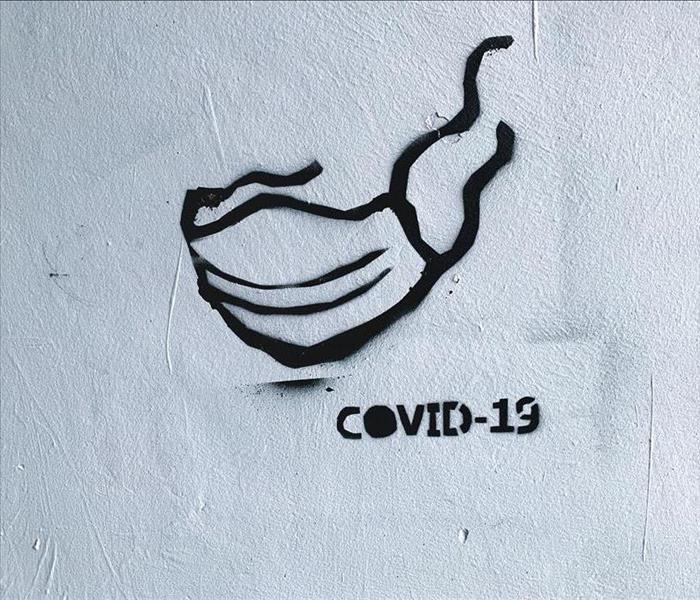 COVID-19 has changed everything, including emergency planning.
COVID-19 has changed everything, including emergency planning.
COVID-19 has changed everything, as we’re sure you have heard on every single TV commercial in the past three months.
As part of National Preparedness Month, we’re here to tell you that coronavirus has also changed disaster planning. Specifically, it may be time to update your emergency kit. The CDC has issued some new guidelines that you should be aware of. We’ll go over the basics, then we’ll touch on the new additions.
Your Core Disaster Supply Kit
To put together a disaster kit, store everything in airtight plastic bags and then stow in an easy-to-carry container. You shouldn’t have more than one or two bins or duffel bags to worry about.
Your classic core supply kit should include the following:
- Water (one gallon per person per day for at least three days, for drinking and sanitation)
- Food (at least a three-day supply of non-perishable food)
- Battery-powered or hand crank radio and a NOAA Weather Radio with tone alert
- Flashlight
- First aid kit
- Extra batteries
- Whistle (to signal for help)
- Dust mask (to help filter contaminated air)
- Plastic sheeting and duct tape (to shelter in place)
- Moist towelettes, garbage bags and plastic ties (for personal sanitation)
- Wrench or pliers (to turn off utilities)
- Manual can opener (for food)
- Local maps
- Cell phone with chargers and a backup battery
New Supply Guidelines Issued by the CDC
The CDC has come out with new recommendations on emergency supplies that may help you to update your own kit. Some have to do with coronavirus, while others are - You should now include the following in your kit:
- Cloth face coverings (for everyone ages 2 and above), soap, hand sanitizer, disinfecting wipes to disinfect surfaces
- Prescription medicines
- Non-prescription medications such as pain relievers, anti-diarrhea medication, antacids or laxatives
- Prescription eyeglasses and contact lens solution
- Infant formula, bottles, diapers, wipes and diaper rash cream
- Pet food and extra water for your pet
- Cash or traveler's checks
- Important family documents such as copies of insurance policies, identification and bank account records saved electronically or in a waterproof, portable container
- Sleeping bag or warm blanket for each person
- Complete change of clothing appropriate for your climate and sturdy shoes
- Fire extinguisher
- Matches in a waterproof container
- Feminine supplies and personal hygiene items
- Mess kits, paper cups, plates, paper towels and plastic utensils
- Paper and pencil
- Books, games, puzzles or other activities for children
Maintaining and Storing Your Kit
Your kit should have a pretty long shelf life, but for best results, keep in a cool dry place and keep any boxed food in tight plastic or metal containers. Replace expired items as needed and plan to revisit your kit once per year as your needs change (perhaps during National Preparedness Month!).
Remember – being prepared is the key to getting through a disaster! Taking the time to create a kit can be the difference between a bad few days and an absolute nightmare.
Review Us on Google, Facebook, or Yelp!
8/26/2020 (Permalink)
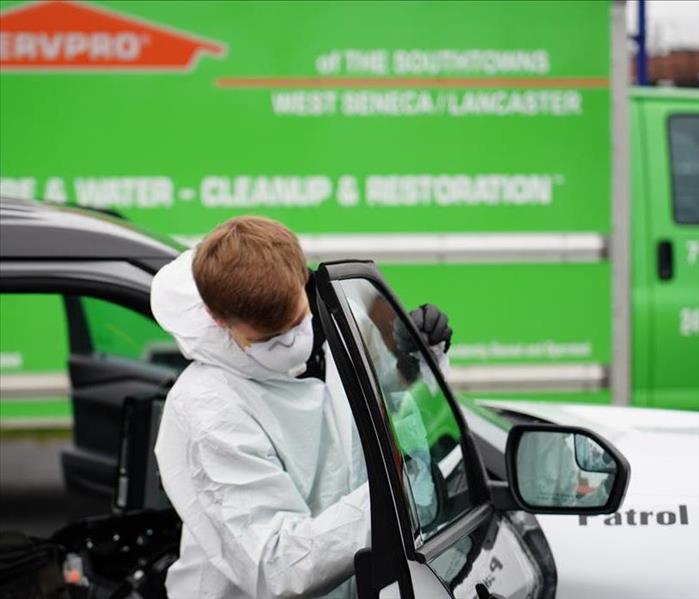 We're here to help when you need us most.
We're here to help when you need us most.
Have you worked with SERVPRO of West Seneca/Lancaster in the past? We’d love to hear what you think!
Leave us a review on Google, Facebook or Yelp and let us know how we did! If you had a less-than-stellar experience, please call 716-646-6684 – we value your feedback and would love a chance to make things right.
Here are some of the things our past customers have said:
“Call SERVPRO of West Seneca/Lancaster for all your restoration needs ......great people, knowledgeable staff ......”
“The workers were very helpful and friendly. I waited for the knock on the door every day. The office staff was a great help to me. “
“Very happy with everyone. You have some good eggs representing your business. They are great people to go out and be the face of the company.”
“I am impressed with the professionalism show by SERVPRO. They are very helpful, and I will be referring them to my friends. Thank you very much for your assistance and it is greatly appreciated.”
“The on-site personal was very knowledgeable, efficient without being brisk. We were always informed when to expect them during the day. The steps of remediation were laid out for us prior to beginning the process. The office staff did an outstanding job of keeping us informed of the status and the timelines. I would recommend this SERVPRO to anyone in need of their services. “
Thanks again for trusting SERVPRO of West Seneca/Lancaster, and please leave us a review on Google, Facebook or Yelp to let us know how we did!
Faster to Your Commercial Water Loss in WNY
8/14/2020 (Permalink)
 As soon as water enters your structure, the clock starts ticking. That's why we have the 1-4-8 Service Guarantee.
As soon as water enters your structure, the clock starts ticking. That's why we have the 1-4-8 Service Guarantee.
As Western New York’s leading restoration company, we have the resources and the personnel to service the largest commercial water losses in the area.
Mitigating water damage effectively means drastically reduced costs for the businesses we work with, as well as minimal disruption to their day-to-day operations. Providing this level of service isn’t just about training our staff and stocking equipment, however.
In fact, three little numbers are the key to our success: 1, 4 and 8.
Our 1-4-8 Service Guarantee is our promise to our customers to provide timely mitigation to control damage, downtime and recovery costs.
What is the 1-4-8 Service Guarantee?
It’s simple. We’ll give an example – imagine that your business floods at 1 a.m. and you call SERVPRO of West Seneca/Lancaster at 716-674-1103.
Within 1 hour, we’ll have contacted you to arrange for service. So by 2 a.m., you’ll already have the beginnings of a mitigation plan in place.
Within 4 hours, we’ll be on-site to start emergency mitigation services. So by 5 a.m., our crews will already be in place to minimize the damage. It’s difficult to overstate just how important these emergency services are. The longer water damage sits, the worse it gets, so starting mitigation within a four-hour window can often save our customers thousands.
Within 8 hours, we’ll brief you on the scope of the damage and our plan for full mitigation and restoration. So by 9 a.m. the next morning, you’ll already have a full plan in place for making your loss “like it never even happened.” Before your employees get settled for the day, you’ll be able to share with them your plan for getting their lives back to normal.
When you suffer a commercial water loss, you can’t afford to wait for service. That’s what our 1-4-8 Service Guarantee is for. Save our number in your phone – 716-674-1103 – and we’ll be there if and when you need us.
Summer's the Perfect Time for Fire Safety!
7/9/2020 (Permalink)
 Summer's the time to teach your children about fire safety.
Summer's the time to teach your children about fire safety.
No season is a good season for a house fire, but summer is perhaps the best season to educate your family on fire safety. With kids out of school and families spending more time at home (especially with the current quarantine situation), there’s no reason why you shouldn’t take an hour or two to talk fire safety in the evening. After all, you’ve probably talked about just about everything else under the sun, and finished everything on Netflix – what else do you have to do to kill the time?
Your fire safety discussion doesn’t have to be a long, involved ordeal. In fact, there are just a few basic things that everyone in your home needs to know to stay as safe as possible in the unfortunate event of a house fire:
- Everyone, especially children, should know exactly what your smoke and carbon monoxide alarms sound like when they go off;
- Everyone should also know what to do when those alarms go off;
- Teach each member of your family two ways to escape from each room – usually a door and a window;
- Establish a designated meeting point and communication plan so everyone knows what to do when they get out of the house;
- Run fire drills at your home at least twice per year;
- Show children how to dial 9-1-1 and teach them what to say to an operator;
- Finally, make sure everyone knows how to stop, drop and roll!
Sure, going over all of this information is no one’s ideal summer evening, but it could save someone’s life. Plus, it can be kind of fun to pretend to stop, drop and roll if you get into the spirit of what you’re doing!
And if you do have to deal with a home fire, don’t forget that we’re here to help at SERVPRO of West Seneca/Lancaster – just call 716-674-1103 when you need us.
Gas Grill Safety for the Summer
7/9/2020 (Permalink)
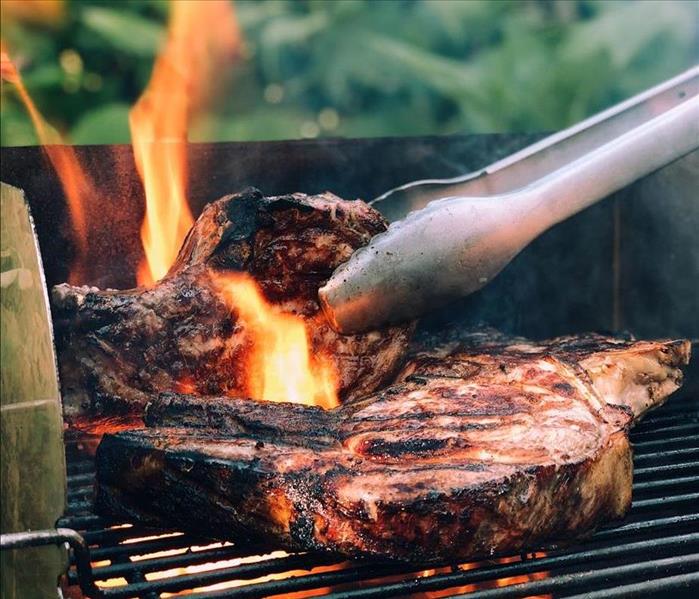 Nothing beats grilling in the summer - just stay safe.
Nothing beats grilling in the summer - just stay safe.
It’s summertime, and at the time of writing, we’re approaching heat indices of over 100 degrees here in Western New York. Nobody wants to get stuck in the kitchen in that kind of weather, so many people are either ordering takeout or firing up the grill in the backyard. And while everyone loves gathering around the grill and flipping burgers, you have to remember that gas grills can be a huge fire hazard if not handled safely.
How do you grill safely? We’ll tell you.
Propane Tank Safety
The propane tank is a big potential hazard, especially since many people rent their tanks from gas stations and convenience stores. Those tanks are not always thoroughly checked and repaired before they’re rented back out, which can lead to issues for home grillers.
Check your tank before use for damage, wear, rust and dents. If you find damage, do not use that tank. If you’re filling the tank yourself, you should also be sure that you don’t overfill it.
Even if your tank isn’t damaged, you should still be careful with placement. Keep the tank at least 10 feet away from anything combustible and keep children away from it as well. When not in use, keep the tank outdoors an in upright position, but move it away from your grill just to be safe. You should also ensure that the valve is turned to the “off” position.
Gas Grill Safety
Before you start to cook, make sure your grill has no gas leaks. To check, spray soapy water on the grill fitting and switch the gas on. If you see bubbles forming, that means there’s a leak and that you should refrain from grilling until it is fixed. Even if the grill fitting is fine, there may be leaks on the hose – check there as well.
Make sure your grill is clean before you fire up the flame. Everything from old food grease to dead bugs can cause blockages in your grill, which can lead to serious issues as you cook. The grill should be set in a level, well-ventilated outdoor space to ensure proper circulation. If you have proper ventilation and you still smell gas, get away from the grill, grab a fire extinguisher and call the fire department – you might have a leak on your hands.
Hopefully, by following these tips, you’ll prevent any issues with your gas grill. However, if you’ve got fire or smoke damage stemming from a grill fire, we’re here to help – call SERVPRO of West Seneca/Lancaster at 716-674-1103 today!
Restoring Your Ducts & HVAC After a Fire
7/9/2020 (Permalink)
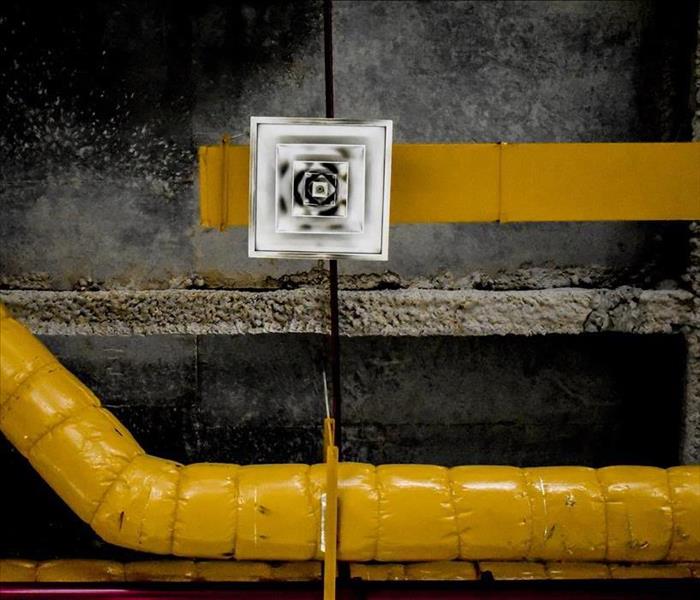 Lingering smoke odor? It might be in your ducts.
Lingering smoke odor? It might be in your ducts.
Imagine a fire in your home. Terrible, right? You’re probably imagining flames on the wall, smoke pooling on the ceiling, and soot on the floor after the fire’s put out.
Now imagine fire restoration and cleanup like we provide at SERVPRO of West Seneca/Lancaster. You’re probably imagining technicians with scrub brushes cleaning up the soot, picking up the debris and reconstructing the damaged areas.
Sure, all of that can happen. But we don’t just stop at what’s visible on the surface. We go deeper to ensure that your home or business is returned to preloss condition. And one of the places where we focus in particular is your HVAC and duct system.
Why focus on ducts after your fire?
Why do we pay so much attention to ductwork, air registers and HVAC units after a fire? Because these are places where soot can spread unseen. They’re also potential sources of lingering smoke odor, which can be enormously difficult for homeowners to eliminate on their own. By cleaning these systems, we prevent soot and odor-causing particles from circulating throughout the house and contaminating areas that may have been far away from the fire itself.
Aside from smoke and fire damage, ducts can also be potentially damaged by water as well. When a fire department cranks up their hoses to extinguish some flames, it’s inevitable that water will get all over your home or business. That moisture can easily get inside your ducts, promoting mold and mildew that are hidden from plain view and compromising your indoor air quality. We don’t just restore fire damage – when necessary, we lead the industry in restoring water damage after a fire as well.
When you need restoration, cleanup and repair after a fire, you have plenty of choices. Why choose SERVPRO of West Seneca/Lancaster? Because the attention to detail that we pay to your ducts and HVAC system is the same attention to detail that we pay to your entire property. If you want to make your fire “Like it never even happened,” call us today at 716-674-1103.
8 Emergency Tips After a Fire
7/9/2020 (Permalink)
 Fires are traumatic. Take care of yourself and your loved ones.
Fires are traumatic. Take care of yourself and your loved ones.
Fire damage can be devastating in a home or business. The resulting water damage from extinguishing the fire just makes things worse. Because of all this stress, it can be extremely difficult to act rationally immediately following an emergency. Emotions run high and it’s very easy to make a mistake that can have lasting consequences. That’s why we’ve come up with 8 emergency tips for you to follow right after your fire and water loss. Before we get there, keep the following in mind:
- Get permission from the fire department before you attempt to re-enter the home.
- Inform your utility, insurance and restoration companies of the fire.
- To the best of your ability, try not to move around your home too much. No matter how careful you are, it can be very easy to spread soot particles and cause additional damage, as well as cause smoke smell to linger longer in rooms that may have been far removed from your fire.
- From whatever vantage points you can access, photograph and document the damage.
- Remove the contents of affected areas as soon as you can. If possible, get them outside into the sun so that they can air out and dry if necessary.
- If your power is out, empty your freezer and refrigerator and keep the doors propped open. Try to find another home for anything perishable before it begins to spoil.
- Extract any water that you can by mopping and blotting. The more water you can get out, the simpler and more affordable the restoration process will be.
- Take care of yourself, your loved ones and your pets. Fires can be an extremely traumatic experience.
If you’re dealing with a home or business fire in the West Seneca or Lancaster area, give us a call 24/7/365 at 716-674-1103 – we’re here to help!
How to Use a Generator Safely During a Storm
7/9/2020 (Permalink)
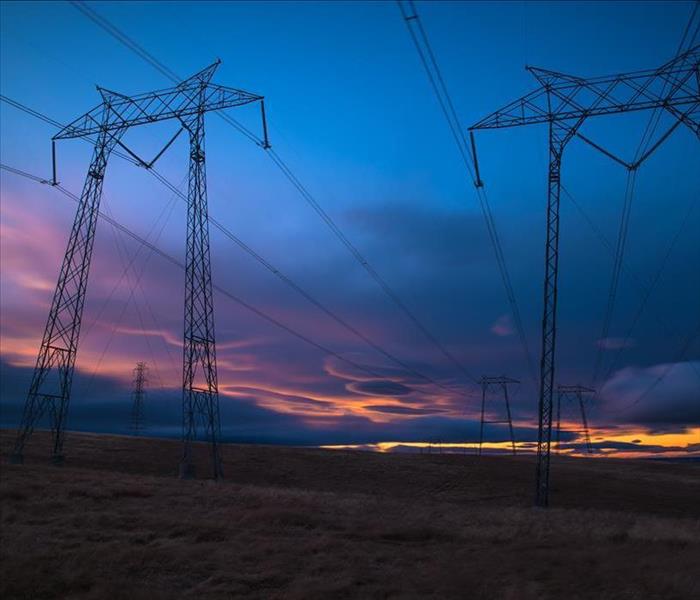 Are you prepared for a power outage?
Are you prepared for a power outage?
Western New York isn’t exactly Tornado Alley, but we’ve dealt with our fair share of severe thunderstorms this summer, and we can be certain that we’ll see plenty of punishing blizzards when winter finally rolls back around.
For this reason, it’s vital that you and your family are prepared for the worst, including prolonged power outages at your home. One tool that many find essential is the portable generator.
Portable generators allow you to power electronics even when your electricity has been knocked out by storm damage. While some families find them to be a luxury, others rely on generators to get them through power outages safely and sanely.
If you do invest in a generator, keep the following safety tips in mind:
- Many portable generators are powered by gas, which comes with a special set of risks and hazards. Never use your generator (and for that matter, any grill, camp stove or other gas/propane/charcoal powered device) inside your home, garage, basement, crawl space or location that is partially enclosed.
- Generators also carry the risk of electrocution, and that risk can be exponentially greater in a storm situation where there’s an increased risk of flood. Keep your generator dry and do not use it in wet conditions under any circumstance. Keep it under an open canopy (like a tarp held up on poles). Definitely avoid touching the generator if your hands are wet.
- Finally: even if you’re operating the generator according to these safety guidelines, there are still risks you need to protect yourself from, like carbon monoxide. If you plan to use a generator, make sure that there are carbon monoxide alarms on every level of your property, as well as outside sleeping areas, to ensure early warning if anything goes wrong.
Generators are great tools to have in a storm situation – just make sure you can use them safely. And if you’re dealing with any storm damage or flooding, give us a call at SERVPRO of West Seneca/Lancaster at 716-674-1103 – we’re here to help!
7 Tips for Winter Storm Prep in Western New York
7/9/2020 (Permalink)
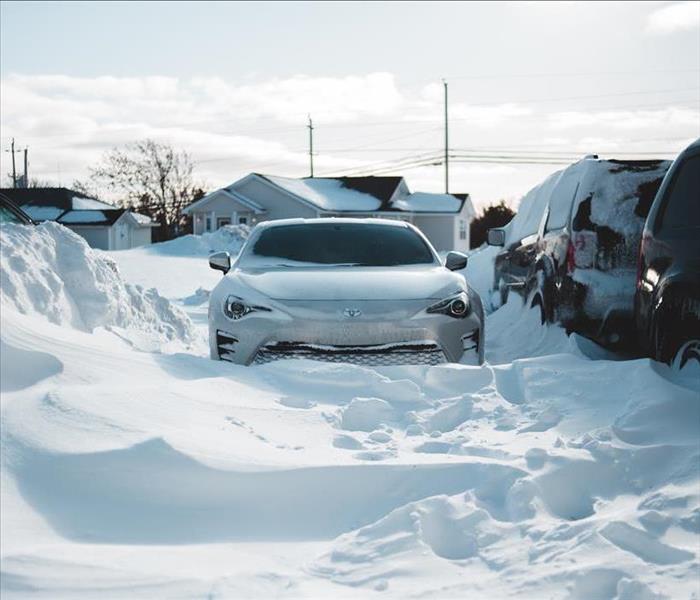 Don't let this happen to you.
Don't let this happen to you.
Western New York is famous for its snowfall, and while every winter won’t have a “Blizzard of ’77” moment, you can be reasonably sure that we’ll have at least a handful of disruptive snowstorms every year.
With that in mind, then, preparing for a severe snowstorm isn’t about preparing for something that might happen – it’s about preparing for something that will happen.
With that in mind, the team here at SERVPRO of West Seneca/Lancaster came up with seven tips to help you to prep for any winter storm that comes your way.
- Have an open conversation with your family about what to do if a winter storm watch or warning comes out. Should everyone come home and hunker down? Planning is especially important if you have teenage children who may not be home or easily accessible when weather alerts are issued.
- Winterize your vehicle when cold weather rolls around to reduce your risk of being stranded.
- You should also check your vehicle’s battery, antifreeze, lights, hazards, oil, wipers and wiper fluid. Employ a professional to check other systems, like the ignition, exhaust, thermostat, heat, brakes and defroster.
- Keep an emergency supply kit in your car which includes a scraper, a small broom, waterproof matches, warm clothing, blankets and anything else you might need if stranded.
- Keep your gas tank full at all times.
- Keep your phone charged at all times.
- Even if you’re just running out of the house, wear a warm coat, gloves and hat in case you get stuck or stranded.
You might like the snow, but no one likes to deal with the problems associated with a blizzard. Follow these seven tips to stay safe and call SERVPRO of West Seneca/Lancaster if you need us – we’re here to help!
Lightning Safety in Western New York
7/9/2020 (Permalink)
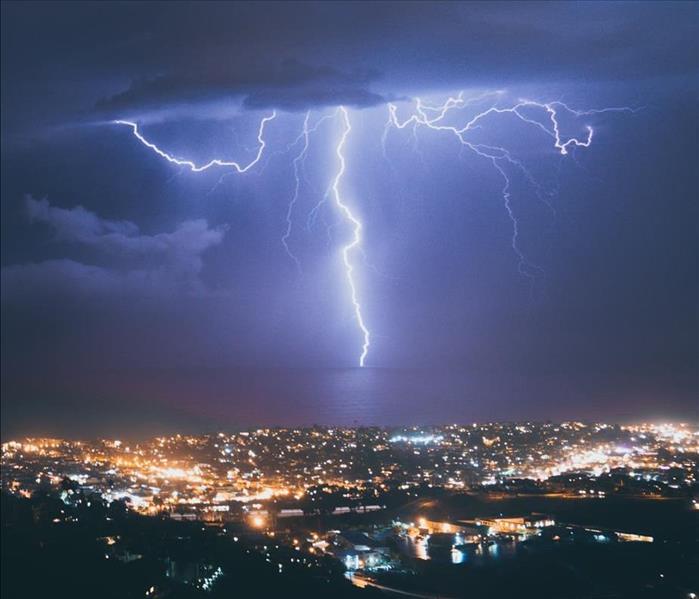 Cool? Yes. Dangerous? Very.
Cool? Yes. Dangerous? Very.
Lightning can be pretty cool to watch, and an all-out electrical storm is downright breathtaking. But just because you like to watch thunderstorms roll into Western New York doesn’t mean that you should throw caution to the wind. Lightning strikes about 51 people per year, according to the National Oceanic and Atmospheric Administration, and you don’t want to be one of them.
The easiest way to avoid lightning is simply to stay inside during a storm. However, if you absolutely need to go outside during a thunderstorm, consider the following.
Staying Safe Outdoors During Lightning Strikes
If you hear thunder, you really should go indoors, or at least get under a safe, enclosed shelter. Use the 30-30 rule to judge how much you have to rush. Once you see lightning, start counting to 30 – if you hear thunder before you hit 30, hightail it indoors and wait until 30 minutes after you hear the final clap of thunder to go back outside.
Can’t find indoor shelter? You can still try to be safe. Crouch low with as little of your body touching the ground as possible, as electrical currents can travel over 100 feet through the surface of the ground.
Staying Safe Indoors During Lightning Strikes
Even if you get inside, you’re not necessarily safe during a serious lightning storm.
Stay away from water during a severe thunderstorm, as lightning can travel through plumbing. Avoid electronics as well – lightning can also travel through electrical systems, and even through corded phones.
Avoid concrete floors and walls as well. They contain metal wires and bars that can conduct electricity towards you.
If your home or business is damaged during a thunderstorm, don’t hesitate to call SERVPRO of West Seneca/Lancaster at 716-674-1103 – we’re here to help!
Cleaning Contaminated Floodwater Damage After a Storm
7/9/2020 (Permalink)
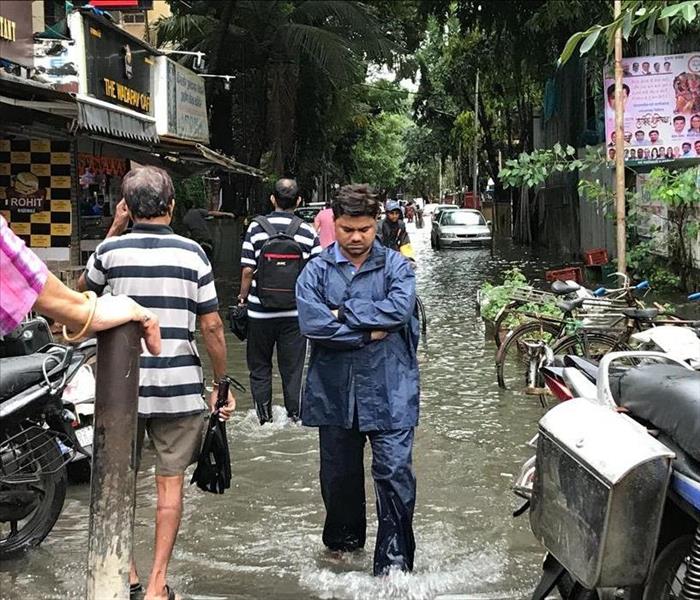 We know how you feel. Floods are no fun.
We know how you feel. Floods are no fun.
Contaminated groundwater, referred to as “category 3,” can devastate a home even more than your average water loss. This contaminated water will destroy anything that absorbs it, and that damage will get exponentially worse the longer it takes you to get rid of it. Often, this type of water gets into the home during a storm, when water is liable to flood into your property, especially your basement.
But what’s so bad about flood water? What kind of damage can it cause? And how do you get rid of it? We’ll tell you.
What’s so bad about groundwater in a flood?
The worst thing about the water that flows into your property during a flood isn’t the water – it’s what the water brings with it. Rushing waters pick up all sorts of contaminants on their way to your home or business. These contaminants include the obvious, like mud and debris, but can also include viral pathogens, toxins and even sewage that has backed up out of drains. You don’t want any of these things flowing into your property.
What’s worse, water has a tendency to spread far beyond the initial point of entry. Water can be absorbed in all kinds of hard-to-reach places, like under tile, behind baseboards, and deep into carpet and subflooring. This tendency is especially harmful because once that water enters your home, the clock starts to tick. The faster you can get that water out and off of your floors, the less damage there will be. SERVPRO techs excel at completely extracting water and drying affected materials, even in the hard-to-find areas.
How do you clean and restore groundwater damage?
Since groundwater is often contaminated, our technicians often wear protective clothing, eye protections and respirators to keep pathogens from being ingested or inhaled. In some cases, they may also apply certain treatments before the mitigation process begins for maximum safety.
We often begin the process with controlled demolition. Porous materials that are contaminated are difficult to sanitize completely, meaning that it’s often more affordable and more efficient to tear them out and focus on reconstruction.
The amount of demolition depends on the material. With sheetrock and drywall, for instance, our technicians often have to cut in several inches above the waterline to both remove any damaged material and open up the cavity of the wall for drying.
Grouted, sealed ceramic tile, meanwhile, usually fares better, since it can keep out much of the contaminated groundwater. Adhesive tiles, meanwhile, may not be so lucky, though we can often remove, clean and reuse those tiles to save home and business owners money.
Contaminated carpets fare worse. Saturated carpet can almost never be sanitized to an acceptable level for reuse and is usually cut out and disposed of as a biohazard. Anything that is disposed of is documented for insurance purposes.
Once demolition has been completed, drying can begin. Assuming that tile and carpet has been removed, our team will then focus on drying the subfloor completely while it is exposed. Usually, this entails the use of drying mats, forced air flow, Injecti-Dry systems and other industry-leading techniques to completely dry the subfloor before tile and carpet is reinstalled and reconstruction begins in earnest.
But it’s not just your structure that can be contaminated by groundwater. Your possessions can be exposed to dirty floodwater as well, with mixed results. Anything that’s porous will likely need to be disposed of, as it will not be able to be acceptably sanitized. Non-porous items, meanwhile, especially those that can be subjected to immersion cleaning, more often have positive outcomes. Our array of proprietary cleaning agents, biocides, and antimicrobial solutions help us to achieve the best outcomes possible for our customers.
Dealing with a flood or water loss yourself after a storm? We’re here to help. Call SERVPRO of West Seneca/Lancaster at 716-674-1103 when you need us!
7 Steps to Take After a Storm Damages Your Home
7/9/2020 (Permalink)
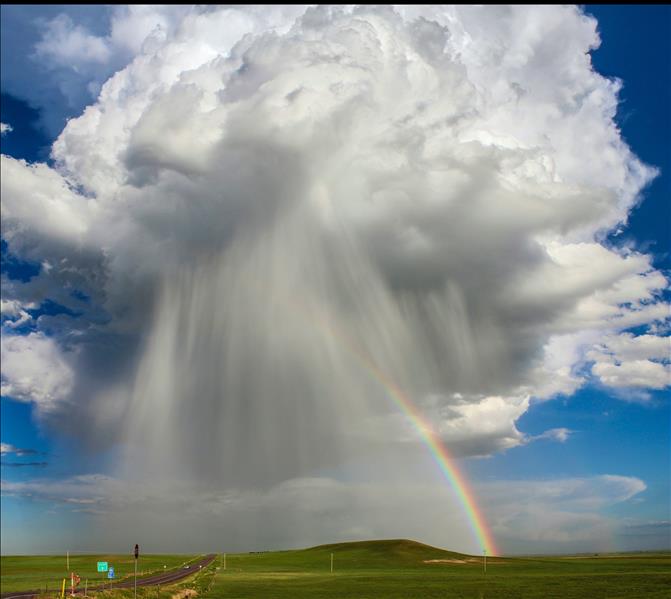 Storms can be pretty cool, until they cause damage.
Storms can be pretty cool, until they cause damage.
Severe thunderstorms, along with blizzards, are a perennial concern here in Western New York. They bring enormous amounts of precipitation along with high winds and hazardous conditions for travel, which in turn can cause serious damage to your home and property.
Has your home been damaged seriously in a storm? Here are six things you should do immediately.
Find somewhere to stay.
If there’s been structural damage to your home, it’s likely not safe to stay there until that damage has been repaired. A few minor issues are one thing, but if you have a collapsing roof, collapsing walls, damaged windows or standing water in your home, you need to find alternative lodging.
Shut off the gas.
If you have any reason to believe that your gas lines have been punctured, shut off the gas ASAP. Usually, you’ll notice a problem when you smell gas pervading your home. Trust your senses – switch the gas off.
If there’s standing water, turn off the electricity if possible.
We all know that water conducts electricity. What you might not realize is that storm damage can expose standing water in your home to electricity without you noticing. If there’s any standing water, avoid stepping in it until you can safely turn your electricity off.
Watch out for dangerous debris.
As you navigate your home, electricity and standing water aren’t the only thing you have to worry about. Watch out for things like broken glass, newly exposed nails any anything else sharp that you might not be expecting.
Take as many photos as you can.
Assuming you can safely move around your home, take as many pictures of the damage as you can. You’ll need them as a record when you speak to your insurance company.
Call your homeowner’s insurance agency.
Call your insurance agent ASAP to inform them of the damage to your home. This will enable them to get the ball rolling on a claim so that you can receive payment ASAP for repairs.
Call the restoration specialists at SERVPRO of West Seneca/Lancaster.
Your insurance agent will agree – getting a restoration company involved as early as possible is the key to not only reversing your storm damage quickly, but keeping costs down as well. Call SERVPRO of West Seneca/Lancaster 24/7/365 at 716-674-1103 – we’re here to help!
Removing Water After Prolonged Damage in West Seneca
7/8/2020 (Permalink)
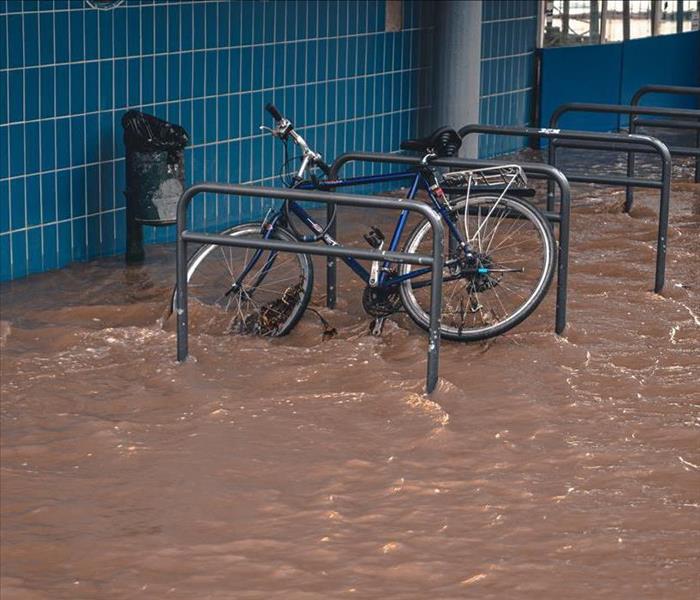 You don't want your basement to look like this.
You don't want your basement to look like this.
Water damage can happen anywhere, but we encounter quite a bit in West Seneca. Often, the core issue is this: there’s a huge storm or snow melt that causes a ton of water to go into local drains, which then get backed up into people’s homes and businesses.
What’s worse is that sometimes, this water can sit for days on end without anyone noticing. Imagine you’re away for a week on vacation and you come back to find standing water in your basement – what could be worse? The longer water stands, the more extensive and serious the damage from that water will be, especially since water is capable of migrating far past its initial point of entry.
That’s when people call SERVPRO of West Seneca/Lancaster, their local water damage pros. Our extensive experience in mitigation and restoration, along with our industry-leading tools and techniques, enable us to restore your home or business to preloss condition even if water has been standing for a long time. Here’s how we do it.
Surface Water Extraction
First things first: we need to extract the water that’s standing on the surface of the floor and any other materials. Much of that moisture has probably already been absorbed, but we need to stop further absorption from occurring, and we also need to be able to get accurate readings on the moisture content of your surfaces. Most of the time, our go-to tools are pumps and wet vacuums to extract that water.
Controlled Drying
Once the water is extracted, now it’s time to dry. Effective drying is about more than installing a few fans and dehumidifiers and calling it a day. Especially when dealing with concrete and hardwood floors, drawing out moisture can be extremely complicated. We’re especially careful not to remove water too quickly, as this can damage the material. By continuously monitoring the rate of moisture removal, we can dry your materials as quickly as possible without incurring further damage.
Demolition and Reconstruction
If water sits in a structure for too long and gets absorbed, that structure may unfortunately become too weak to preserve. Standing water also promotes mold growth, which can lead to additional health issues in the long run.
Because of this, SERVPRO of West Seneca/Lancaster also offers demolition and reconstruction services. Once we’ve extracted and dried your property, we’re able to rebuild anything that’s been destroyed to get you back to preloss condition. It’s just one more way we make it “Like it never even happened.”
More questions about water damage? Need us to come and take a look at a loss? Give us a call at 716-674-1103 – we’re here to help!
Water Damage Restoration in Lancaster, NY
7/8/2020 (Permalink)
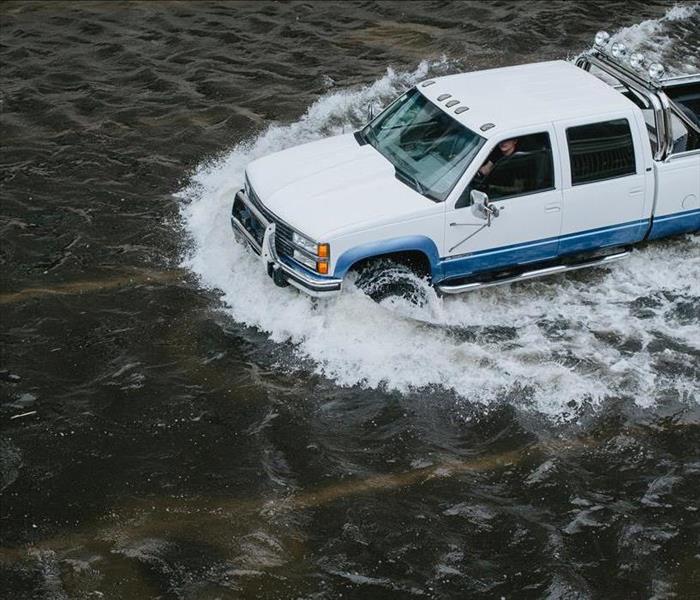 Don't try this at home.
Don't try this at home.
Can SERVPRO of West Seneca/Lancaster help with your water damage issues?
Short answer: yes! We help a ton of businesses all over the region whenever they have issues with flooding, backed up drains and property damage stemming from water. When a home or business owner discovers water in their basement, we’re often their first phone call, which is smart – if water is allowed to sit for too long, it can promote mold growth and lead to lasting structural damage.
What exactly do we do? And how exactly do we do it? We’ll tell you.
Common Types of Water Damage We Deal With
Every water loss is unique, but here are a few of the most common issues that we help people in Lancaster and West Seneca out with:
- Storm damage and flooding;
- Burst pipes, especially in winter;
- Backed up sewer lines and drains;
- Washing machine and sink overflows;
- Toilet and bathtub links;
- Damage after firefighting.
Those are just some of the most common calls that we get, but you can rest assured that if you’re dealing with water damage, we can help.
How We Clean and Restore Water Damage
Our water damage specialists create customized extraction, drying and reconstruction plans for every customer. They have the training and experience to provide the highest level of service available in the West Seneca and Lancaster areas, performing detailed inspections and assessments before getting to work.
Overall, they roughly follow this process:
- Extract any standing water from the property;
- Remove affected contents for drying;
- Utilize industry-leading industrial drying equipment to extract moisture as quickly as possible without causing lasting damage to materials;
- Reconstruct any materials that cannot be returned to preloss condition;
- Clean, sanitize and disinfect the space.
Once we’ve walked through that process, you’ll see for yourself why we pride ourselves on making your water loss “Like it never even happened.” If you need us, we’re here to help – call 716-674-1103 today!
Maintaining Your Basement to Minimize Water Damage
7/7/2020 (Permalink)
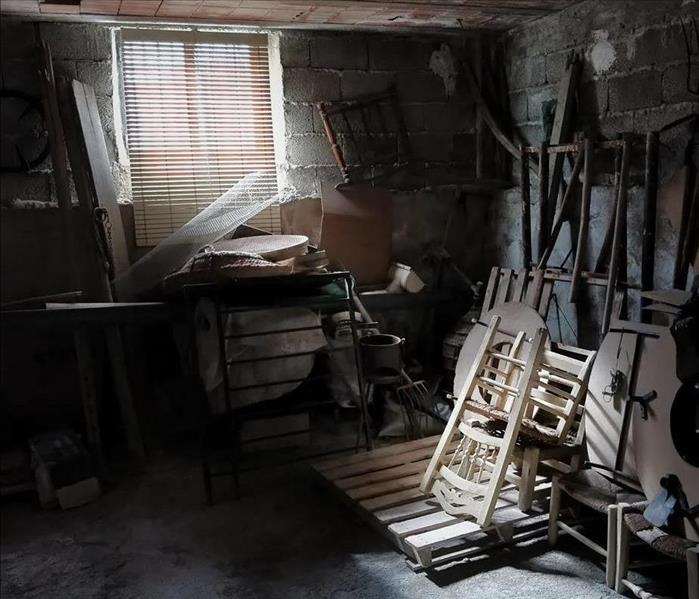 You don't want water getting into your basement.
You don't want water getting into your basement.
Here in Western New York, we’ve already dealt our fair share of storms this year and we can expect to see even more once winter rolls around. Every time that there’s a storm, we get a huge influx of calls here at SERVPRO of West Seneca/Lancaster. Most of the time, these calls are about water damage in a basement.
Why do we see so much water damage in basements? Because water tends to flow to the lowest point it can find. If it can make its way into your basement, it will, causing not just flooding but structural damage and issues with mold as well.
How can you minimize the risk of water damage in your basement? Here are three tips.
Maintain Your Gutters
Your gutters are designed to keep water away from your house, but if they’re not maintained correctly, you can run into serious trouble. Clean your gutters regularly to ensure that they’re not clogged with leaves or other debris. Make sure gutters are attached properly to your house. Finally, run a hose on your roof to check for proper drainage and leaks.
Inspect and Replace Caulking
If your caulking is deteriorating, replace it. Scrape out any eroding caulk and then recaulk as needed. Caulk is sometimes all that stands between water outside your home and water in your basement.
Check Your Sump Pump
When’s the last time you checked on your sump pump? You may take for granted your sump pump’s ability to extract water from your basement, but if it is not properly maintained, it can fail when you need it most.
Testing your sump pump is easy – just remove the lid and slowly pour water down into the well. If your sump pump is working normally, it will turn on once the well is filled, complete a cycle and turn itself off. If that doesn’t happen, then you have a problem.
Of course, no matter how prepared you are, water damage can still happen. If you’re dealing with water damage in your basement, give us a call at 716-674-1103 – we’re here to help!
Sink Overflow? We Can Help!
7/7/2020 (Permalink)
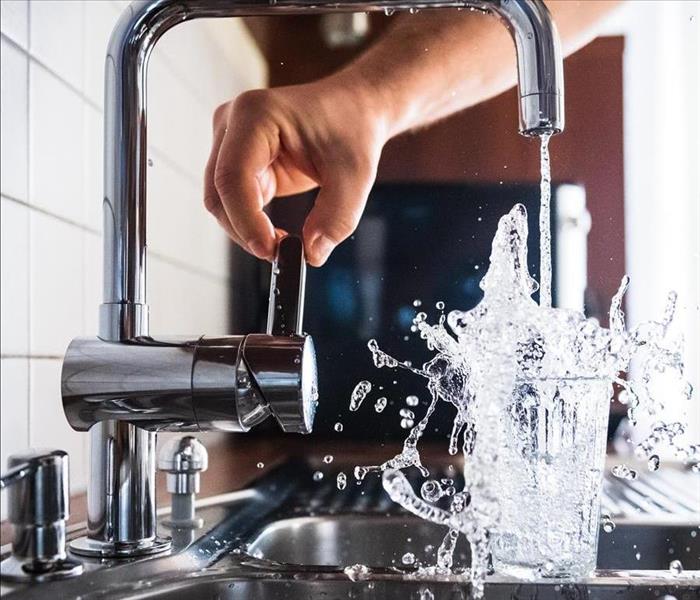 Your sink overflowed. What should you do next?
Your sink overflowed. What should you do next?
An overflowing sink is more than just an inconvenience – it can be a total disaster for your home or business. A sink that is clogged or left running can lead to major water damage if not taken care of quickly. If you want to prevent this kind of damage, follow these prevention and cleanup tips.
How to Prevent Sink Overflows
The best thing you can do to prevent a sink overflow is to stop your drain from getting clogged up in the first place. Just because something can go down the drain does not mean that it should go down the drain.
Food scraps, for instance, should be kept out of the sink as much as possible. If you don’t already have a strainer in your sink drain, get one. You should throw out as much food as possible before dishes end up in your sink, especially things like coffee grounds, pasta, rice and fibrous foods, which are notorious for clogging up drains. The strainer should be able to catch everything else fairly easily – just make sure you keep it clean.
Grease, on the other hand, won’t be caught by a strainer because it runs clear and fluid when it gets hot. It’s only after the grease cools down and becomes gummy that it can pose a problem for your drains, building up on the sides of your pipes over time to create serious clogs. Instead of pouring grease down the sink, place it in a sealable container and throw it in the trash.
On top of food and grease, hair can often clog sink drains up, especially in the bathroom. While a few hairs won’t ruin your sink, a tangled clump of hair can become one of the most stubborn clogs imaginable. A bathroom sink strainer will allow you to throw hair in the trash where it belongs.
How to Clean Up a Sink Overflow
First and foremost, make sure that no more water is overflowing – you don’t want the problem to get worse before you start to make it better.
Your first priority is extraction. Mop up as much of the water as you can, paying special attention not just to your floors but to pantries and cabinets that may also have let water in as well.
Once you’ve removed as much water as you can, move on to drying. Open all cabinets so they can get some airflow, then get as many fans as you can find and start running them in the affected area. Keeping the air moving is vital for drying.
Once everything’s dry, go through and clean all surfaces with an antibacterial cleaner. Even if the water that overflowed was clean, you want to be sure that there won’t be any bacterial or mold growth over time.
Even if you follow these steps, though, there’s a chance that it won’t be enough. Water can very quickly get under floors and behind walls in a way that’s extremely difficult for the average homeowner to detect and reverse. If you’ve suffered serious water damage caused by a sink overflow, give us a call at 716-674-1103 – we’re here to help!
At-Home Fire Drills Save Lives!
7/7/2020 (Permalink)
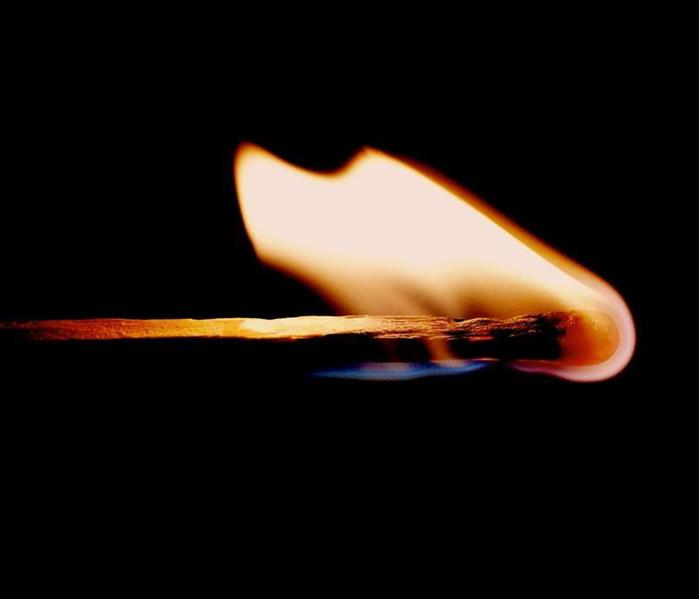 Does your family have a fire plan?
Does your family have a fire plan?
Remember doing fire drills in school? If you were like most kids, you probably got sick of them pretty quickly. “Why do we have to practice walking out the door?” you might have asked. “Anyone capable of thinking knows to get out when there’s a fire.”
Here’s what you probably didn’t realize as a kid: not thinking is the point. You need to be able to act fast in an emergency when you don’t have time to think. Having a fire drill once a month for 12 years enables you to do that.
You should have a family fire plan for the same reason. If there’s a fire in your home, every member of your family member needs to know what to do without thinking or communicating with the others. Since many of us are still quarantined at home for the moment, right now is the perfect time to sit down with your family and hash out a fire plan. Here’s how you do that:
- First things first: install smoke alarms in every sleeping room, outside each sleeping area, and on every level of the home. Advance warning from an alarm is key to getting out of a fire unscathed.
- Test those alarms on a regular basis.
- Draw up a map of your home that shows all doors and windows.
- Find two ways out of every room. Ensure that all doors and windows open easily.
- Designate a meeting place in front of your home so everyone knows where to find each other.
- Save the fire department’s phone number in everyone’s phone.
- Review the plan, in detail, with everyone in the family.
- Practice!
While holding your own fire drill may not sound like your idea of lockdown fun, it could save lives, and it shouldn’t take too long to do.
Preventing and Putting Out Grease Fires
7/7/2020 (Permalink)
 Cooking is fun... until it isn't.
Cooking is fun... until it isn't.
Kitchen fires make up a huge percentage of house fires every year, and grease fires are one of the most dangerous types. If you cook at home (and who doesn’t?), you need to know what to do to prevent and put out a grease fire if it happens to you. The tips below could just save your life.
How to Prevent a Grease Fire
The key to preventing grease fires is being clean and being attentive. As long as you’re a conscientious home cook, you should have no problem preventing a grease fire from becoming an issue.
First, make sure your stovetop is clean and cool before you start cooking. If there are any spills, wipe them up before you start heating anything.
You also need to know your cooking oils. Some oils can take more heat than others when cooking. If you see smoke coming from you cooking oil, remove the pan carefully from the heat source so that the oil can cool down a bit before continuing.
Avoid heating oils too much before dropping food into the pan. When you do put food into the pan, use a utensil that allows you to place the food carefully onto the cooking surface without a big splash, like a pair of tongs.
If you’re deep frying your food, make sure to use a container that’s big enough to fry your food without spilling oil. If you’ve never deep fried anything before, don’t go it alone – have an experienced cook show you the ropes.
If you do spill oil, carefully clean the spill up as soon as possible. You may need to remove food from the pan, turn off the heat and wait, but that inconvenience is preferable to a fire.
Finally, do not add water to grease – you’ll likely cause oil to splatter everywhere, which might cause a fire but will definitely cause a mess.
How to Put Out a Grease Fire
First, turn off the heat. You don’t want to make things worse and you definitely need things to start cooling down.
Whatever you do, DO NOT pour water on the grease fire. This might be your first instinct, but it’s the worst thing you can do. Water and oil do not mix – instead of putting out the fire, you will cause flaming oil to splatter everywhere, making things much, much more dangerous.
Instead, try to smother the flame with another pot or baking pan. If you can’t do that, dump lots of baking soda on the fire. If the flame gets out of control, get out and call the fire department – they’re here to help. And if you need help restoring your kitchen after your grease fire, give us a call at 716-674-1103 – we’re here to help as well!
Storm Damage in WNY? We're Here to Help!
7/7/2020 (Permalink)
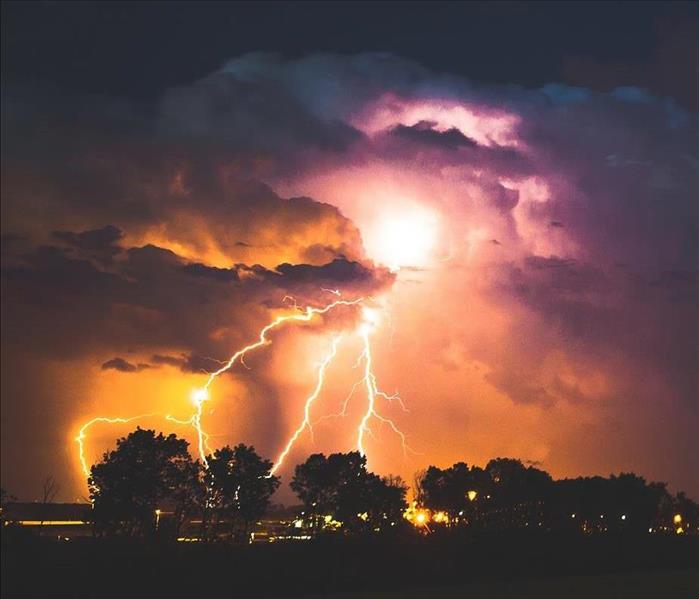 When storms strike, call us.
When storms strike, call us.
In Western New York, we’re no strangers to severe weather. We see crazy thunderstorms in the summer and even crazier blizzards every winter and we take a special pride in our ability to weather any weather that Mother Nature throws at us.
But even if we know that storms are coming, it’s hard to be prepared for serious storm damage. Whether you’re a homeowner or a business owner, we want you to know that when floods, blizzards, hail and storms hit Western New York, we at SERVPRO of West Seneca/Lancaster are here to help, providing the cleaning, restoration and reconstruction you need to minimize damage and get back to normal.
What does SERVPRO of West Seneca/Lancaster do in a storm?
Here’s a quick rundown of how we can help you:
- Emergency service 24/7/365;
- Thorough inspection and damage assessment;
- Removal and extraction of water;
- Drying and dehumidification;
- General cleaning;
- Repair, restoration and reconstruction;
- Carpet and upholstery cleaning;
- Odor removal;
- Disinfection;
- And more!
In short, when it comes to storm damage, we can do it all! Just call 716-674-1103 when you need us.
In the meantime, here’s what you can do until help arrives:
- Mop and blot excess water – the more you can remove, the better;
- Wipe up any excess water on wood furniture as well;
- Remove and prop up wet upholstery and cushions;
- Place foil or wood blocks between furniture legs and wet carpeting;
- Turn on AC in the summer to help with drying;
- Take art, documents and other difficult to replace objects somewhere safe;
- In general, be safe and get everything as dry as you can!
We’re here to help with storm damage 24/7 – call us at 716-674-1103.
Restoring Water Damaged Documents
7/3/2020 (Permalink)
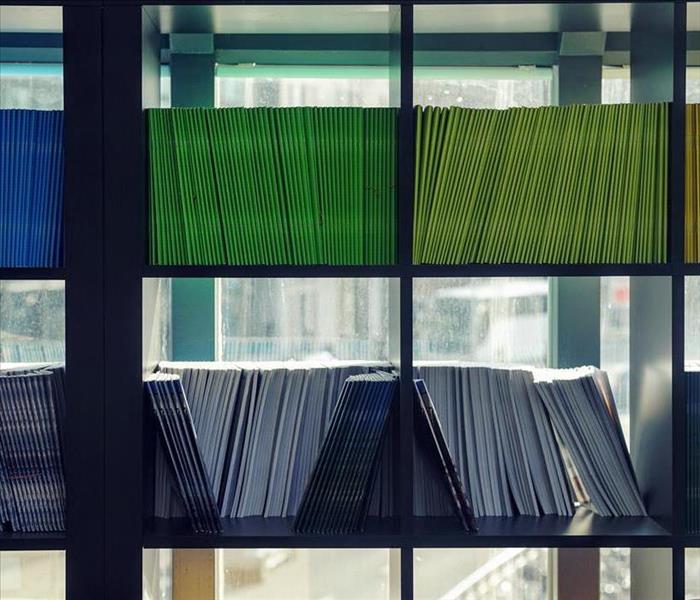 A business's documents are irreplaceable.
A business's documents are irreplaceable.
Sometimes, the most valuable thing lost when there’s water damage isn’t the most expensive but the least replaceable. Important personal documents can easily be damaged when a basement floods or a pipe bursts, and these documents can often be difficult if not impossible to replace. That’s why we’re dedicated to providing the highest quality of document restoration available anywhere in Western New York.
As you can imagine, document restoration after water damage is not easy. Whether we’re helping out a homeowner who needs their personal documents restored or an office with cabinets full of important records, there’s a lot to consider. How serious is the damage? Was the water contaminated?
On top of that, there’s the organizational and record-keeping aspect of the process. We pride ourselves on our methodical approach to restoration, ensuring that any information captured during the restoration is documented as thoroughly as possible so that our customers can access any info that they need while we’re completing the restoration process.
We also keep in close communication with all parties, including insurance companies, to ensure that anyone who needs to be part of the process is never in the dark. We’re also well-versed in the need for privacy and sensitivity, especially when dealing with regulated information (like the medical information protected by HIPAA).
If you’ve suffered a water loss and you need document restoration, we’re here to help. Call SERVPRO of West Seneca/Lancaster today at 716-674-1103 to discuss your options.
What to Do When Your Ceiling is Leaking
7/3/2020 (Permalink)
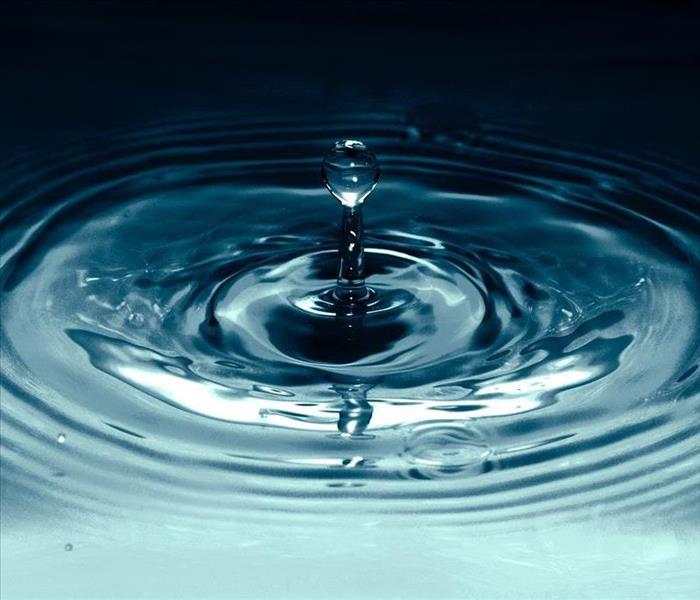 A leaking ceiling is more than a nuisance - it can easily become a disaster.
A leaking ceiling is more than a nuisance - it can easily become a disaster.
Have you just discovered a leak in your ceiling? What a pain, right? In cartoons, people can put a bucket under a leaking ceiling, wait a few hours and the problem takes care of itself. If only real life were so easy…
The signs of a leaking ceiling are obvious: dripping water, discoloration in tiles and plaster, and paint that’s peeling away are hard to miss. However, it can be very tough to actually figure out where the water is coming from. Water does not always drip straight down, hit your ceiling, and come out the other end. It can travel along pipes and other material in your ceiling before finally hitting the surface, meaning that tracking the source down can be a nightmare.
No matter the cause, a leaky ceiling is more than an annoyance – it can lead to mold, structural damage and other serious consequences if not handled correctly.
If you’ve got a serious problem, you should call a professional ASAP. In the meantime, here are some steps to take.
Find the Source
If you can, track down the source of the water and fix it. A leaking ceiling can be caused by a variety of sources, some more obvious than others. A burst pipe or a backed up drain can be pretty easy to find. A leak in a roof might not be. But if you’re able to figure out where the water is coming from and stop it, you’re able to prevent any further damage from occurring.
Dry the Ceiling
To the greatest extent that you can, you want to dry out the spot that’s leaking. Fans and dehumidifiers are your friends here. You may have a few residential units to use, but if the damage is really bad, you might want to think about renting some larger commercial units instead, as well as scaffolding to get them closer to the ceiling.
Paint and Repair
Assuming you were able to fix the source and dry the ceiling out, you may be ready to make repairs. Scrub away any loose debris, wipe the area down and ensure it has dried completely. If your ceiling is painted, primer can be used to block out water spots before blending in a few coats of paint to cover the damage. If your ceiling is plaster, fill in the gaps with new plaster and you should be good to go.
We should mention: all of these steps assume a source that’s easy to find and fix and damage that’s minor. If you have a more serious problem, you’re better off calling the pros instead of fixing it yourself. At SERVPRO of West Seneca/Lancaster, we’re always here to help – give us a call at 716-674-1103 when you need us.
Every Business Owner Should Have a Restoration Company on Speed Dial
6/12/2020 (Permalink)
 Call when you need us - we're here to help!
Call when you need us - we're here to help!
Remember speed dial? You could save a number on your landline and, with the press of a button, you could dial it. No looking up phone numbers or wasting time – when you needed to get in contact with somebody, they were there.
The interesting thing about speed dial wasn’t just the convenience. It was the exclusivity. Most phones had a limited amount of numbers that you could program for speed dial, which forced you to make decisions about whose number was important to save. Mom? Sure. Your best friend? Why not? The random neighbor down the street who “borrowed” your weedwacker? Not so fast. When you made a choice to save someone’s number, you were doing more than making your life easier. You were making a statement that they were important to you.
Cell phones have made speed dial more or less defunct. Now, you can just save any number in your phone and have it when you need it.
So, take out your cell phone right now, dial 716-674-1103, and save it as “SERVPRO of West Seneca/Lancaster.”
Why? Since this isn’t speed dial, we don’t have to feel guilty about taking your mom’s spot in your phone. But more than that, when you need our help, you need it fast – do you really want to waste time trying to Google “SERVPRO” and figure out how to reach us?
Why do you need to call SERVPRO of West Seneca/Lancaster fast?
In an emergency situation, every second counts. The fast that we can get out to you to start the mitigation process, the less damage you’ll deal with in the long run, and the less expensive the whole ordeal will be for you and your business.
For example, imagine your office floods. How fast does water damage happen?
- Within minutes, water’s absorbed in your walls, floors, upholstery, furniture and anything else in the area;
- Within 1 – 2 hours, your drywall swells and even metal surfaces and furniture will start to warp;
- Within the first two days, doors will start to warp and metal will start to rust;
- Within the first week, you may have permanent and serious structural damage, as well as the development of mold and other biohazards.
Now imagine we’re in the middle of a historic thunderstorm and every basement in Western New York is flooding. Our phones are ringing off the hook. The faster you call us, the faster we can get there and the more likely we’ll be able to start the mitigation process before any lasting damage occurs.
Or, imagine we’re in the middle of a blizzard. You get a call from your building engineer that a pipe burst and your business flooded, but you can’t drive there in the middle of a whiteout to check it out. What’s worse, you can’t go to the office and dig out the SERVPRO of West Seneca/Lancaster business card to figure out who to call. Again, you’re left scrambling, Googling “restoration company” and hoping for the best.
Our point is this: saving our number in your cell phone now can you save you minutes. Those minutes could save you hours, if not days, of response time. And that response time could save your business thousands after an emergency.
So: our number is 716-674-1103, we are SERVPRO of West Seneca/Lancaster, and we’re here to help!
How to Communicate Your COVID-19 Safety Processes to Customers
6/12/2020 (Permalink)
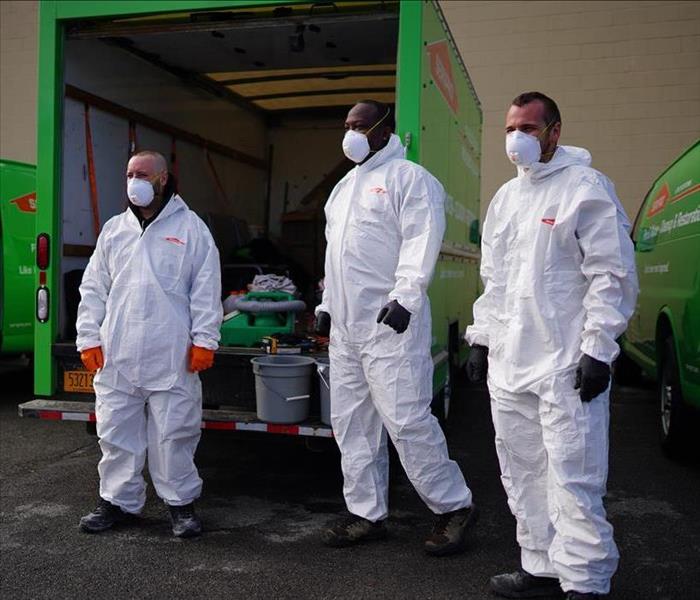 There's clean. And then there's Certified: SERVPRO Cleaned.
There's clean. And then there's Certified: SERVPRO Cleaned.
As we move closer to the end of the coronavirus pandemic, more businesses are starting to open up to the public in Western New York.
This is exciting! If you’ve been closed for months, you’re probably chomping at the bit to get back to normal.
Here’s the rub, though: coronavirus isn’t over. We’ve flattened the curve and avoided overwhelming the hospital system, but it is still very possible to get sick.
Because of that, people are going to be very aware of the steps that businesses are taking to keep themselves safe and disinfected. While businesses obviously want to avoid alarming and inconveniencing people, they also need to make it unequivocally clear that they’re taking the necessary precautions to keep their patrons safe.
So how do you not only keep people safe, but effectively communicate that you’ve kept them safe without being annoying about it? We’ll tell you, with the 4 S’s of Showing You’re Safe. It’s not a comprehensive list of things you can do – rather, it’s 4 things you can easily do today to start showing customers that you mean business when it comes to COVID-19.
Sanitizing
First and foremost – you’ve got to sanitize your space! But you probably know that already, and most businesses have some kind of established daily sanitizing protocol that they’ve worked out with their employees to provide a heightened level of disinfecting.
But here’s the thing: you also have to show your customers that you’re doing the work. People are on the lookout for evidence that you’re taking care of your business. Which brings us to #2.
Signage
Hanging up signs is a great way to educate your customers about the steps you’re taking to keep them safe. The signs themselves don’t have to be super fancy or in-depth – for many customers, the mere presence of that kind of information will be enough to reassure them that you’re taking COVID-19 seriously. Here are a couple of examples signs you might want:
- A “masks required for entry” sign on the door;
- A “processes” sign near the entryway listing out all the steps you’re taking to sanitize;
- An “employees” sign that instructs your employees on the steps they should take to disinfect;
- A social distancing sign reminding people to remain six feet apart;
- A sign on any hand sanitizer station encouraging people to sanitize their hands.
A good rule of thumb: if you want your customers to know something, put it on a sign. Seems obvious, but many business owners expect customers to just notice the steps they’re taking without being prompted.
Social
At this point, customers are well-trained to check a business’s social profiles for up-to-date information about hours, events and everything in between. If you want customers to know about the steps that you’re taking to protect them from COVID-19, you better be posting that information on social.
That said, you should try to do something more exciting than just a text post listing out policies. You might also want to avoid anything too serious, technical or dour. People are burnt out on that kind of stuff. Post a video of one of your employees sanitizing a surface and having a blast; show off the new custom face masks you made; even if all you do is put your rules and regulations onto a nice image, you’ll be much more likely to catch your customers’ attention and show a little personality in the process.
SERVPRO
If you really want to go above and beyond to give your customers peace of mind, we’re here for you. Our Certified: SERVPRO Cleaned program does more than just provide the highest standard of disinfection on a regular basis. It also provides you with a plethora of resources to communicate your dedication to sanitizing and safety to your customers. From window decals to table toppers to digital collateral, we’ll give you everything you need to show you care.
Want more information? Give us a call at 716-674-1103 today!
How Long Will It Take to Reopen My Business After a Water Loss?
6/10/2020 (Permalink)
 We're dedicated to helping you reopen after a water loss.
We're dedicated to helping you reopen after a water loss.
When business owners call us to get more information about water damage mitigation and restoration, they’re often in a real bind. Unlike a homeowner, a business owner isn’t dealing with damage to their residence, but they are dealing with damage that could affect their income. This is especially true if the damage is so severe or so central to their business that they’ll have to close until it’s cleared up.
So it’s no surprise that business owners commonly ask us just how long the restoration process will take. While the length of the process really depends on the extent and type of damage, we can at least walk you through some common scenarios and considerations to give you an idea of what to expect.
What factors affect the length of restoration?
While every water loss is different, here are some of the common questions we consider when estimating how severe water damage might be:
- How much water are we dealing with? A few puddles on the ground? A few feet of standing water? Water coming in from a hole in the roof?
- How long has the water been there? How long has it been in contact with the business?
- Is the water clean or unsanitary? What’s the source?
- What types of materials did the water affect? Are there any that require specialty drying?
- How much demolition or reconstruction will be necessary?
Basically, we need to assess not just the extent of the damage, but what was damaged, and which processes we’ll have to follow in order to properly handle it.
How long does it take for permanent water damage to occur?
The short answer: not long. Here’s a quick rundown of your average water damage timeline.
Within the first hour that a leak or flood begins, water will spread as evenly as it possible can throughout the area that it is entering. It will soak everything that it comes into contact with and, if there’s enough water, will also begin to wick up the walls and soak through the floor and the carpet. Any belongings will get soaked, and some more fragile items, like photographs, books, arts and electronics, may be seriously damaged.
Within the first 2 hours, and certainly within a week, you’ll begin to see mold and mildew develop as well if there’s no mitigation plan in place to stop them. This might start as an annoyance, but it could turn into a biohazard without proper care.
Within the first 24 hours, you may also begin to see drywall start to soak, bulge and break. Furniture will also begin to take on water and may start to swell and even crack. Wood flooring may begin to warp as it takes on moisture. Even metal surfaces may begin to tarnish after 24 hours of exposure.
After a week of exposure to water without proper mitigation or restoration, you’re at serious risk of both a mold outbreak and structural problems at your property. The cost of restoration will also go up significantly, as you’ll be looking at remediation and serious reconstruction on top of standard emergency services and restoration.
How can I reopen faster after a water loss?
The best thing you can do when faced with a water loss is spring into action quickly. Call SERVPRO of West Seneca/Lancaster right away to get a crew in there working. Call your insurance agent and see if you can file a claim. If you can do so safely, start to remove contents yourself, and mop or blot up as much water as you can before a crew arrives. When it comes to preventing serious water damage, time is of the essence.
That said, even if you do everything right, restoring water losses takes time. The mitigation and restoration process will likely take at least a few days, especially if water penetrated deep into any hard-to-dry materials. If demolition and reconstruction are necessary, you may be waiting at least a few weeks for the process to be completed.
So if you’re dealing with a water loss, don’t wait – call SERVPRO of West Seneca/Lancaster right away at 716-674-1103 to get the process started! We’ll work with you to not only make it "Like it never even happened,” but also to get your business back up and running ASAP.
Do's and Don'ts After a House Fire
6/10/2020 (Permalink)
 Fires are scary. Don't go it alone.
Fires are scary. Don't go it alone.
Even after the last flame has been put out and the smoke has dissipated, the scene of a house fire can be a dangerous place. While it’s understandable that you’d want to spring into action and do everything you can to get back to normal after a fire in your home, follow these do’s and don’ts to make sure that you’re both safe and effective in your response.
Do’s After a House Fire
Do wait for the fire chief’s permission before you reenter your home. Even if there’s no active fire, it still may not be safe to go back into your house, especially if there’s been any level of structural damage. Firefighters are specially trained to assess that threat – follow their lead
Do check with a professional before turning on any utilities, including water, propane and electricity. They’ll be able to verify whether turning those utilities on is safe or if you need repairs that might not be obvious to the untrained eye.
Do call a professional cleanup and restoration company like SERVPRO of West Seneca/Lancaster to help with getting back to normal. After a serious fire, it takes the tools, training and experience to accurately assess issues and fix them. Even something as seemingly simple as cleaning up smoke and soot is usually better left to the pros.
Do get a copy of the fire report from your local police department. It may be necessary and helpful if and when you decide to file an insurance claim.
Don’ts After a House Fire
Don’t just run back in as soon as you can to search for personal belongings and valuables. You’ve got to resist the urge to rush the process – your safety is more important than any material possession.
Don’t move your car if it was anywhere near the site of the fire. It may be damaged in ways that aren’t obvious upon initial inspection.
Don’t assume that all damage is visible. Even if you don’t see obvious damage to surface areas, there may be hidden damage that poses long-term risks for you and your family.
Finally, don’t go it alone! Between your fire department, your insurance agent and your professional restoration team, you should have plenty of people to call who have dealt with situations just like yours before. Lean on the experts, trust the process and everything should turn out “Like it never even happened.”
Is It Safe to Stay in a Smoke-Damaged House?
6/10/2020 (Permalink)
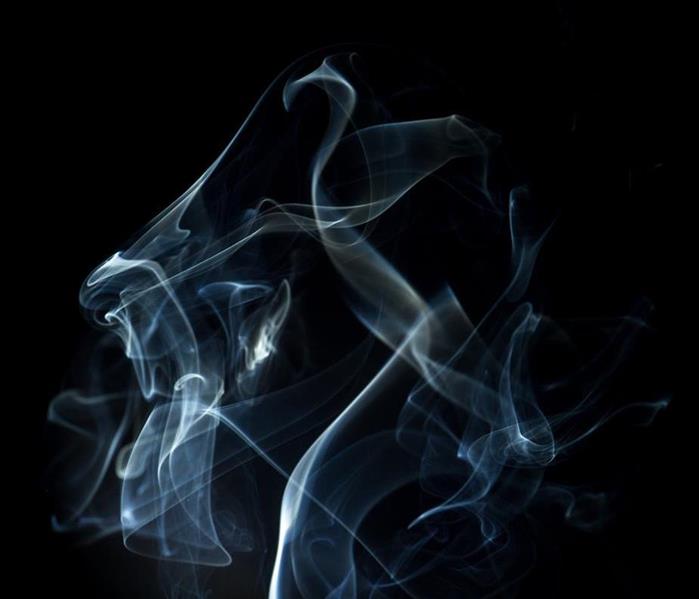 Smoke is a serious health hazard.
Smoke is a serious health hazard.
The fire in your house is over. The initial shock has worn off. The fire department is gone. To the naked eye, the damage doesn’t even seem as bad as you expected.
But is it safe to move back in? The short answer, usually, is no, no matter how minor or major the fire was.
Why is it so risky to get back in your house? We’ll explain.
Smoke Damage: Invisible Invader
When we think about fire damage, we tend to think about, well, the damage caused by the fire. We look at the things the flames burned and use that visual information to make judgments about how dangerous and serious a fire was.
That’s a mistake. Smoke damage might be more difficult to see, but it’s still extremely dangerous.
For one thing, smoke can pervade the house much more quickly and completely than flames often do. A kitchen fire stemming from the downstairs stove can easily waft not just to your upstairs bedroom, but also into your walls, throughout your heating and air conditioning ducts, into your furniture and even into your electrical system.
That smoke might not have even been visible during the fire. No matter how thick the smoke may have gotten, there are still smoke particles that aren’t visible, and its these particles that tend to pose the highest and most unforeseen risk.
Why is smoke so dangerous?
For one thing, smoke is not always easy to detect. If all you do is walk through your house looking for damage visually, you’ll never detect the extent of smoke damage that you can’t see.
For another, it’s important to remember that the smoke from a house fire is not the same as the smoke from a camp fire. Smoke is caused by whatever fuel fed the fire. It’s often greasy, which means that when it coats your home in soot and noxious odors, it can be enormously difficult to remove.
Past that, smoke tends to travel to cooler areas by whatever means necessary. Because of this property, it’s likely that smoke damage will occur in places far removed from the actual fire, and that it will get there through avenues like ducting, pipes, crevices and your electrical system which are not easily accessible or visible.
Long story short – smoke gets where you least expect it and it tends to stick around unless you work with a pro to detect and remove it.
What’s worse, smoke can be enormously hazardous to your health. While the severity depends on exactly what burned, smoke inhalation during a fire is known to cause everything from burns to your respiratory system to serious coughs to vomiting to confusion to death.
After the fire is put out, the byproducts of smoke can still be present inside your home. Toxins like tar and heavy metals can float around in the air, causing serious health issues over time. Even if you don’t get sick, it’s likely that you will find breathing difficult and that your lungs and sinuses may be negatively affected by the aftermath of smoke damage.
On top of that, the smell of smoke after a house fire is enormously unpleasant and has a tendency to attach itself to everything, from your walls to your floors to the clothes that you’re wearing.
So how do you deal with smoke damage and get back into your home? You call a professional fire restoration company like SERVPRO of West Seneca/Lancaster. We’re able to determine the full extent of your smoke damage and make a plan to clean it for good. If you’re dealing with smoke damage after a fire, call 716-674-1103 today!
What to Do After a Pipe Bursts
6/10/2020 (Permalink)
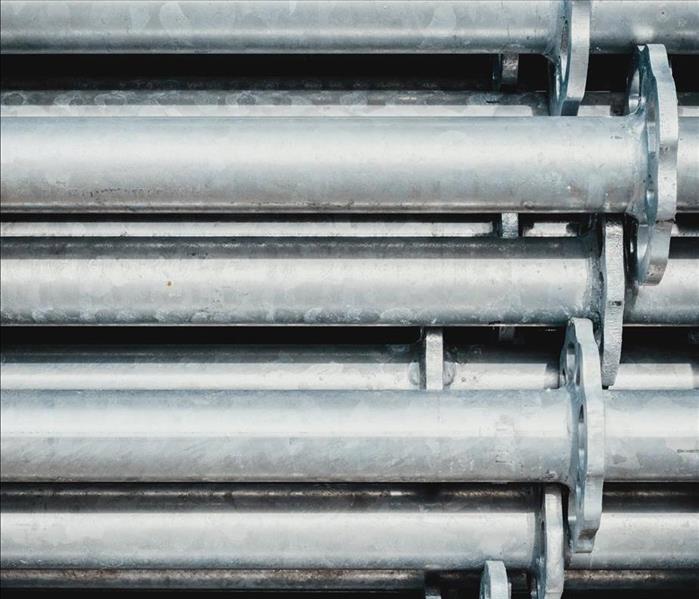 A burst pipe is a serious disaster.
A burst pipe is a serious disaster.
Burst pipes are unfortunately very common out here in Western New York. Blame the winters – the force of water freezing and expanding can very often be more than an old pipe can bear.
If one of your pipes burst, you should stop reading this blog post and call a plumber. Once you’ve done that, try the following to reduce and mitigate any further damage.
Switch off your water supply.
Hopefully you know offhand where your water main is, and you can access it safely. Go find it and shut it off the prevent the flow of more water into your home.
Not sure where your water main is? Usually, it’s somewhere near your water heater in your basement, or tucked away in a crawl space. If it’s external, it may be under a metal lid close to the street.
If safe and necessary, turn off the electricity.
If you can safely access your electrical shutoff, turn that off too to prevent accidentally introducing electricity to the water that’s pooled up.
Drain your faucets.
Just because your water main is off doesn’t mean that all of the water is out of your pipes. To prevent further leaks, you need to drain your faucets, especially the cold water that’s still flowing through your system. Drain your cold taps and flush your toilets a few times. Not only does this reduce the flow of further water, but it also prevents any more water from freezing and bursting your pipes and relieves existing pressure.
After the cold water is clear, you should also turn off your boiler and heating system and drain your hot taps as well.
Warm up your pipes.
Once the water is out of your taps, consider switching the heat back on and turning it up. Warming up the pipes will help to prevent any further freezing and bursting. If you can’t switch on the heat for whatever reason, a hair dryer aimed at the pipe that burst is good in a pinch.
Take pictures.
You’ll want to get as much documentation as possible for your insurance company if you plan to file a claim. Take as many pictures as you can of the area where the leak occurred.
Start cleaning.
The faster that you start to mitigate water damage and remove excess water, the better chance you have of keeping your restoration bill down and avoiding permanent damage. Move whatever contents you can to a safe, dry place that’s out of the way. If there are big pieces of furniture that you can’t move from wet carpet, put wood blocks or foil between the legs and the floor. Mop up or blot as much water as you can.
Call a cleanup and restoration professional.
While there’s lots you can do on your own after a pipe bursts, you can’t do it all. Call the restoration professionals at SERVPRO of West Seneca/Lancaster when you need us – we’re here to help!
Pro's Guide to Toilet Overflow Cleanup
6/10/2020 (Permalink)
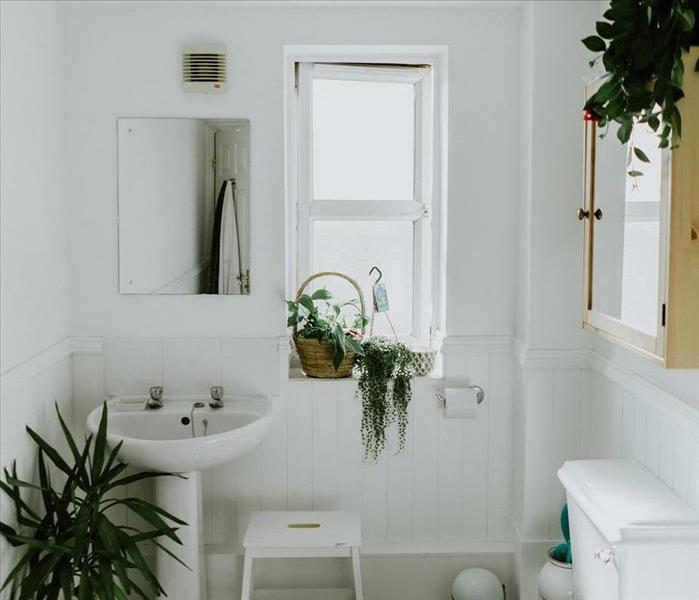 Your bathroom is your sanctuary, until the toilet overflows.
Your bathroom is your sanctuary, until the toilet overflows.
Nobody likes to talk about overflowing toilets, but it happens. Not only is a toilet overflow a huge mess, it’s unsanitary and can lead to not only serious water damage but potential contamination as well.
So how do you go about cleaning something like that up? Do you just grab a mop and hope for the best?
Not exactly. We’ll walk you through the steps you can take in the moments after a toilet overflow occurs.
1. Stop the overflow.
The first order of business is preventing further flow of water and sewage into your home. Open the lid of your toilet tank and look for the circular rubber valve at the bottom of the tank – close that. Then, find the float, which is a rubber sphere attached to a plastic cylinder, lift it up and hold it in place. Next, turn off the toilet’s water valve while holding onto the float. It should be on the back of the toilet. If you’re alone, you may have to let the float go quickly to do this.
At this point, no more water should be flowing into the toilet bowl, and the toilet’s water supply should also be turned off. You’re now in a position where you can focus on cleaning.
2. Start mopping.
Grab a mop and immediately start to pull up as much of the water and waste that you can from the floor. Make sure that you’re wringing the mop out in an empty bucket to prevent any sort of contamination as you work your way through the mess.
3. Plunge the toilet.
Once you’ve cleaned up what you can, grab your plunger and see if you can unclog the toilet. If this doesn’t work after a few minutes, you may have to swap your plunger for a closet auger if you have one. If that doesn’t work, you may have to call in a plumber to deal with the clog.
4. Dump the waste water.
If your toilet is now flushable, dump the waste water down. If not, take it to a different toilet or find another place where you can sanitarily dump it.
5. Disinfect.
Fill the bucket with a sanitizing solution (1 cup of bleach with 1 gallon of warm water works). Sanitize anywhere that might have been contaminated by waste water or sewage using the solution, a mop and a cloth. You’ll probably want to grab rubber gloves for this, and change into clothes you don’t mind getting dirty.
6. Call a restoration company.
If serious water damage has occurred, or the contaminated water has penetrated through to walls, carpets or furnishings, now’s the time to talk to the restoration professionals at SERVPRO of West Seneca/Lancaster. We’ll be happy to come out and take a look at what happened and help you to assess the extent of your issue.
Introducing Our New Marketing Manager, Dan Bauer
6/10/2020 (Permalink)
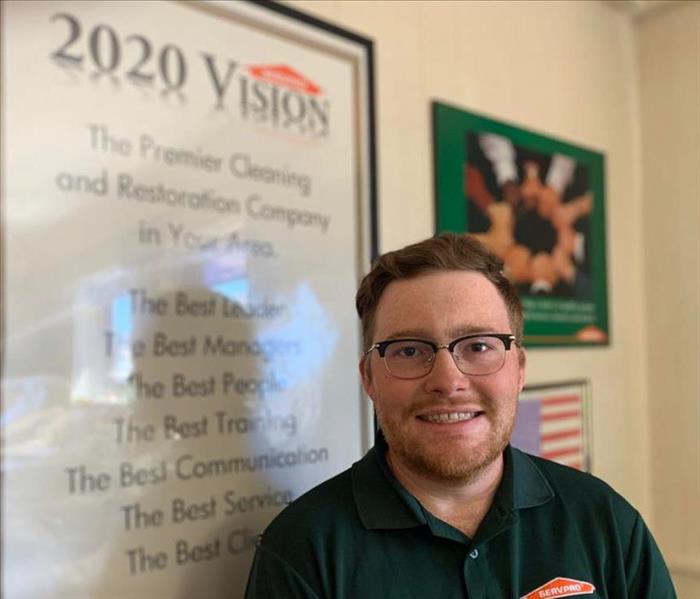 Meet Dan!
Meet Dan!
Hello! I’m Dan Bauer, the new Marketing Manager here at SERVPRO of West Seneca/Lancaster.
I just wanted to post a quick blog post and introduce myself to everyone out here. I couldn’t be more excited to join the team over here, and I’d love to tell you why.
For years, I worked at marketing and branding agencies in Western New York. I worked with clients in all sorts of different industries, all over the world. For the last few years, my focus was on luxury hospitality and retail. We’re talking $5,000 necklaces, $3,000 handbags and $20,000-per-night penthouses.
Working with clients like that was an interesting challenge, and when Lyn and Thom first approached me about jumping ship and joining SERVPRO, I’ll admit I was a bit hesitant. Would I be a good fit for restoration and mitigation? After years of selling things people didn’t really need, would I be up to the challenge of educating people about something they did need?
After seeing the culture that the Brauns have created here, though, I was convinced. Unlike basically every other company I’ve worked with, who were obsessed with selling, SERVPRO of West Seneca/Lancaster is a place that is uniquely dedicated to helping. We’re there for people who are dealing with catastrophes. We can help them when they are having the worst days of their lives. We can make it “Like it never even happened,” combining the resources of an international network with the personal care of a local, family-owned business. What could be better than that.
I plan to be here, serving my community, for the rest of my working years. I look forward to getting settled and helping anyone who comes my way.
Have a great day!
Introducing Cassie, Our Office Administrator
6/10/2020 (Permalink)
 Meet Cassie!
Meet Cassie!
Have you called SERVPRO of West Seneca/Lancaster lately? If so, you might have noticed a new voice on the other end of the phone – Cassie Mueller, our new Office Administrator.
Cassie’s actually been with us since January, but she’s really come into her own learning the company as we all learned to adapt to the coronavirus pandemic, and we couldn’t be more proud of her. She’s definitely a character, equally likely to post an inspirational quote on our bulletin board as she is to hit you with a well-timed side eye, and its qualities like that that make her a joy to work with.
We asked her five questions to get to know her a little bit better.
Q: What food would you get rid of if you could?
A: Grapefruit! I hate it!
Q: What fictional character’s life would you most like to live?
A: Stitch. He lives on the beach. (Editor’s note: you can live on the beach and not be a tiny blue alien.)
Q: What’s your go-to karaoke song?
A: Michael Jackson’s “Thriller.”
Q: Which celebrity do you most resemble?
A: Emily Osment. (Editor’s note: this is apparently someone from Hannah Montana. This answer made is feel old, too.)
Q: Caption this cartoon.
A: How I felt when you asked me these questions.
3 Tips for Getting Back to Business After Quarantine
5/27/2020 (Permalink)
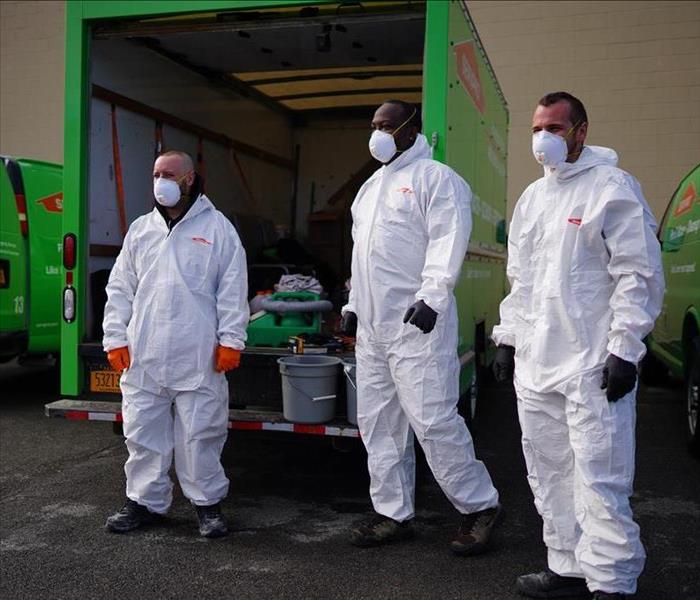 When you're ready to reopen, we're here to help.
When you're ready to reopen, we're here to help.
As the local economy prepares to reopen here in Western New York after a long and arduous quarantine, business owners are in uncharted territories. Most are anxious to get back to normal after months of financial hardship and uncertainty, but how do you weigh potential profits against safety? How can you know the safest way to reopen when nothing like this has ever really happened before?
At SERVPRO of West Seneca/Lancaster, we’re here to help you put together a “back to business” plan that’s informed by decades of experience helping business owners of all sizes reopen their doors after all types of catastrophes.
While every business’s situation is unique, there are three things every owner should do: adapt, educate and prevent.
1. Adapt
While the coronavirus pandemic has shown us just how susceptible our world is to disaster, it has also shown us how quickly and effectively people can learn to adapt. A year ago, no one could have foreseen that we’d be social distancing and wearing masks to the grocery store – now, these things have become a matter of course.
Businesses have also learned to adapt. Businesses that are reopening should learn from those that have remained open during the pandemic and consider adopting some of their preventative measures in order to minimize the spread of the virus as people get back to work. These measures include:
- Ongoing physical distancing between anyone inside a business location;
- Switching in-person meetings to videoconferences, or meeting in open, well-ventilated spaces;
- Drastically limited business travel;
- Confidential methods for employees to self-report sickness or potential exposure, as well as confidential ways to inform other employees of their potential risk;
- Updated and more flexible sick leave policies that encourage employees to take time off if they think they may be sick.
Policies like these may be a departure from “business as usual” for many businesses, but they pay dividends in the long run if they help to minimize the spread of COVID-19, which can pass very quickly through an active workplace.
2. Educate
While adapting your policies is a good start, you cannot prevent the spread of disease from the top-down. Employees must also be educated and empowered to minimize their risk from the bottom-up. Business owners should remind their employees of the following (even if it feels a bit redundant):
- Shaking hands can be dangerous – use other forms of greeting;
- Wash and sanitize your hands frequently;
- Avoid touching your face and eyes;
- Shield others from coughs or sneezes;
- Disinfect high-touch surfaces (like doorknobs, tables, desks, keyboards and light switches) multiple times per day;
- As weather allows, open windows or adjust air conditioning for better ventilation;
- Do not share food or drinks;
- Know your sick leave policies and take advantage of them if you feel like you may be sick or recently exposed to the virus.
Employers should also be aware of what they can and can’t ask of employees. While recently revised EEOC guidelines allow employers to check employee temperatures at work if they display symptoms of respiratory illness, the existence of a fever or other symptoms would be subject to confidentiality requirements set out by the Americans with Disabilities Act.
Past that, if and when a vaccine for COVID-19 is developed, employers may not require employees to be vaccinated.
3. Prevent
Policies and education create a knowledge base for employers and employees, but minimizing the spread of disease is an everyday activity. Here are just a few things you should consider doing:
- Document all policies related to the pandemic and distribute them to your employees;
- Create an outbreak response plan. Detail how will you react if someone is exposed to the virus, or you suspect that they have been exposed;
- Inventory all high-touch surfaces and create a regular schedule for disinfecting them;
- Consider scheduling regular deep cleans with a professional company like SERVPRO for an extra layer of protection and peace of mind;
- Distribute face masks and gloves to employees with specific instructions on when and how to wear them;
- If possible, stagger employee schedules to reduce the risk of cross-contamination;
- Manage the space in your business to prevent close contact between people (for example, create one-way aisles or mark off six feet of distance on the floor);
- Invest in no-touch sanitizer stations.
If you adapt, educate and prevent, you should be well on your way to reopening as safely as possible. If you’d like further help in creating your back to business plan, just give us a call at SERVPRO of West Seneca/Lancaster at 716-674-1103. We’re here to help!
7 Causes of Commercial Water Damage
5/27/2020 (Permalink)
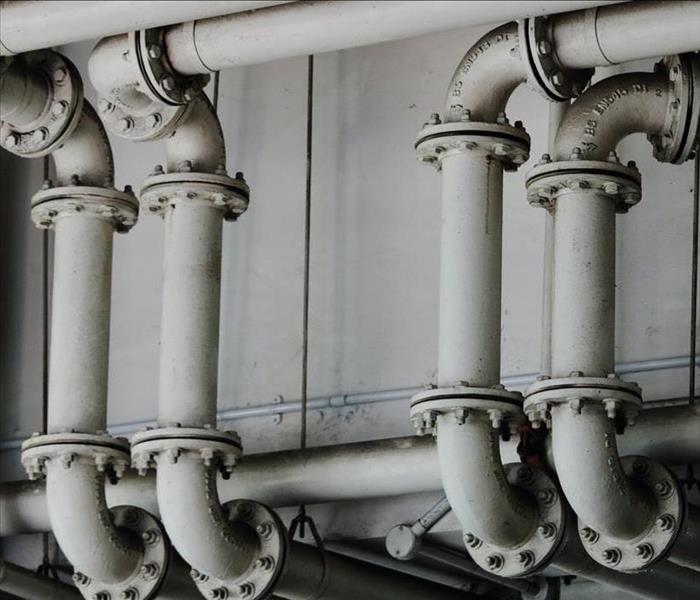 Water damage can strike when you least expect it. Do you know where to check for leaks?
Water damage can strike when you least expect it. Do you know where to check for leaks?
If you run a business, you should know – water damage could one day stand between you and your profits. The damage caused by leaks, floods and other forms of disasters is not just cosmetic. It can cause lasting issues that prevent you from operating your business effectively if not taken care of in the right way.
How bad can a water loss be? According to Zurich North America, insurance claims involving water cost three times more than those that don’t.
How do you minimize the cost of water damage? The simple answer: you prevent it from happening in the first place. And how do you do that? You know where it comes from, and you keep up with your maintenance.
Here are seven major causes of water damage in businesses.
1. Windows
When was the last time you resealed your windows? If you can’t remember, you may have a problem. A window that’s not properly sealed will allow moisture to seep in. Moisture leads to many different problems, including the development of mold and the warping of wood and drywall. A quick visual check should indicate whether windows need to be resealed or not, though a good rule of thumb is to regularly check on any windows that are more than 5 years old.
2. Pipes
A pipe break can be one of the most disastrous things that can happen to a business. Whether a pipe is totally broken or just leaking, it can still lead to major problems. Pipes break for all sorts of reasons – changes in pressure, cold weather, or simply deterioration over time. No matter the cause, the damage can be severe. Keep an eye out for bulging walls, water stains, a musty odor or loose and cracking tiles. If you suspect there may be a leak, call in an expert who can help you to detect it and figure out what to do next.
3. Gutters
If you don’t keep up with cleaning your gutters, they’ll clog. If they clog, then you’re likely to see water leaking through your roof or into your foundation, causing serious damage over time. If you see puddles forming around your building where they shouldn’t be, make sure your gutters are clear.
4. Roof
Your roof should protect your business, but if it isn’t properly maintained, it may become a liability. Leaking roofs don’t just lead to water damage – they can also promote mold, mildew and even fire hazards from shortened wires. If you think your roof is leaking, talk to a roofing professional to assess your options.
5. HVAC System
If you aren’t cleaning your ducts regularly, they may get damaged over time. This damage can lead to a variety of problems, including leaks. A professional cleaner should be able to remove excess water from your ducts as they clean, helping to prevent leaks and protect your ducts from issues.
6. Sewer System
Sewage clogs and backups can be a serious source of issues. Sewer water doesn’t just cause water damage – it’s also rife with bacteria and pathogens that can lead to health issues if you’re exposed. If you witness the early signs of a serious issue (like gurgling when flushing or water backing up from a drain or toilet), it’s time to bring in a professional to diagnose what’s going on before it causes any more problems.
7. Sprinklers
Sprinkler systems are there for your protection, but they too can cause water damage over time. If a sprinkler goes off, it will obviously soak the area, which will then need to be properly cleaned and dried. Sprinklers can also leak, however, which can introduce moisture to your walls, floors and ceilings and lead to lasting damage as well as issues with mold. You or your facilities team should regularly inspect sprinkler lines for signs of leaks or excess moisture.
Water damage can come from a variety of places, and there doesn’t necessarily need to be a preexisting issue with your current systems for leaks or floods to take place. That said, if you monitor these seven areas regularly, you’re likely to save yourself some headaches in the long run.
Leave Commercial Mold Removal to the Pros
5/27/2020 (Permalink)
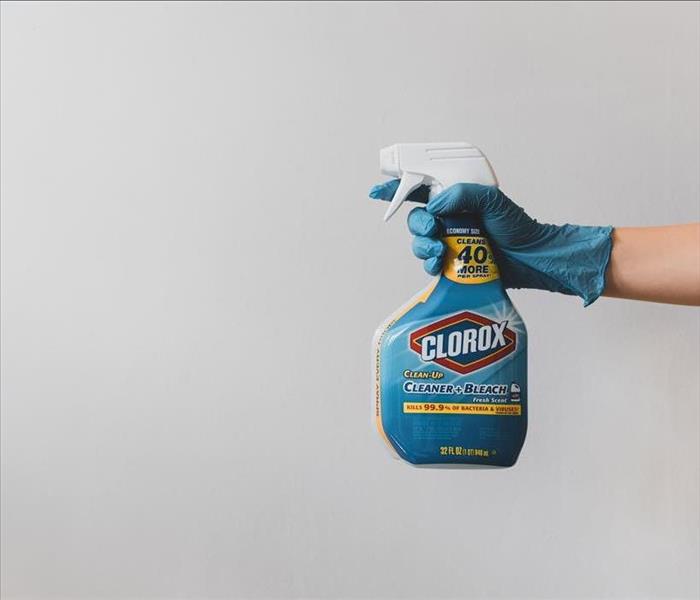 Bleach may deal with mold on a surface level, but it usually can't reach the roots.
Bleach may deal with mold on a surface level, but it usually can't reach the roots.
The “do-it-yourself” mentality embodied by many business owners is an asset that enables them to get ahead in a dog-eat-dog world. That said, taking on every problem on your own is not always the best solution, and that goes double when it comes to something like mold cleanup.
That’s because mold can be so deceptive. A business owner or employee may discover a few small spots of mold in a bathroom or an area that’s seen some water damage and figure that cleaning up should be no big deal. A little bit of bleach, a little bit of elbow grease, and voila! – the mold is gone, right?
Not always. If all you do is remove the surface of mold and you don’t deal with the roots, you’re going to have a recurring problem that you can’t solve on your own. The issue largely comes down to the types of products that a business is likely to have access to on its own.
All Cleaning Supplies Are Not Equal
When home and business owners alike find mold in their homes, they’re likely to reach for the same product: a jug of bleach. Initially, they’ll be happy with their results – chlorine bleach can indeed be used to remove mold from a surface, which is all a layman can easily visually detect.
But bleach alone won’t get the job done for a few reasons. On one hand, chlorine will evaporate before it has been totally effective, and it can be dangerous to use too much. More than that, though, a DIY bleach treatment won’t generally be enough to deal with the roots of mold, just enough to clean the surface.
How Professionals Remove Mold
Removing mold (and fungus, for that matter) requires effective cleaning of both the surface and the roots of mold.
On the surface, pros use a variety of products based on their approach. These include hydrogen peroxide, vinegar, borax and sometimes even tea tree oil.
For the roots, however, you’ll need professional-grade biocides, which are unavailable to most business owners due to their potency. Depending on the severity of the issue, special gear may also be necessary to get the job done.
For these reasons, we suggest that business owners rely on an experienced mold removal company to deal with their problems. While it can be tempting to “do-it-yourself,” you’ll likely only deal with the problem on a surface level, which can lead to major problems down the road.
Proud to Protect Our First Responders
5/26/2020 (Permalink)
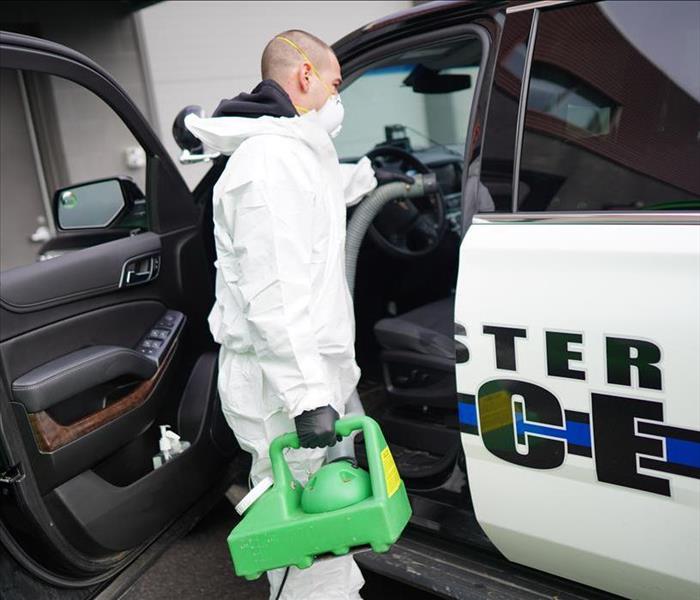 When we say we're "here to help," we mean it.
When we say we're "here to help," we mean it.
What does SERVPRO mean to us? Not just providing the highest standard of cleanup and restoration available. To us, being a part of the SERVPRO family means taking care of our community whenever and wherever we get the chance.
During the height of the coronavirus pandemic in our region, we committed ourselves to doing what we do best to help our first responders stay safe. Pro bono, our technicians traveled to 24 different police, fire and EMS agencies in the area to sanitize their vehicles and their stations. In all, we cleaned more than 536 police cars, fire trucks and ambulances over a six-week period.
The way we see it, our first responders rose admirably to the call of duty in an unprecedented time. These heroes put themselves in harm’s way each day to save lives. Helping them to feel a little bit more protected from COVID-19 was the best way we could think of to say “thank you.”
Production Manager Chris Ferguson put together this incredible video chronicling the work that we did – check it out!
We're Here to Help Our Community's Kids
5/26/2020 (Permalink)
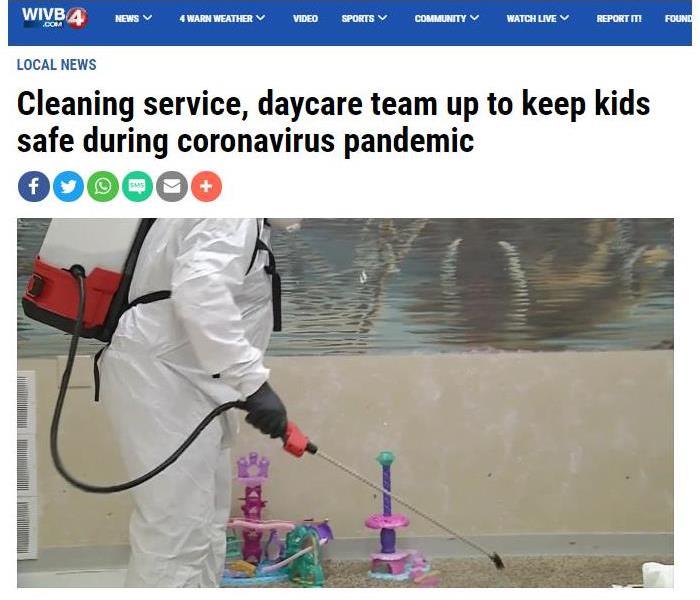 Thank you to Channel 4 for hanging out with us!
Thank you to Channel 4 for hanging out with us!
One of the most rewarding things about SERVPRO is that we provide more than cleanup and restoration. At our best, we provide our community with peace of mind that we’ve taken care of them at the highest standard possible.
That’s why it was so rewarding to work with local daycare Lakeview Children’s World to clean, disinfect and sanitize their business before they open back up to the community at large. Sandy Smith, the daycare’s owner, is truly and deeply committed to the well-being of the children in her care, and we’re proud to be able to be a part of that.
Channel 4 News was also kind enough to send a reporter out to chronicle the process. We were happy to give them a bit of “behind the scenes” access to show their viewers just what it takes to really deep clean and sanitize a business.
Check out their story here, and stay safe!
Why Choose SERVPRO of West Seneca/Lancaster?
9/27/2019 (Permalink)
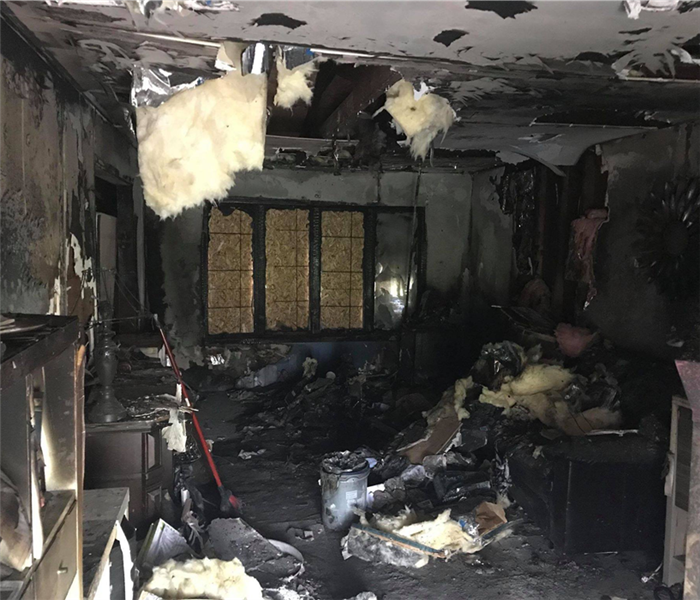 When fire and/or water damage devastates your home, choose the professionals at SERVPRO of West Seneca/Lancaster
When fire and/or water damage devastates your home, choose the professionals at SERVPRO of West Seneca/Lancaster
Why should you choose SERVPRO of West Seneca/Lancaster? Is it because we are available 24/7 every day of the year? Or because we are the number 1 Restoration company in the area? Or because we can handle any size disaster? All of those things are great, but the reason why you should choose SERVPRO of West Seneca/Lancaster is because of the people who work here. Our staff is dedicated to getting you and your home back to normal after a disaster. Our staff cares about you, and your experience working with us. Our office staff will guide you through the entire process, and answer any questions you may have. You will know who is walking in and out of your home every day, and can expect updates through the entire job. Our expert technicians can answer questions you may have while onsite, and treat you and your home like it is their own. We understand that this is a stressful time for you, and we strive to make it the best experience possible.
So, when it comes time to trust a company to handle your fire and/or water damage, choose the company that cares. Choose SERVPRO of West Seneca/Lancaster. Please call our office at (716) 674-1103 to make your fire and/or water damage, “Like it never even happened."
The Number 1 Restoration Company in WNY
9/27/2019 (Permalink)
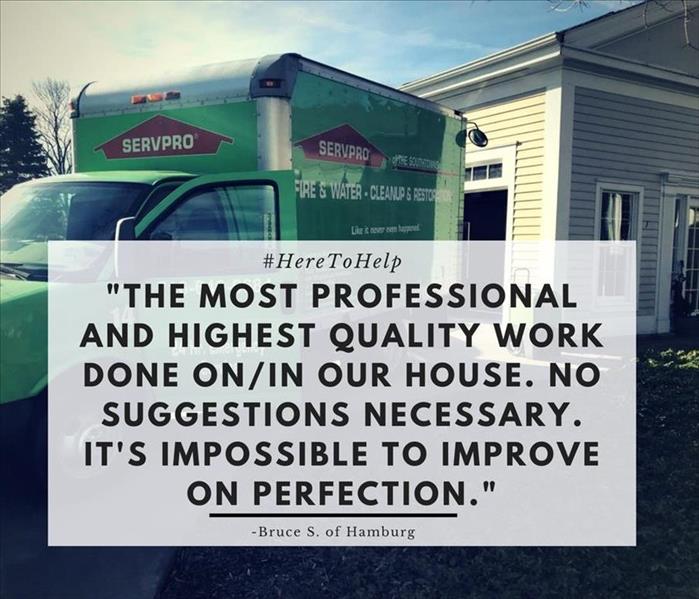 Only the professionals at SERVPRO of West Seneca/Lancaster can make fire & water damage, "Like it never even happened".
Only the professionals at SERVPRO of West Seneca/Lancaster can make fire & water damage, "Like it never even happened".
Fire and/or water damage can be devastating to deal with. Not only is your life put on hold, but the stress that comes with it can be overwhelming. So, when fire and/or water damage happens to you, trust the experts at SERVPRO of West Seneca/Lancaster to make it, “Like it never even happened”.
Our professional technicians have the proper training and equipment to handle any size disaster that may arise, and know how to mitigate the damage quickly in order to prevent further damage from occurring.
Our technicians are available 24/7, because fire and/or water damage rarely happens within normal business hours. And, we guarantee that someone will be onsite within 2 hours of you notifying our office of a loss to begin assessing the damage. If you experience fire and/or water damage give the experts at SERVPRO of West Seneca/Lancaster a call at (716) 674-1103 immediately.
Gym Floors Are No Match For SERVPRO of West Seneca/Lancaster!
8/20/2019 (Permalink)
 The thought of losing the brand, new wood gym floor can be overwhelming. Don't stress and call the experts at SERVPRO West Seneca/Lancaster.
The thought of losing the brand, new wood gym floor can be overwhelming. Don't stress and call the experts at SERVPRO West Seneca/Lancaster.
We’ve seen it before, a school finishes putting in a brand new gym floor, and then disaster strikes! Flooding occurs and then, BAM the new gym floor seems ruined. However, SERVPRO of West Seneca/Lancaster is here to tell you that is not the case! We have the technology and knowledge to save that water damaged gym floor, and restore it to preloss condition. That’s right, we can restore water or fire damaged wood flooring in your Buffalo, NY commercial property, school or business.
Our skilled technicians use a paneling system that creates a vacuum suction, pulling the moisture out of the hardwood. The sooner this paneling system is put into the place, the better chance there is for restoring your hardwood flooring. They then tent the paneling with plastic and utilize air movers and commercial dehumidifiers to pull out the remaining moisture. So, the next time you find your commercial wood floor under water, give the experts at SERVPRO of West Seneca/Lancaster a call at (716) 674-1103.
Faster To Any Size Disaster!
7/24/2019 (Permalink)
 Here is our Training Supervisor Taylor Braun educating our crew on the latest advances in the restoration industry.
Here is our Training Supervisor Taylor Braun educating our crew on the latest advances in the restoration industry.
When storm time hits here at SERVPRO of West Seneca/Lancaster, we know time is of the essence. It is important for everyone on our crew to be on the same page, and be able to go into action immediately. That is why proper training is a key factor during storm time. Our Training Supervisor Taylor Braun works with our crew every Monday at our weekly meeting, to ensure that they know and understand all the latest restoration techniques.
That way, when storm time hits, they are able to make your water damage, “Like it never even happened.” faster. Our crew understands that in order to accomplish this, they must work efficiently and quickly. Also, because we are a part of the SERVPRO Franchise should we need it, we have access to equipment from over 1,700 other franchises across the United States and Canada.
That really makes us faster to any size disaster. So, if you experience water damage from a severe storm, please call our office at (716) 674-1103 today!
The Right Certifications Matter
7/24/2019 (Permalink)
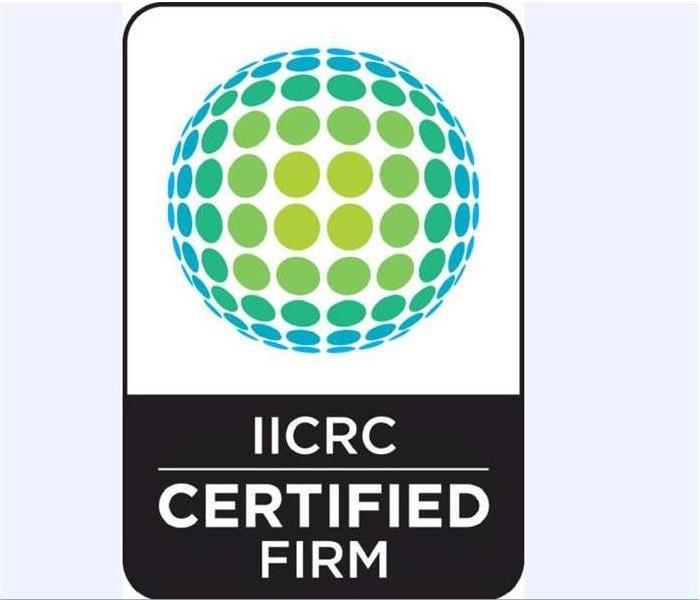 Each one of our professional technicians must obtain, and maintain a IICRC Certification.
Each one of our professional technicians must obtain, and maintain a IICRC Certification.
In order to make sure that we are faster to any size disaster during storm time, all of our technicians must be IICRC certified. The Institute of Inspection, Cleaning and Restoration Certification creates the standards for the restoration industry, as well as provides training and certification to restoration companies. So what does it mean when we say SERVPRO of West Seneca/Lancaster is an IICRC Certified Firm? Well, it means that we must:
- Present accurate information to consumers and conduct business with honesty and integrity.
- Require a technician on all jobs who has been formally trained and passed all required tests.
- Require a continuing education program to keep technicians up to date on the latest changes in the restoration industry.
- Maintain liability insurance to protect all parties in the event of an accident.
- Maintain a written complaint policy and agree to the Better Business Bureau or similar arbitration to resolve disputes, and accept the conclusions and recommendations of arbitration.
The IICRC has set the standards in the restoration industry for years. We are proud to follow the protocols and procedures they have created. Every five years the IICRC reviews and revises their standards, making sure that only the most effective procedures are being used.
Therefore, trust the team at SERVPRO of West Seneca/Lancaster to help you with any water damage caused from a storm.
Emergency Planning: Flooding Edition
7/19/2019 (Permalink)
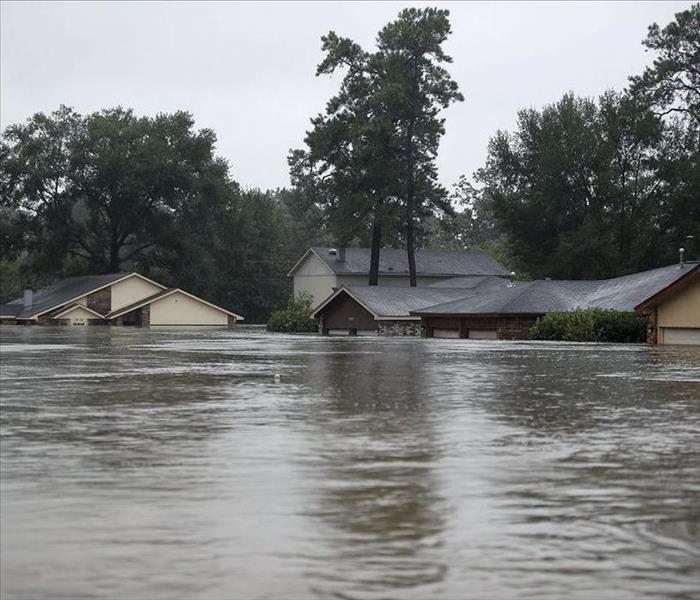 It is important to stay safe during a flood. Follow these action steps to keep you and you're family safe.
It is important to stay safe during a flood. Follow these action steps to keep you and you're family safe.
We’ve talked about why you should never clean up after a flood, but what about what should you do during a flood? Believe it or not, floods are the most common natural disaster in the United States and WNY is not immune to this type of disaster. We have seen flooding all over WNY. From Silver Creek and Gowanda, to West Seneca and South Buffalo, flooding does not discriminate where it will strike.
More recently, we have seen flash flooding in Ellicottville and Little Valley. So, it is important to understand the proper safety precautions you should take during a flood.
According to Ready.gov you:
- Depending on where you are, and the impact and warning time of flooding, go to the safe location that you have previously determined.
- If told to evacuate, do so immediately. Remember to NEVER drive around barriers, they are there to safely direct traffic out of flooded areas.
- Listen to EAS, NOAA Weather Radio, or local alerting systems for current emergency information and instructions.
- Stay off bridges over fast moving water.
- If your vehicle is trapped in rapidly moving water, then stay inside. If water is rising inside the vehicle, then seek refuge on the roof.
- If trapped in a building, then go to its highest level. Do not climb into a closed attic. You may become trapped by rising floodwater. Only go to the roof if necessary. Once you are there, signal for help.
Remember to listen to authorities to determine when it is safe to go home. Never touch electrical equipment when wet, and do not wade in flood waters as there could be snakes, other animals, and dangerous debris floating around. Be sure to check out Ready.gov for more important safety tips and procedures on flooding.
https://www.ready.gov/floods
All Hands On Deck During Storm Season
7/19/2019 (Permalink)
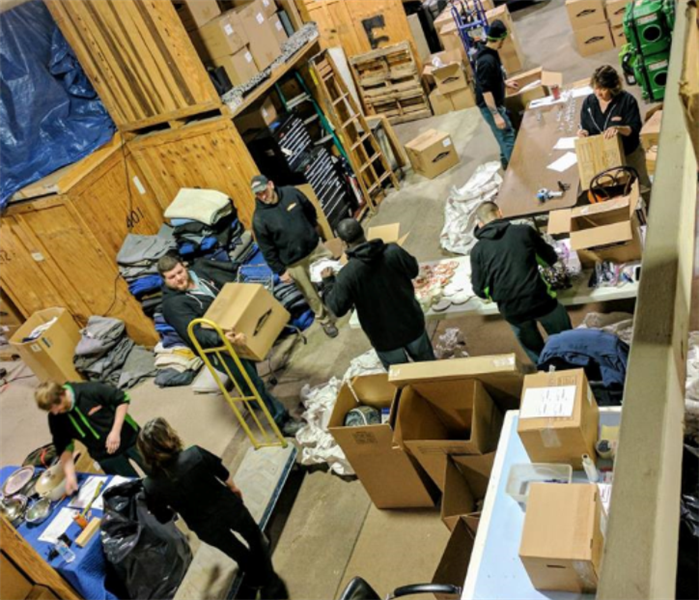 When we say, "all hands on deck" we mean EVERYONE helps out.
When we say, "all hands on deck" we mean EVERYONE helps out.
When a wide spread, severe storm hits our WNY area it is no surprise that we see an influx in calls. Heavy rains can cause sump-pumps to back up or overflow, foundations to leak or several other events that cause significant water damage to your home. So, when storm time hits the Lancaster and West Seneca area it’s all hands on deck here at SERVPRO of West Seneca/Lancaster.
What do we mean when we say, “all hands on deck”? We mean that EVERY ONE in the company is pulled to help. That’s right, from Lyn and Thom Braun (the owner’s), to our Marketing Department of Jocelin and Emily, everyone helps field calls, assist with pack-outs and etc. That is because we know how much time matters when dealing with water damage.
Therefore, SERVPRO of West Seneca/Lancaster puts all hands on deck to be faster to any size disaster and make it, “Like it never even happened”.
If you experience damage from a storm this summer, please don’t hesitate and call our office at (716) 674-1103.
Why You Should NEVER Clean Up After A Flood. Leave It To The Professionals
7/17/2019 (Permalink)
 Flood waters may be grossly contaminated. That is why you should leave the clean up to SERVPRO of West Seneca/Lancaster.
Flood waters may be grossly contaminated. That is why you should leave the clean up to SERVPRO of West Seneca/Lancaster.
All the rain our area has been experiencing lately puts us at risk for potential flooding. Here at SERVPRO of West Seneca/Lancaster we understand just how devastating a flood can be in your WNY home or business. We also know how dangerous cleaning up yourself after a flood can be.
Flood waters can be seriously contaminated with bio hazardous contaminates that can put you and your family’s health at risk! It is so important that you never try to cleanup yourself after a flood. Let a professional and experienced company like SERVPRO of West Seneca/Lancaster do the mitigation and restoration work for you. Our skilled technicians have the knowledge and the equipment to properly, and safely clean, sanitize and dry your home after a WNY flood.
In addition to safely handling these grossly contaminated waters, our professional technicians also know how to look for hidden water damage that may not be visible to the naked eye. Our crews utilize special equipment like infrared cameras, water meters (both invasive and non-invasive) and industrial size air movers to make sure your home or business is properly dried. SERVPRO of West Seneca/Lancaster understands that if the water damage is not properly taken care of immediately, it puts your home and belongs at risk for further damage.
So if you should experience a flood this summer call the experts at SERVPRO of West Seneca/Lancaster at (716) 674-1103 to make it, “Like it never even happened."
Restoring Vs. Replacing Your Fire Damaged Items
7/15/2019 (Permalink)
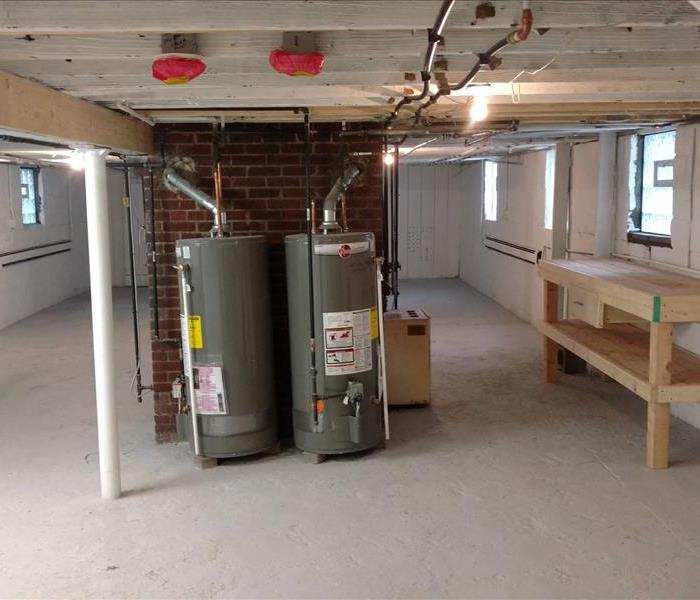 Let SERVPRO of West Seneca/Lancaster restore your belongings, instead of replacing them.
Let SERVPRO of West Seneca/Lancaster restore your belongings, instead of replacing them.
A common misconception that we see in our industry is that after a fire loss, it is less expensive to replace contents instead of restoring them. As a leader in the Fire Restoration Industry, SERVPRO of West Seneca/Lancaster is here to tell you that this statement is FALSE. Our skilled technicians are trained to see beyond this common misconception, and restore your valuables/contents to preloss condition.
The mitigation process after a fire loss yields excellent results at a cost effective price. The mitigation stops additional damage from occurring and reduces the loss, while the restoration process puts the items back to their preloss condition. For the best results, the mitigation process should begin as soon as possible (within 24 hours preferably). In order to guarantee the removal of smoke odor, all of the contaminated areas need to be cleaned, deodorized and possible sealed (where applicable). As well as all odor particles, whether airborne or absorbed, need to be neutralized. It’s important to note that some items, such as family air looms and photos, cannot be replaced. Thus, one more reason why restoring can be better than replacing after a fire loss.
So if your home experiences a fire, don’t believe the misconception that everything needs to be replaced. Let the experts at SERVPRO of West Seneca/Lancaster help restore your valuables and make it, “Like it never even happened."
Do You Have Fire Damaged Documents? We Can Restore That
7/15/2019 (Permalink)
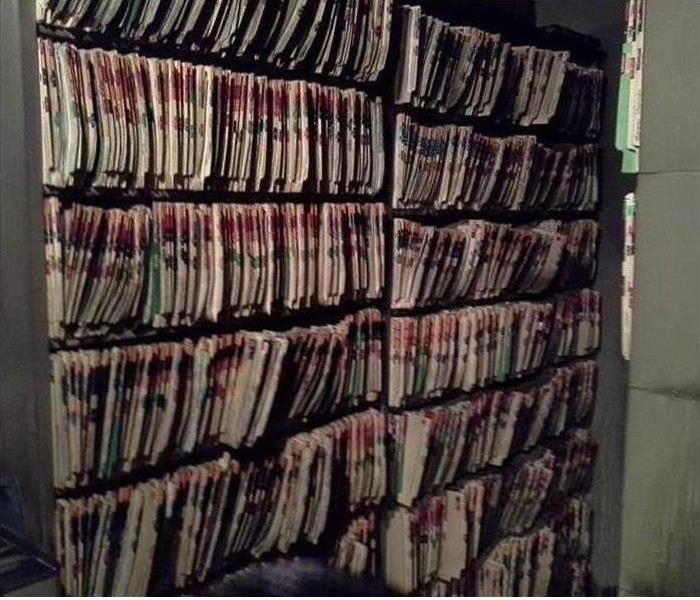 Don't stress over fire damaged documents, we can restore those.
Don't stress over fire damaged documents, we can restore those.
Picking up the pieces after a fire/water loss can be overwhelming and stressful. Realizing that your documents have been damaged from the loss is even worse! But good news, SERVPRO of West Seneca/Lancaster is always, “Here to help” and we can restore your fire/water damaged documents. We understand that there are several documents, whether they are for residential or commercial use, are important to you and cannot be replaced. These documents may even contain sensitive information that should not, or cannot be shared. Our Technicians are HIPAA compliant and are trained how to deal with sensitive information so they can handle these sensitive situations.
SERVPRO of West Seneca/Lancaster has a special process to handle fire and/or water damaged documents. We can pull the moisture and odor out using freeze-drying technology. However, it is important to start this process as soon as possible (if not immediately). So, if you have documents that are affected by fire and/or water we recommend that you put them in the freezer immediately, and call our office at (716) 674-1103. This service has helped several doctor’s offices and schools that are required to keep a paper copy of documents. So if you have documents that suffered water and/or fire damage let the experts at SERVPRO of West Seneca/Lancaster make it, “Like it never even happened."
Right Product, Right Equipment: Fire Damage Edition
7/13/2019 (Permalink)
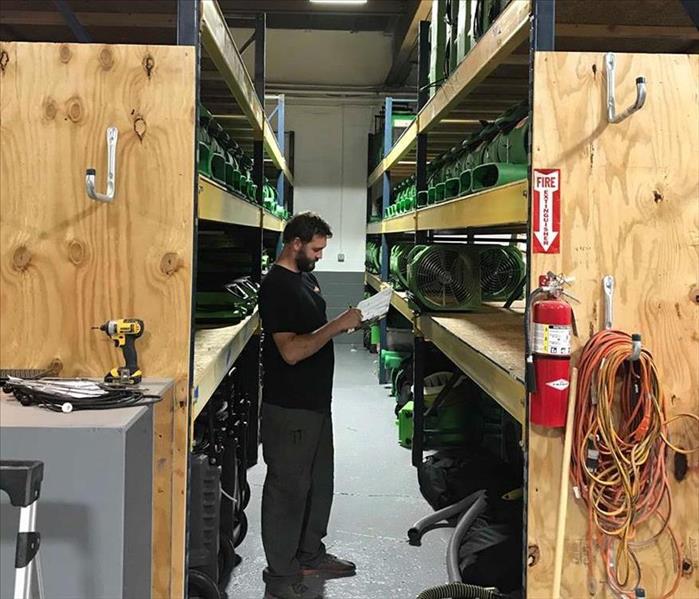 Having the right equipment and product to get the job done right is KEY when it comes to fire damage restoration.
Having the right equipment and product to get the job done right is KEY when it comes to fire damage restoration.
After suffering a fire, call the restoration company with the right equipment, team and products. These three things make all the difference when putting the pieces after a fire back together. SERVPRO of West Seneca/Lancaster has all three.
Our technicians are IICRC certified and are continually trained on the latest technologies in fire restoration. Each one of our professional crew members are trained to deal with the emotions and concerns our customers may have after a fire. They understand that this may be the most difficult time of your life, and know how to effectively assist you during this time. They will put together a comprehensive fire mitigation plan, but explain it in terms you understand so you always know what is going on. A crew is always on call 24/7 to help you after a fire.
The right equipment is a huge factor in fire restoration, and SERVPRO of West Seneca/Lancaster has it. We have the proper air scrubbers, dehumidifiers, soot cleaning equipment AND, all the necessary equipment to mitigate the water damage from the fire company. We have access to additional equipment from over 1,500 SERVPRO’s nationwide, should we need it. And, we are continually updating our equipment to make sure it is up to our standards.
And lastly, SERVPRO of West Seneca/Lancaster has the proper products needed for fire restoration. We have an on-site chemist located at SERVPRO headquarters who has custom created over 150 products that are specially designed to get the job done right. Each product comes with a MDS sheet so you know exactly what is being used in your home.
So if you experience a fire, trust the experts at SERVPRO of West Seneca/Lancaster to get the job done right! Someone is always available at (716) 674-1103.
Good News! We Can Now Clean Even MORE After A Fire!
7/13/2019 (Permalink)
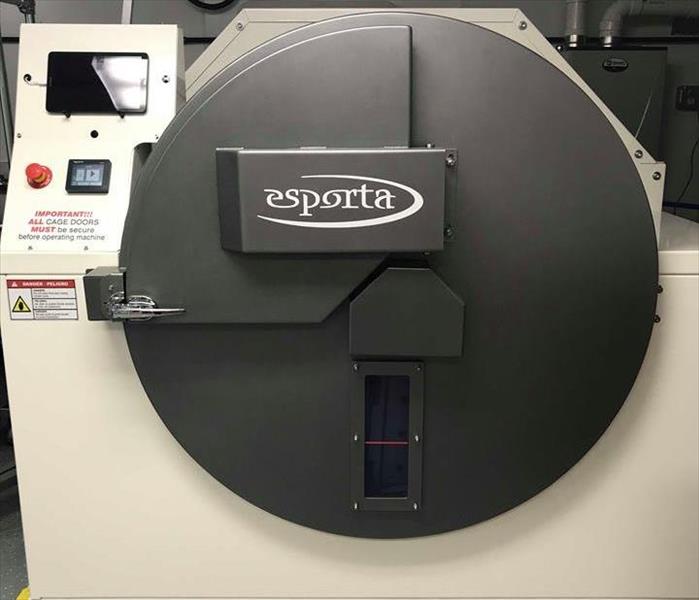 We can now clean up to 90% of soft goods after a fire loss.
We can now clean up to 90% of soft goods after a fire loss.
Here at SERVPRO of West Seneca/Lancaster, we know that after a fire can be one of the most devastating times of your life. Your whole world has been turned upside down, and items you cherished may seem gone forever. But, we have some exciting news to share with you. You already know SERVPRO of West Seneca/Lancaster can help you with the fire mitigation of your home, but now we can also help restore your soft content items and textiles!
That’s right! We can now offer in house textile restoration after a fire loss. So what types of things can we now clean? We can clean and restore:
- Stuffed animals
- Curtains
- Sports equipment
- Handbags and shoes
- Leathers
- Laundry
- And so much MORE
In fact, we can now restore and clean up to 90% of soft goods in the home! That is twice as much as a restoration dry cleaner can. AND, we can do it in as little as 48 hours. That is 48 hours closer to you feeling some sense of normalcy after a fire. So trust the best team around when it comes to restoring your home and valuables after a fire. Call SERVPRO of West Seneca/Lancaster at (716) 674-1103 today.
Do You Know How To Stop Further Water Damage In Your Buffalo, NY Home?
7/10/2019 (Permalink)
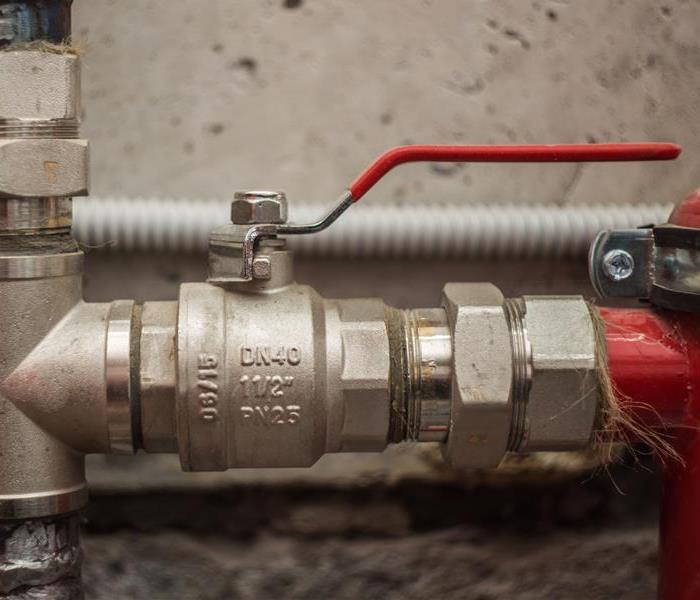 Knowing where, and how to shut off the main water supply in your home can help prevent against further damage.
Knowing where, and how to shut off the main water supply in your home can help prevent against further damage.
You already know time is of the essence when it comes to dealing with water damage, but do you know how you can limit further damage immediately when you discover a burst pipe or overflowing toilet? That’s right, by knowing where your water shut off valve is you can help limit any further damage in your home. In order to start the water mitigation process, the source of the water needs to be stopped. We recommend tagging your water shut off valve so that anyone in the home can easily spot it, and turn it off.
It is important to know how to locate and operate all shut off valves in the home, this include the toilet supply lines, shut offs for sinks and appliances. If you ever notice one of these leaking, shut the water supply off immediately. After calling the professionals at SERVPRO of West Seneca/Lancaster you can begin mopping up excess water. This will also help to limit the damage. Once our team arrives onsite, you just need to sit back while we make it, “Like it never even happened."
We Offer In House Textile Restoration Too
7/10/2019 (Permalink)
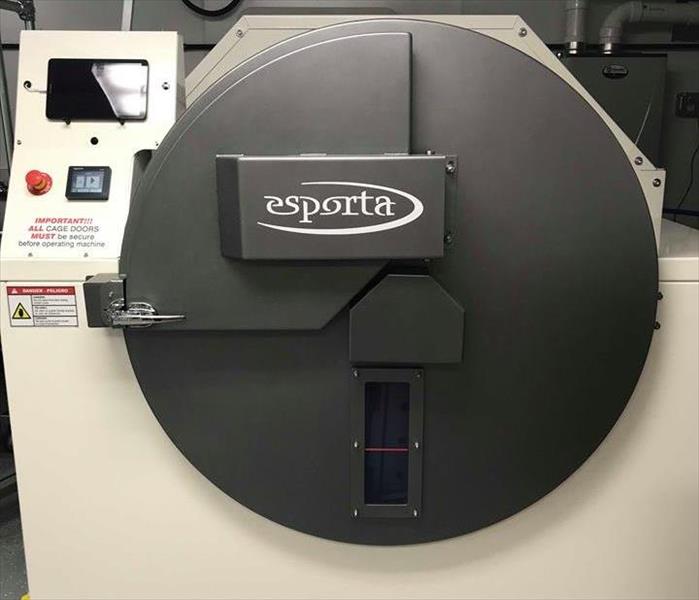 We can now clean up to 90% of the soft goods in your home after a water loss!
We can now clean up to 90% of the soft goods in your home after a water loss!
The days following a water loss can be stressful and overwhelming. Looking at all of the personal items that were affected can send anyone into a panic. You already know SERVPRO of West Seneca/Lancaster can handle the mitigation and cleanup of your home, but we are excited to announce that we can now clean and restore the soft goods and textile in your home as well!
In fact, we can restore up to 90% of the soft goods and textiles in the home. That’s nearly twice the amount a restoration drycleaner can! AND, we can restore and clean them in as little as 48 hours. That means your life is put back together even faster.
So what do we mean by soft goods and textiles? SERVPRO of West Seneca/Lancaster can now restore and clean items such as:
- Soft contents such as stuffed animals
- Sports equipment
- Laundry
- Shoes
- Handbags
- Leather items
- Curtains
- And so much MORE
We can clean and restore all these items and more that have been affected by Category 2 & 3 water, mold and bio contamination. This means you have just one point of contact throughout the entire claim process. So if you experience a water loss call the professionals at SERVPRO of West Seneca/Lancaster at (716) 674-1103 and let us make it, “Like it never even happened."
Time Matters When It Comes To Water Damage
7/8/2019 (Permalink)
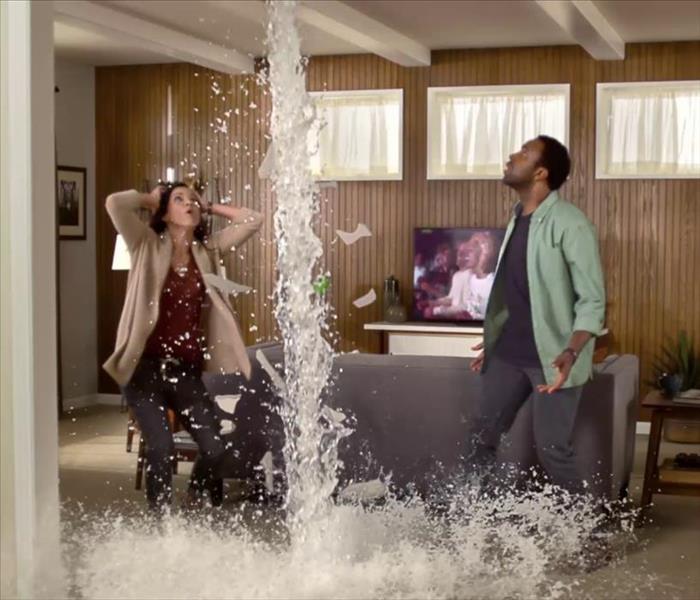 Time matters when it comes to water damage. Don't delay in contacting SERVPRO of West Seneca/Lancaster to begin the mitigation process immediately.
Time matters when it comes to water damage. Don't delay in contacting SERVPRO of West Seneca/Lancaster to begin the mitigation process immediately.
Water damage can happen at any time, any day. That is why SERVPRO of West Seneca/Lancaster is available to help you 27/7, 365 days of the year. We know that once water damage occurs, time matters. Within two hours of your call to our office, someone will be onsite to begin assessing the damage and begin mitigation work if needed. We always have crew on call, ready to assist you with any kind of water damage.
Time matters when it comes to a water loss because within minutes water quickly spreads throughout your property, saturating everything in its path. The water will be absorbed into everything such as walls, floors, upholstery and even your belongings. That water can cause your furniture finishes to bleed, causing permanent staining on carpets and floors. Your priceless photos, book and other paper goods will begin to warp.
Between 24 to 48 hours after the initial loss drywall begins to swell and break down, metal surfaces begin to tarnish and furniture begins to swell and crack. The dyes and inks from cloth and paper goods begin to spread and stain the surface they are on. You may begin to notice a musty odor forming and lingering.
Within just a week mold and mildew will begin to grow and spread. You may notice doors, windows and studs swelling and warping. Metal surfaces will begin to rust and corrode. Paint will begin to blister and wood flooring begins to swell and warp. Your home may now be at a serious risk for a biohazard contamination.
After a week has passed restoration time and cost will increase dramatically, and replacing contaminated belonging and rebuilding of the structure may be extensive. The structural safety, mold growth and biohazard contaminants pose a serious risk to any occupants living in the home. So if there is any water damage in your home, call the experts at SERVPRO of West Seneca/Lancaster right away! Someone from our office is always available at (716) 674-1103 and are “Here to help”.
Right Product, Right Equipment: Water Edition
7/8/2019 (Permalink)
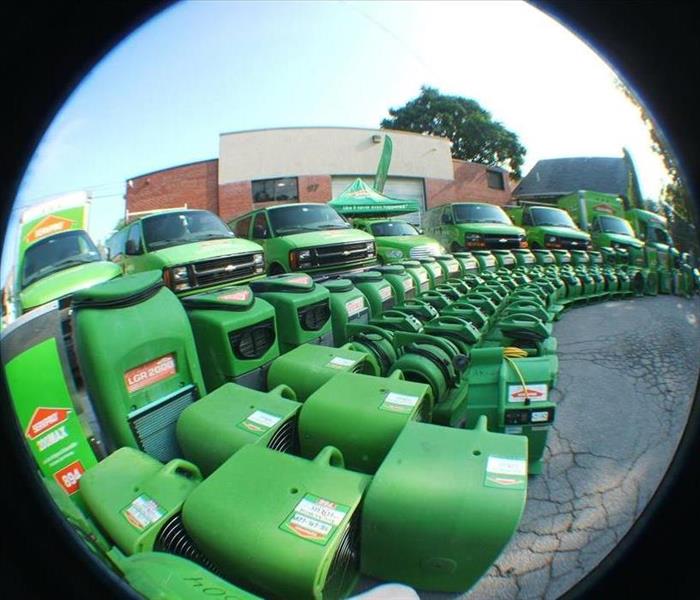 Choose the company with the right equipment and products to make water damage, "Like it never even happened."
Choose the company with the right equipment and products to make water damage, "Like it never even happened."
Having the proper training, equipment and product is key when it comes to restoring water damage. And, here at SERVPRO of West Seneca/Lancaster we have it all! Our technicians are IICRC Certified and go through extensive training so they are prepared to handle any disaster that may arise. They are always on call 24/7 because we know water damage doesn’t always happen during regular business hours. Our professional technicians are trained on how to explain the extent of the damage to our customers in a way that doesn’t sound like a foreign language, and how to show empathy and compassion during this stressful time in the customer’s life.
SERVPRO of West Seneca/Lancaster has all the right equipment to make sure the job is done right the first time. Simply extracting the visible standing water is not enough when it comes to water damage. Water can spread into any porous material (including wood, cardboard and carpet) can cause severe secondary damage if not properly dried and cleaned. That is why we use special air moves, water meter detectors (invasive and non-invasive) and commercial grade dehumidifiers to ensure that every surface in the home is properly dried. Our thermal infrared camera can see water damage not visible to the naked eye, so no damage goes unnoticed.
Using the correct product is another key part between restoring and replacing. All of our products are formulated by our in-house chemist at SERVPRO Headquarters. We have over 150 individual products that are specifically formulated to get the job done right. Each one of our products comes with an MDS sheet so that you know exactly what compounds are in them to avoid any allergens. Also, we have a complete line of natural and sustainable products, giving a whole new meaning to “the green team”.
All of these reasons make SERVPRO of West Seneca/Lancaster the best choice when it comes to restoring your water damaged home or business. Give us a call at (716) 674-1103 if you have any questions. We’re always, “Here to help”.
Fire Damage Do's and Don'ts
7/8/2019 (Permalink)
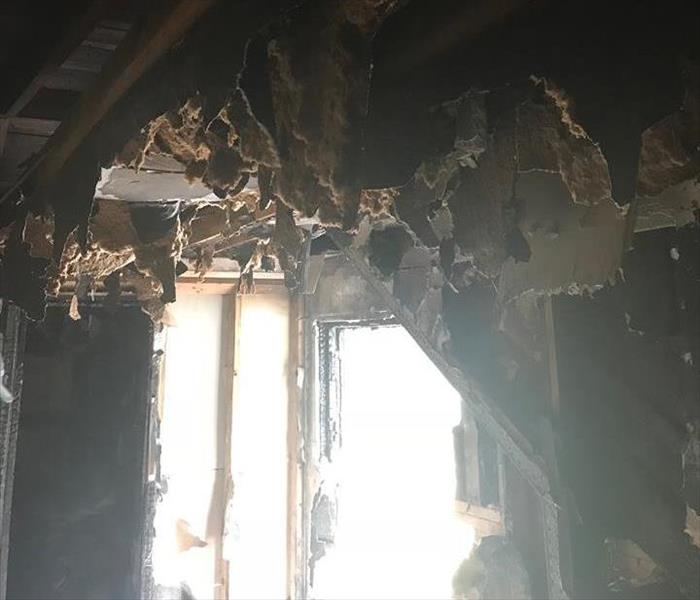 Be sure to know the do's and don'ts of fire damage!
Be sure to know the do's and don'ts of fire damage!
Suffering a fire can be one of the most devastating events a person can go through. It is not uncommon for our customers to want to feel some sort of normalcy immediately following the fire. And, while we completely understand this urge, there are some things you should NEVER do following a fire. Some of things include:
- NEVER attempt to was any walls or painted surfaces without contacting your SERVPRO professional first.
- NEVER attempt to shampoo carpets or upholstered furniture.
- NEVER attempt to clean any electrical appliances, TV sets, radios, etc. that may have been close to fire, heat or water.
- NEVER use any canned or packaged food or beverages that may have been stored close to fire, heat or water. They may be contaminated.
- NEVER turn on ceiling fixtures if ceiling is wet. Wiring may be wet or damage.
- NEVER send out any garments that suffered smoke damage to an ordinary dry cleaner. Improper cleaning may set in smoke order or damage them.
It is important to never try to clean smoke or soot damaged items yourself, as using the wrong product on them may further damage them. We understand the urge to need to start the cleaning process following a fire, so we recommend the following:
- DO limit movement in the home to prevent soot particles from being embedded into upholstery and carpets.
- DO keep hands clean. Soot on hands can further ruin upholstery, walls and woodwork. We recommend wearing disposable gloves.
- DO blow or brush vacuum loose soot particles from upholstery, drapes and carpets.
- DO place old towels or liners on rugs, upholstery and carpet traffic areas.
- DO empty freezer and refrigerator completely and prop doors open if the electricity is off.
- DO clean and protect chrome on kitchen and bathroom faucets, trim and appliances with a light coating of Vaseline or oil.
- DO wash house plants on both sides of leaves.
- DO change the HVAC filter.
- DO tape double layers of cheesecloth over air registers.
And the MOST important thing you should do if you suffer a fire is call the experts at SERVPRO of West Seneca/Lancaster once you and your family is out safely and your property is secured. Someone from our office is available 24/7 at (716) 674-1103 to assist you and help make this devastating time, “Like it never even happened."
Multiple Types of Soot, Oh My!
7/8/2019 (Permalink)
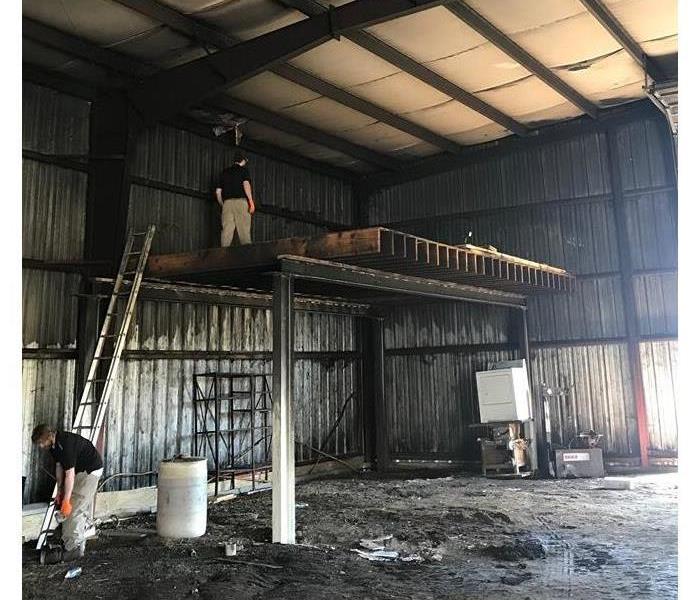 Different types of soot require different cleaning methods. It is important to know and understand them before attempting to clean up after a fire.
Different types of soot require different cleaning methods. It is important to know and understand them before attempting to clean up after a fire.
Did you know there are several types of soot? It’s true, that is why it is so important to never try to clean up after a fire yourself. Each type of soot requires a different cleaning process and product. There are actually 5 different types of soot. They are:
- Wet Smoke- Wet smoke residues result from water being used to extinguish the fire from either the fire department, a sprinkler system or from smoldering fires with low heat. These residues are smeary and have a pungent smoky/musty odor. They usually require wet cleaning to be removed.
- Dry Smoke- Dry smoke residues result from a fire source that is more combustible or fast burning such as wood and burns at higher temperatures. These residues can also be caused with a furnace puff back. They are often dry, powdery and are small, non-smeary smoke particles that require a dry cleaning process BEFORE wet cleaning. They are the easiest to remove.
- Oily Smoke- Oily smoke residues result from grease fires, burned plastic and fuel oil furnace backups. Also, this type of soot can be from heavy nicotine build up before the fire damage even occurred. This type of soot is smeary, and usually requires additional cleaning steps to remove. Oily soot is resistant to water based cleaning.
- Protein Soot- This type of soot results from burned meat or eggs, such as cooking a chicken on the stove overnight. The residue is virtually invisible and can penetrate into all surfaces such as paints, floor coverings, wood and plastics. This type of soot has an extremely pungent odor, and it is the most difficult odor to eliminate.
- Other Types of Residues- Other types of residues that need to be cleaned properly include tear gas, fingerprint powder, pepper spray and fire extinguisher residues.
As you can see, each one of these types of soot requires a different cleaning method and product. So let SERVPRO of West Seneca/Lancaster take the guessing work out of cleaning after a fire. Our trained and professional technicians have the tools and knowledge to decipher which type of soot is present, and which cleaning method is needed to make it, “Like it never even happened."
When Thunder Roars...
7/8/2019 (Permalink)
Tis the season for potentially damaging thunder and lightning storms in the WNY area. During these storms it is important to follow proper safety precautions to keep you and your family safe. According to Ready.gov, here are some helpful tips on what you should do during a thunder storm:
- When thunder roars, go indoors. A sturdy building is the safest place to be.
- Pay attention to weather reports and warnings of thunderstorms. Be ready to change plans if need be to somewhere indoors. Always have a backup plan.
- If inside, avoid using running water or landline phones. Electricity can run through plumbing phone lines.
- Unplug appliances and other electronic devices, and secure outdoor furniture.
- If boating or swimming, get to shore immediately and seek shelter in a sturdy building or vehicle.
- Avoid flooded roadways. Turn around, don’t drown! As little as six inches of moving water can knock you down. One foot of moving water can sweep your vehicle away.
Take the time to review these helpful tips, and stay safe this summer season. Also, thunder and lightning storms can be potentially dangerous to your home too. If your home is damaged in a thunder or lightning storm and suffers water damage as a result, call the experts at SERVPRO of West Seneca/Lancaster to come in, clean it up and make it, “Like it never even happened." Our office can be reached 24/7 at (716) 674-1103.
The Moments After A Water Loss...
7/3/2019 (Permalink)
 The moments after a water loss are crucial. Do not waste time in calling in a professional restoration company to being the mitigation process.
The moments after a water loss are crucial. Do not waste time in calling in a professional restoration company to being the mitigation process.
Did your home just suffer a loss due to a backed up sump-pump or burst pipe? What happens after a water loss can be crucial, and be the difference between restoring and replacing. In order to prevent any further damage in your home, here are some helpful tips:
- Remove as much excess water as possible by mopping and blotting.
- Wipe excess water from wood furniture after removal of laps and table top items.
- Remove and prop wet upholstery and pillow cushion for even drying.
- Place aluminum foil or wood blocks between furniture legs and wet carpeting.
- Turn air conditioning on for maximum drying in the summer.
- Oriental rugs or other colored rugs from wet wall-to-wall carpeting.
- Remove valuable paintings and art objects to a safe, dry place.
- Open and place luggage in sunlight to dry if possible.
- Gather loose items, toys, etc. from floors.
Remember, time is critical when it comes to water damage. So call SERVPRO of West Seneca/Lancaster immediately at (716) 674-1103 to begin mitigation work as soon as possible. After a water loss it is important to NEVER:
- Leave wet fabrics in place; dry as soon as possible. Hang furs and leather goods to dry separately at room temperature.
- Leave books, magazines or other colored items on wet carpets or floors.
- Use your household vacuum to remove water.
- Use TV or other household appliances while standing on wet carpet or floors (especially not on wet concrete floors).
- Turn on ceiling fixtures if ceiling is wet, and keep out of rooms where ceilings are sagging from retained water.
Also, be sure to bring a professional restoration company, like SERVPRO of West Seneca/Lancaster, in to make sure that everything is dried completely and properly. Leaving water damage over a period of time can cause many issues such as secondary damages and mold. So if you just had a water loss in your home call the professionals at SERVPRO of West Seneca/Lancaster a call at (716) 674-1103 today.
Don't Fall Into The Gaps
7/3/2019 (Permalink)
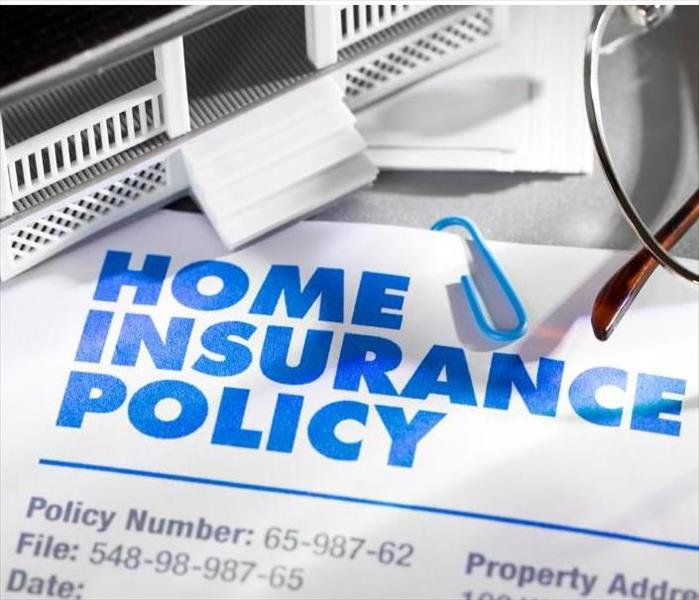 Be sure to review your homeowner's policy and rest easy knowing you have the appropriate coverage.
Be sure to review your homeowner's policy and rest easy knowing you have the appropriate coverage.
All too often we will receive a call from a customer who just suffered a water loss, and while they do have coverage from their insurance company, it is not enough to cover the damages and they are left paying the remaining balance out of their own pocket. Don’t fall into the gap!
While having this coverage on your homeowner’s policy is highly recommended, it is equally important to make sure you have the proper amount of coverage for your home. We generally see coverage for Water Back-up between 5-10 thousand dollars. And, while that may be enough for an unfinished basement, it is often times not enough for a finished one. After the demolition and mitigation work is completed, there may not be enough coverage left to clean the contents in the basement and complete the reconstruction work. What is the solution? Give your insurance agent a call and have them take a look at your current policy. Adjustments to this coverage can happen at any time, and may end up saving you thousands of dollars down the road.
We recommend asking yourself these questions when trying to assess how much coverage you need to protect your West Seneca/Lancaster home:
- Are there any furniture/rugs being stored or used in the basement?
- Do you have any valuables being stored in the basement?
- Are the contents in your basement stored in tots and off the floor?
- Are you planning on renovating the basement in the near future?
- Are there any special features built in the basement that you would want repaired in the event of a loss?
Be sure to communicate these answers to your insurance agent so together, you can determine how much coverage is appropriate. And, should you ever experience water damage in your home, be sure to call the experts at SERVPRO of West Seneca/Lancaster a call at (716) 674-1103 to make it, “Like it never even happened."




 24/7 Emergency Service
24/7 Emergency Service